Volume 24
HOW COSMOLOGICAL MODELS CONFRONT OBSERVATIONS
Editors: Rudy E. Schild, Carl H. Gibson, N. Chandra Wickramasinghe
September 2014 to June 2015 issue of Journal of Cosmology, Volume 24
The biological big bang with its cosmic, life infested, merging planets and water oceans 2 million years after the cosmological event is easy to explain by HGD cosmology (Gibson, Schild, Wickramasinghe 2011, Gibson 2000). Old cosmology based on cold dark matter makes life rare, localized, and grotesquely improbable (the odds for spontaneous life on Earth are about one in 10^6500 according to Wickramasinghe and Hoyle). Star formation from gas and dust rather than dark matter planet mergers is slow (300 Myr versus 0.03 Myr) as shown in Figure JC2014.24.2. New cosmology based on modern fluid mechanics makes life inevitable due to ~ 10^80, 3000 K hot, merging, hydrogen gas dark matter planets (Schild 1996) that first condense to form molten iron and rocky cores, followed by water vapor atmospheres and liquid oceans on cooling to 373 K (100 C). This Figure JC2014.24.1 is from Tokoro and Wickramasinghe's paper in this volume (24, No. 2). Organic chemistry and life processes evolve in the merging oceans. All of Guaguin's 1897 questions are still excellent and unanswered (CHG).
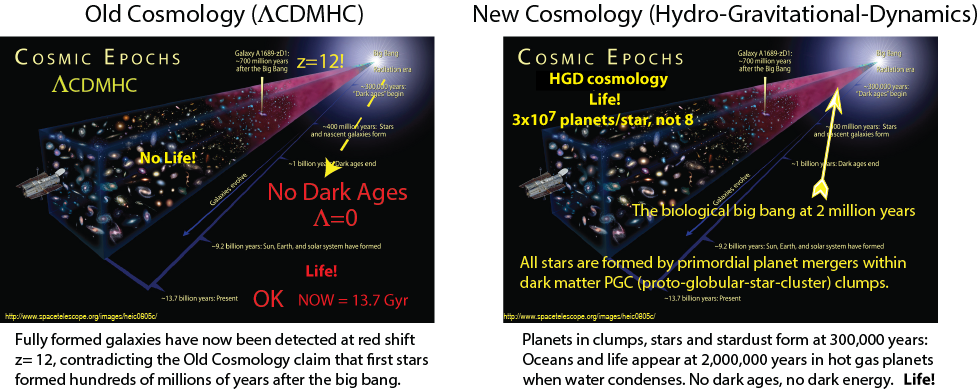
Figure JC2014.24.2 Cosmic Epochs contrast Cosmological Models LCDMHC (no life possible) versus HGD (early life spread everywhere).
This illustration JC2014.24.2 is modified from that in Volume 22 to emphasize that a key difference between LCDMHC and HGD cosmologies is the cosmos-wide distribution of life fostered by ~10^80 (10^104 kg) of HGD dark matter planets that collectively can evolve life with high probability at ~ 2 Myr as they form and merge their water oceans, and sprinkle the hot water oceans with star dust from supernovae (CHG).
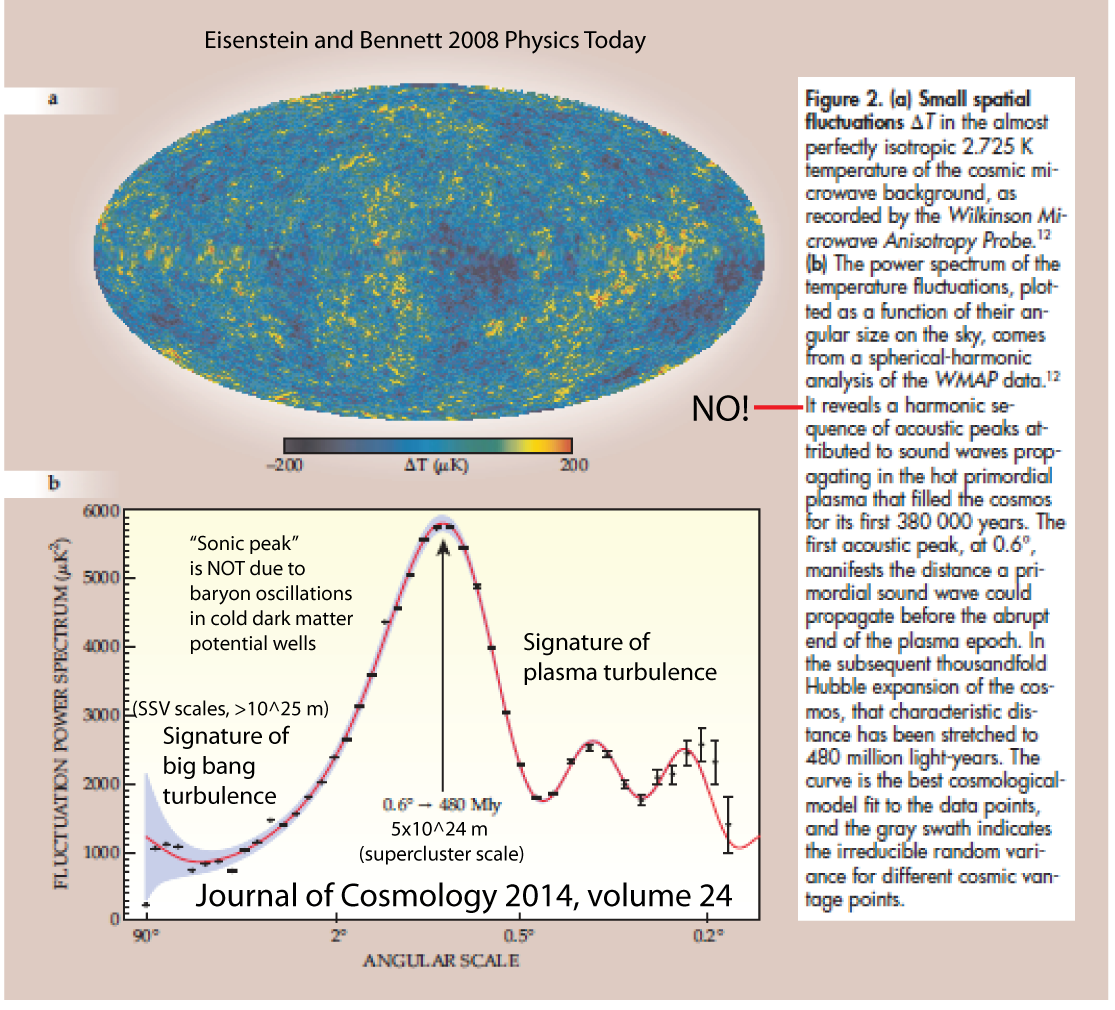
Figure JC2014.24.3 (CHG). Old Cosmology and New Cosmology interpretations of the "acoustic peaks". These are NOT acoustic peaks, but the signatures of big bang turbulence at SuperSuperVoid scales and plasma turbulence at SuperClusterVoid scales shown.

Figure JC2014.24.4 (CHG). Evolution of turbulence, fossil vorticity turbulence, and mass-energy density in the universe, Gibson (2004, 2005). The first turbulence is shown by the solid double arrows on the left at Planck conditions, starting at Planck time 10^-43 seconds, and cascading from 10^-35 meters to 10^-27 meters at time 10^-33 seconds,when the turbulence is fossilized by gluon viscous forces as the first quarks form. Fossil vorticity turbulence is indicated by dashed double arrows. A turbulent boundary layer of protogalaxies at supercluster scales forms starting at the time of first plasma fragmentation 10^12 s at the density minima induced by fossil big bang turbulence vortex lines. The density at first fragmentation of the plasma rho_0 contradicts the existence of massive stars. The Oort cavity sizes in regions of rapid star formation are too small fo the r thousands of O stars observed, also to be super massive. pp 12672-12673.
CONTENTS
I. COMETARY PANSPERMIA & ASTROBIOLOGY
1. Life as a Cosmic Phenomenon: 1. The Socio-Economic Control of a Scientific Paradigm, N.Chandra Wickramasinghe and Gensuke Tokoro, preprint of paper submitted to Journal of Astrobiology and Outreach, pp 12000-12018
2. Life as a Cosmic Phenomenon: 2. The Panspermic Trajectory of Homo Sapiens, preprint of paper submitted to Journal of Astrobiology and Outreach, Gensuke Tokoro and N. Chandra Wickramasinghe, pp 12019-12031
3. Comet 67P/Churyumov-Gerasimenko and Cometary Biology, preprint of paper submitted to Journal of Astrobiology and Outreach, N. Chandra Wickramasinghe, pp 12032-12036
4. The Cosmic Web and Microwave Background Fossilize the First Turbulent Combustion, Carl H. Gibson and R. Norris Keeler, presentation at Tallinn, Estonia, IAU 308 Symposium, June 23-28, 2014, pp 12036-12074. Summary report for Proceedings, Latex source flle. Iau cls file. Latex pdf file , pp 12075-12076.
Movie of presentation.Binder1-small posted on youtube by Carl H. Gibson. Freshman seminar on New Cosmology by Carl H. Gibson, Fall 2014, SIO 87, University of California at San Diego. 4.1. Gibson arXiv.com papers about New Cosmology, pp 12077-12085. Word version of the pdf file.
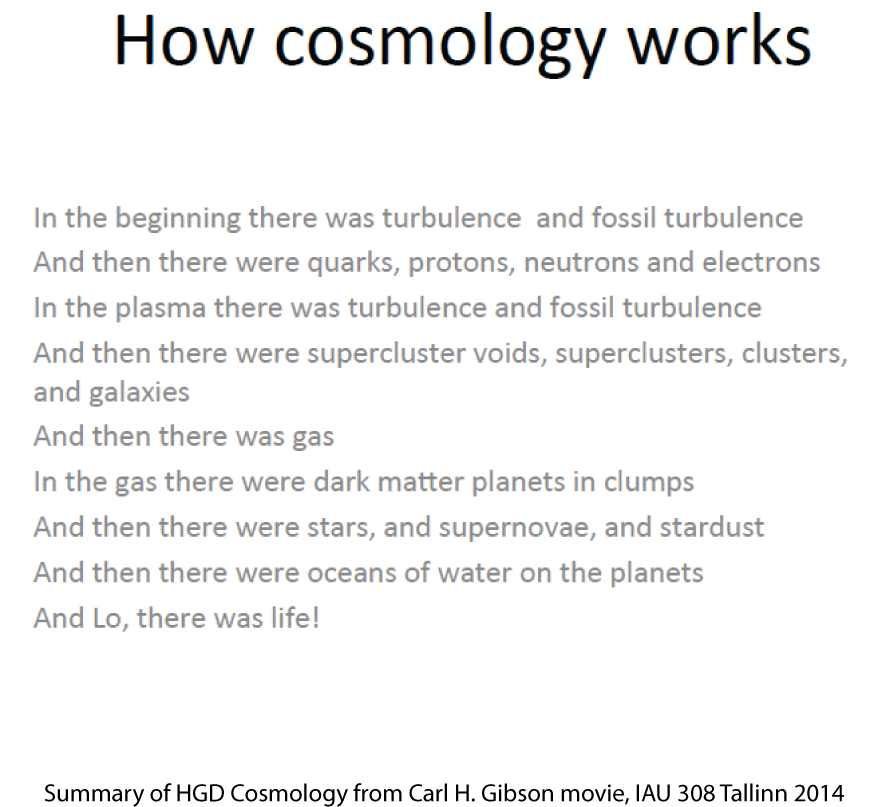
Figure JC2014.24.3: Summary of hydro-gravitational-dynamics (HGD) cosmology scenario leading to the formations of dark matter planets, stars, star dust, water oceans, and RNA-DNA life on cosmic scales (CHG).
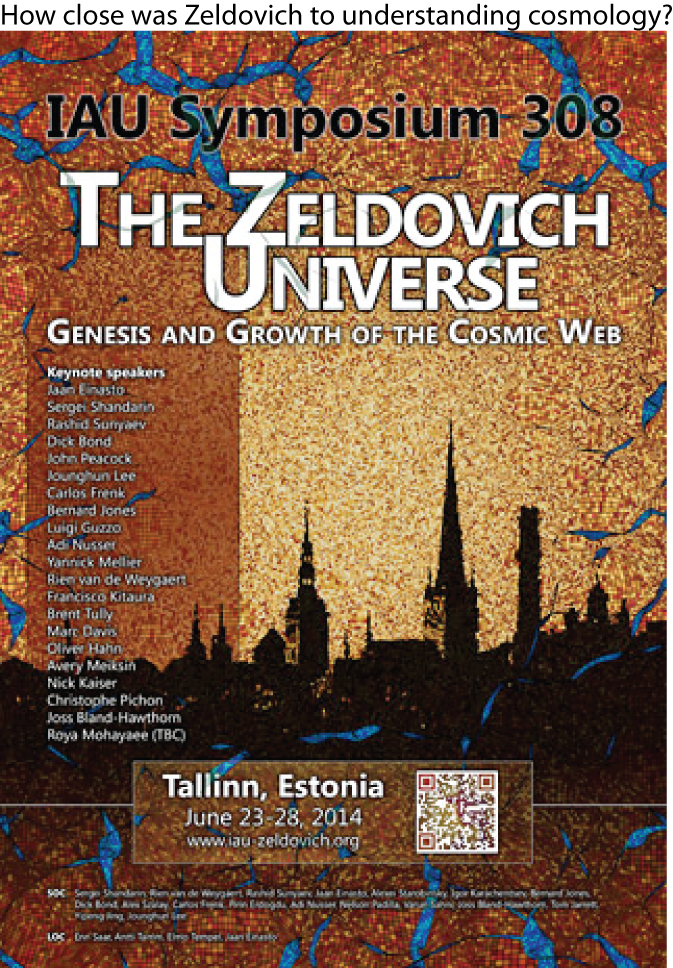
Figure JC2014.24.4.1, IAU 308 Symposium (CHG) considers the contributions of Y.B. Zeldovich, and his many admirers, to the development of cosmology.
Editorial Note 4.1(CHG): This (Gibson and Keeler, The Cosmic Web and Microwave Background Fossilize the First Turbulent Combustion) was the only paper presented at the Symposium that considered possible effects of turbulence, fossil turbulence, and collisional fluid mechanics on cosmology, other than the paper of Dr. Rudolph E. Schild ("Detection and the Origin of the Baryonic Dark Matter", June 27) about gravitational structure formation and the formation of dark matter planets by gravity, kinematic viscosity and weak turbulence.The dark matter planets were first detected and claimed as the missing mass of galaxies by Schild (1996). Neither was there any discussion of Astrobiology or the formation of life. The erroneous timeline of "Old Cosmology" shown on the left in the illustration above (JC2014.24.02), was displayed several times by various speakers at IAU 308. An improved timeline has been provided by the Bicep III collaboration based on polarization of CMB light by fossil big bang turbulence spin. Dark matter planets detected by Schild (1996) appear in this figure at 380,000 years plus 30,000 years. Turbulence and kinematic viscosity effects cannot be neglected. Water oceans condense on many of the 10^80 big bang planets in this timeline at 2 million years, and will freeze at 8 million years (the time of the biological big bang). Life among so many planets will be formed and widely spread throughout the cosmos by Hoyle-Wickramasinghe cometary panspermia. Because stars formed so early by (hot and bright) dark matter planet mergers (0.3 Myr at > 3 kK), it seems likely that life in the cosmos will be based on DNA and distributed homogeneously.
5. Zeldovich and the Missing Baryons, Results from Gravitational Lensing, Rudolph E. Schild, Summary Report for Proceedings of iau 308, pp 12077-12079. Gibson (2001) reference.
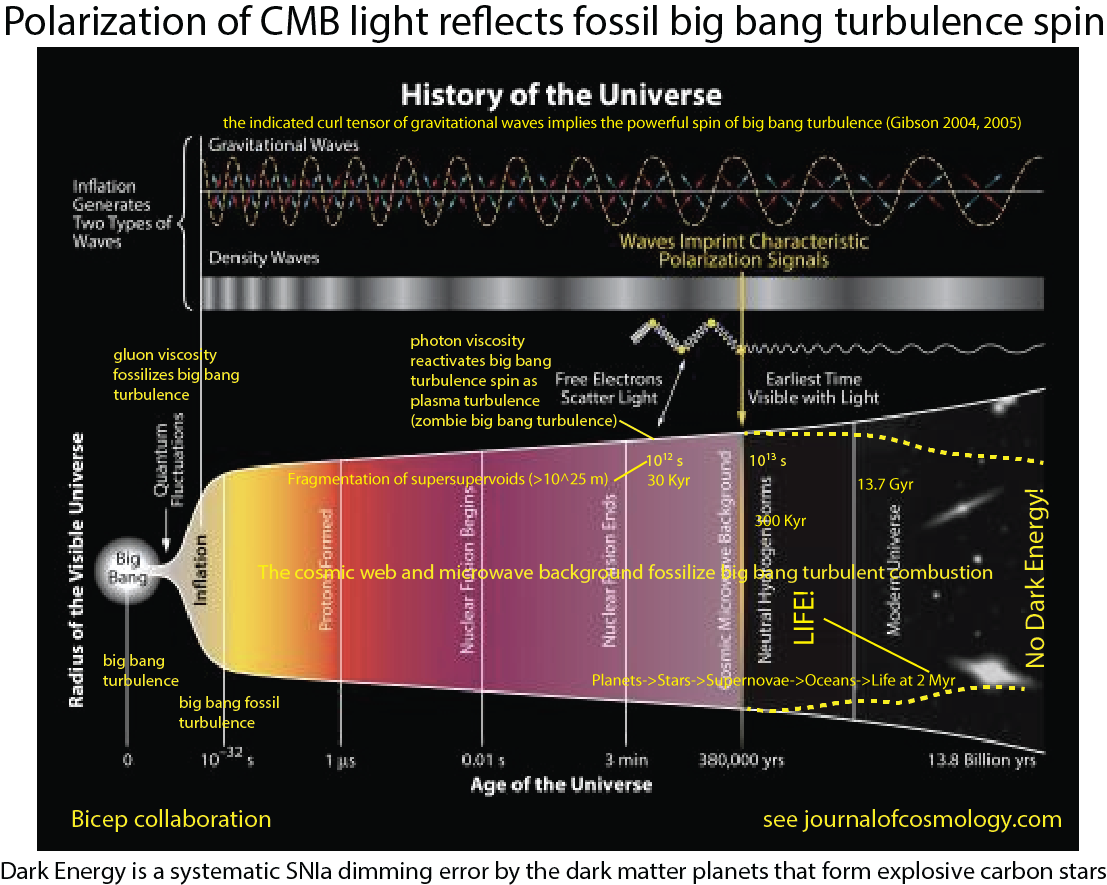
Figure JC2014.24.4.2 BICEP 3 (CHG): modifies the BICEP 2 collaboration time-line according to HGD cosmology. The tentative evidence from the Bicep collaboration of a curl tensor in gravitational waves supports the Big Bang Turbulence origin of HGD cosmology. Gluon viscous stresses damp and fossilize the turbulence between 10^-32 and 10^-27 seconds. The rapid spin (10^43 radians/second) and enormous gravitational accelerations (10^60 g) of Planck-Kerr turbulent combustion at Planck temperatures 10^32 K (Gibson 2004, 2005) imprint characteristic polarization signals, as shown in the figure JC2014.24.4.2. The October 2014 Issue of Scientific American calls it "A Beacon from the Big Bang", L.M. Krauss, pages 60-67.
The subject of the IAU 308 Symposium was Zeldovich and the Cosmic Web. Over a hundred papers were presented to explore possible connections. The unmentioned elephant in the room during the conference was the possibility that the standard LCDMHC cosmology could be wrong. What if cold dark matter does not exist? What if the dark matter of galaxies is mostly baryonic in the form of earth-mass planets of frozen hydrogen? What if collisional fluid mechanics and turbulence dominates the big bang and the early formation of structures? What if gravitational forces permit fragmentation of the expanding universe at only 30,000 years, early in the plasma epoch, as claimed by Gibson (1996)?
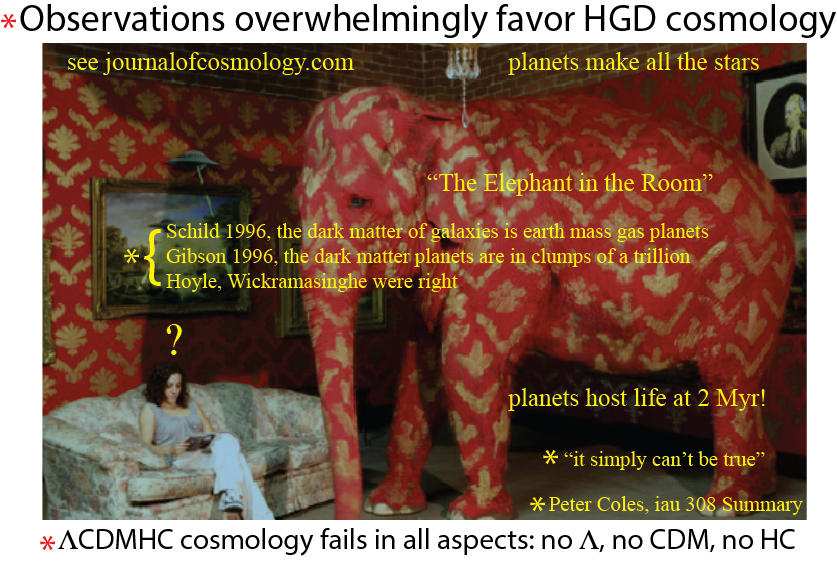
JC2014.24.4.3 (CHG): Peter Coles IAU 308 Summary shows a young cosmologist contemplating observations and cosmological models where critical evidence is obviously being suppressed.
What evidence and observations are being suppressed or ignored? Evidence from two decades of careful observations since Schild (1996) and Gibson (1996) show that the dark matter of all galaxies is earth-mass hydrogen planets in proto-globular-star-cluster clumps. For example, the Planck collaboration is able to measure temperatures in the near-by Andromeda galaxy as a function of distance from the galaxy center that is strong evidence of plasma epoch proto-galaxies and present epoch hydrogen dark matter planets.
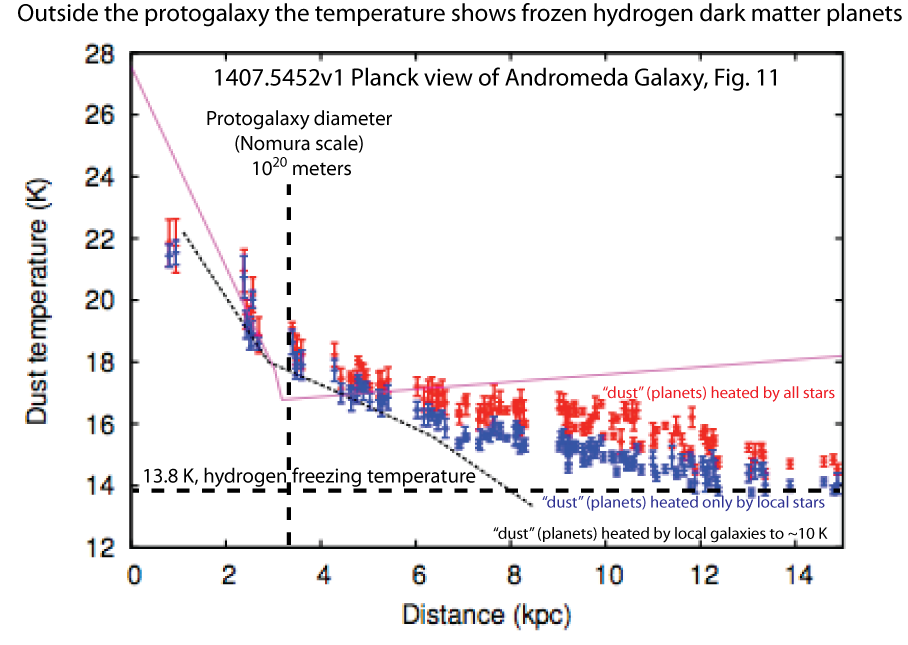
JC2014.24.4.4 (CHG): Temperatures in Andromeda galaxy (M31) begin to fall with radius at the Nomura scale boundary of the proto-galaxy (10^20 meters) toward a plateau near the triple point of hydrogen (13.8 K). Such a thermostat effect suggests the "dust" is dark matter planets of frozen hydrogen that evaporate as they merge to form larger planets and stars. The region shown is 10% of the full galaxy, which is heated to ~ 10 K by local galaxies and cooled by radiation to outer space at 2.7 K. A similar temperature profile exists for the Milky Way, as expected from HGD cosmology but not by LCDMHC cosmology where the termperature profile is a mystery.
Another important class of observation that falsifies LCDMHC and supports HGD cosmology is evidence of supersupervoids; that is, completely empty regions about ten times larger than superclustervoids. Superclustervoids are not empty and are on the same scale as superclusters of about a thousand galaxies, generally taken to be 30 Mpc or ~ 10^24 meters. SuperSupervoid sizes may exceed 300 Mpc, or ~10^25 meter. They appear to be quite empty! From HGD cosmology, they should be empty. SuperSupervoids reflect the first fragmention of the plasma epoch, triggered by fossil turbulence vortex lines of big bang turbulence and starting at 30,000 years when photon viscous forces match the horizon scale ct (3x10^20 meters). The empty voids with spinning turbulent boundary layers expand as rarefaction waves at speeds limited by the speed of sound c/3^0.5 until the plasma to gas transition at 300,000 yrs (10^13 seconds). Superclusters and superclustervoids reflect the maximum turbulence scale of the boundary layers, presently ~ 10^24 m, and should not be empty. Galaxies are the smallest scale fragments of the plasma epoch. No mechanism of LCDMHC can account for 10^25 meter voids. The key movie showing that the observed supersupervoid is empty does not appear on the SDSS-III website. This is surprising (if you believe LCDMHC), suggesting the SDSS collaboration is biased to protect LCDMHC cosmology from falsification by empty SuperSupervoids. A key part of SDSS-III is the Baryon Oscillation Spectroscopic Oscillation (BOSS) study, clearly revealing the study is biased, since no baryon oscillations exist if no cold dark matter condensations exist and no CDM halos exist.
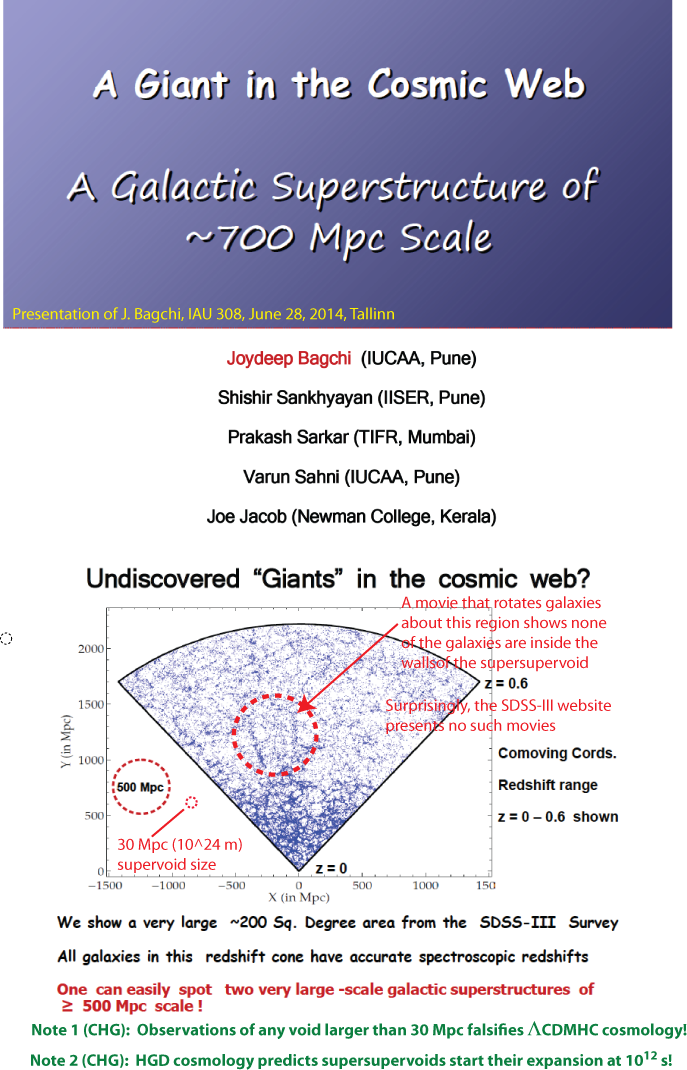
JC2014.24.4.5 (CHG): SuperSuperVoids (completely empty regions on scales > 10^25 m) are easy to understand from HGD cosmology. Density minima from fossil big bang turbulence vortices trigger fragmentation of the plasma at 30,000 years (10^12 s). These expand as rarefaction waves limited by the plasma sound speed, which is light-speed c divided by 3^0.5 (~1.7 x 10^8 m/s).
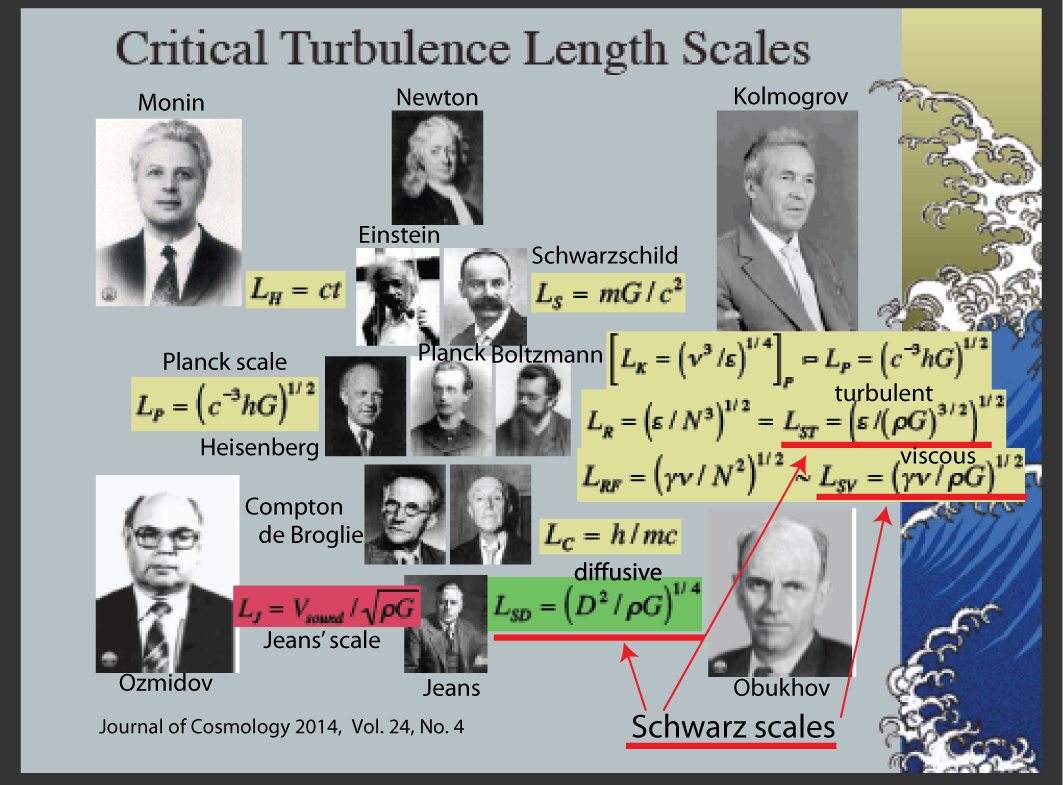
JC2014.24.4.6 (CHG): Critical turbulence, viscous and diffusive length scales, developed for the stratified ocean, are extrapolated to cosmology and astrophysics by HGD cosmology. These are termed Schwarz scales to honor the memory of Professor William Herman Schwarz (Carl Gibson's PhD advisor at Stanford University) who died prematurely of cancer (April 7, 1995) at the time of their derivation. They cannot be derived by linear perturbation stability analysis (as incorrectly suggested by the ApJ Scientific Editor Ned Wright Review). Only the Jeans' scale is used by LCDMHC. The Schwarz diffusive scale measures the large diffusive size of non-baryonic dark matter galaxy halos that form with large diffusivity D. The dark matter of galaxies is 97% baryonic because the weakly collisional non-baryonic dark matter, that includes neutrinos, has enormous diffusivity compared to baryons like hydrogen and helium.
Note regarding LCDMHC: Relativity by Albert Einstein (Fifteenth Edition 1952) Appendix IV pp 134-135: "My (Einstein's) original considerations on the subject were based on two hypotheses: (1) There exists an average density of matter in the whole of space which is everwhere the same and different from zero. (2) The magnitude ("radius") of space is independent of time. Both of these hypotheses proved to be consistent, according to the general theory of relativity, but only after a hypothetical term was added to the field equations, a term which was not required by the theory as such nor did it seem natural from a theoretical point of view ("cosmological term of the field equations"). Hypothesis (2) appeared unavoidable to me at the time, since I thought one would get into bottomless speculations if one departed from it." Cold dark matter, the cosmological constant, hierarchical clustering of CDM halos, and dark energy (Gibson and Schild 2011) are examples of such bottomless speculations. Modern observations and fluid mechanics have rendered these LCDMHC concepts obsolete, along with the static cosmology of Einstein (CHG).
JC2014.24.4.7. (CHG): What is the missing non-baryonic dark matter required to drive the big crunch? About thirty times or more NBDM than BDM is required by HGD cosmology to produce a closed universe without dark energy. One candidate is the Higgs boson, lots of which would be produced by big bang turbulence. The Higgs has a measured mass of about 100 protons.
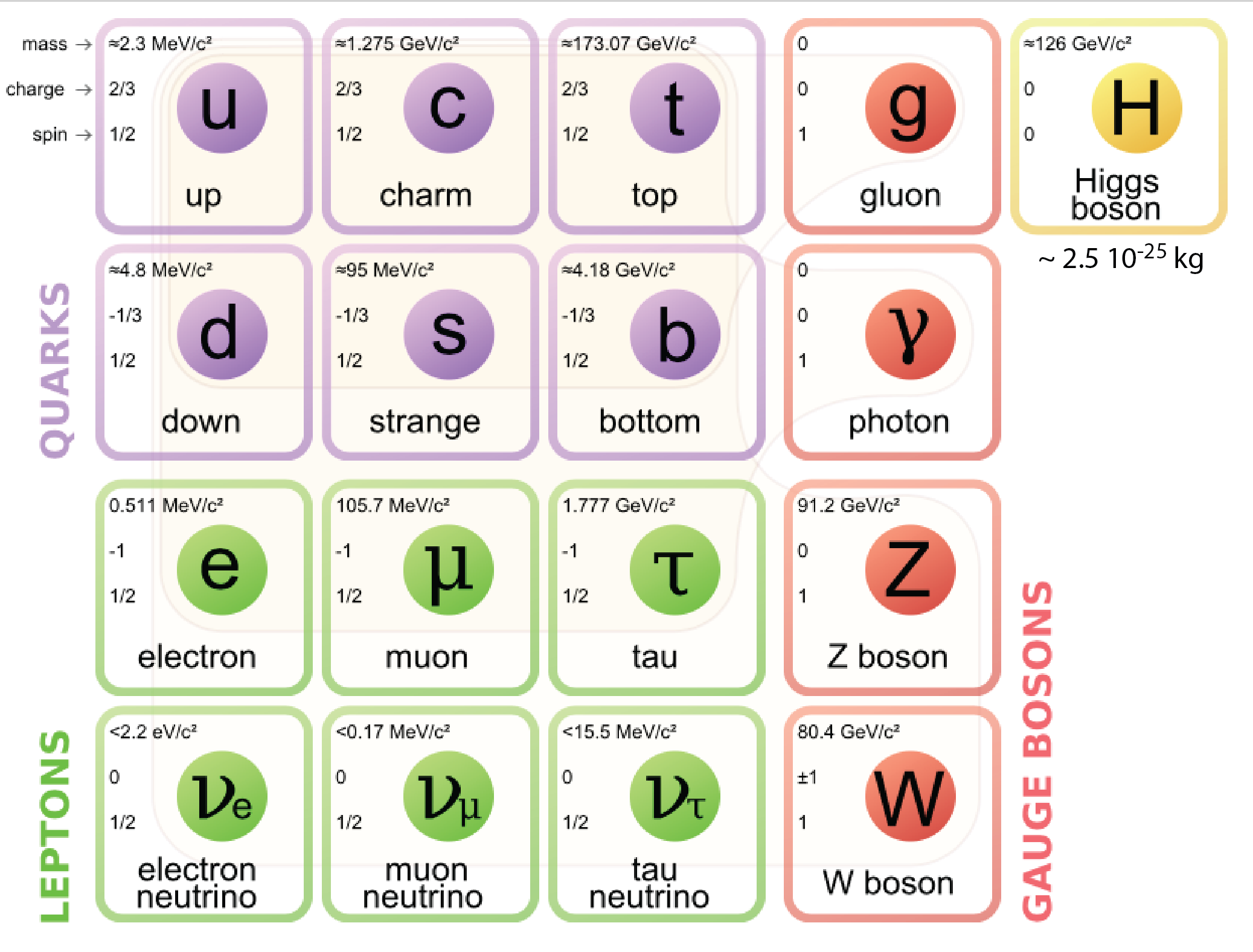
JC2014.24.4.8. (CHG): Massive particles from the hadron epoch (~10^-33 to ~10^-27 s) such as gluon oddballs (~ proton mass) may also be important to the generation of NBDM. The appearance of quarks and gluons marks the end of big bang turbulence with small kinematic viscosity (~10^-27 m^2 s^-1) and large Reynolds numbers. From the Cong-Feng Qiao and Liang-Tang PRL paper, "Finding the O^-- Glueball", the gluon viscosity is much larger, reflecting proton length scales (~ 10^15 larger than Planck scales). Huge viscous and color forces constrain big bang turbulence during inflation. The oddball is a gluon triplet hadron containing only gluons, but with proton mass (10^-27 kg) in this metastable molecular form.
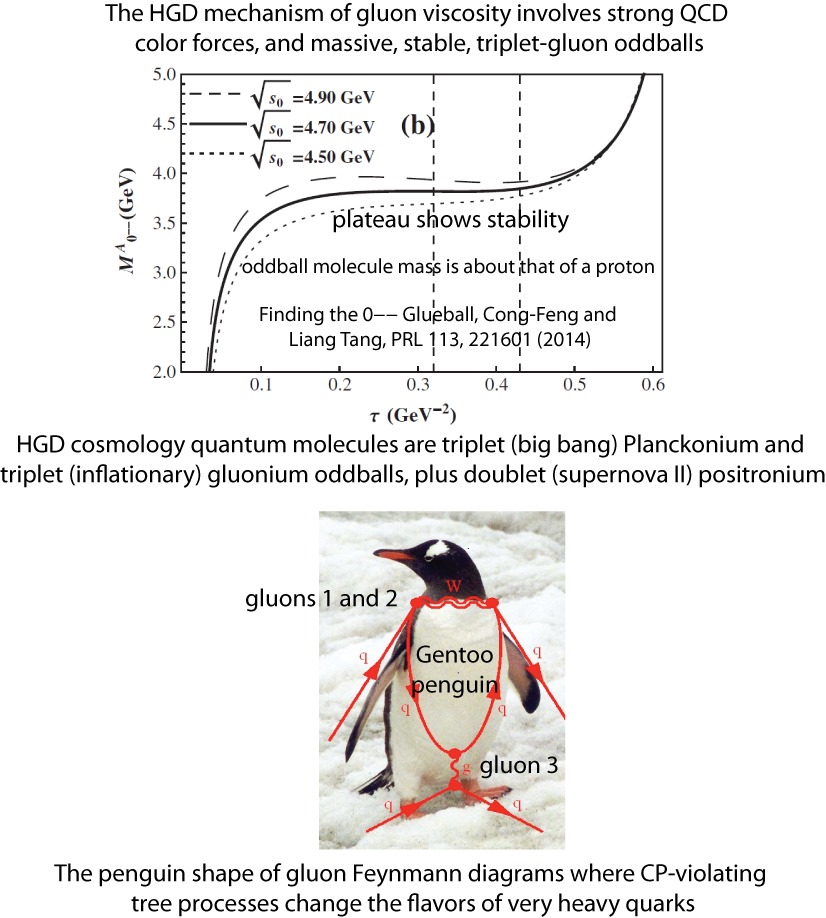
Planck, Higgs, and gluon particles all seem to arrange themselves in spinning doublet and triplet molecules as they form gravitational structures under big bang conditions.
Note regarding the Continuum Hypothesis: Most of the failures of LCDMHC cosmology are the result of the false assumption that astrophysics and cosmology can be adequately described by collisionless fluid mechanics. They can't. Starting with Planck particles and antiparticles of the big bang at Planck conditions, the continuum hypothesis of fluid mechanics is of crucial importance (Frank M. White, Fluid Mechanics, Third Edition, page 4), even though it is an open question in set theory. As shown previously in this Journal, dark matter planets (aka primordial fog particles PFPs), and even the Jeans mass (million solar mass) proto-globular-star-cluster (PGC) clumps of dark matter planets that fragment at the plasma to gas transition, can serve as fluid particles as described by the fluid mechanical continuum hypothesis. Galaxies themselves (the smallest particles fragmenting during the plasma epoch) serve as collisional fluid particles for the "dark flow" phenomenon, where x-ray galaxies are observed to converge on the "axis of evil" CMB cold spot.

JC2014.24.4.9: Basic fluid mechanical principles such as the continuum hypothesis apply to terrestrial as well as astrophysical fluids despite a vast difference in the range of scales. In the ocean and atmosphere microscopic uncertainty scales may be 10^-3 m and macroscopic (energy) scales 10^5 m. The Kolmogorov, Batchelor, and Obukhov scales of the flow determine the extent of the constant volume average plateau that extends to the Obukhov (energy) scale of the fluctuations of velocity or scalar variance where fossilization of the turbulence and macroscopic uncertainties begin. The Planck scale and the Kolmogorov scale coincide for big bang turbulence (L_P = L_K ~ [c^-3 h G]^0.5). The Nomura scale of protogalaxies (10^20 m) matches the Kolmogorov scale because the plasma epoch turbulence is so weak. The Oort cavity scale of carbon star formation is ~ 10^16 meters ~ (10^31 kg / 10^-17 kg m^-3)^1/3 , and reflects the density of first fragmentation in the plasma epoch and the mass of the white dwarf binary stars formed by dark matter planet mergers within proto-globular-star-cluster clumps (CHG).
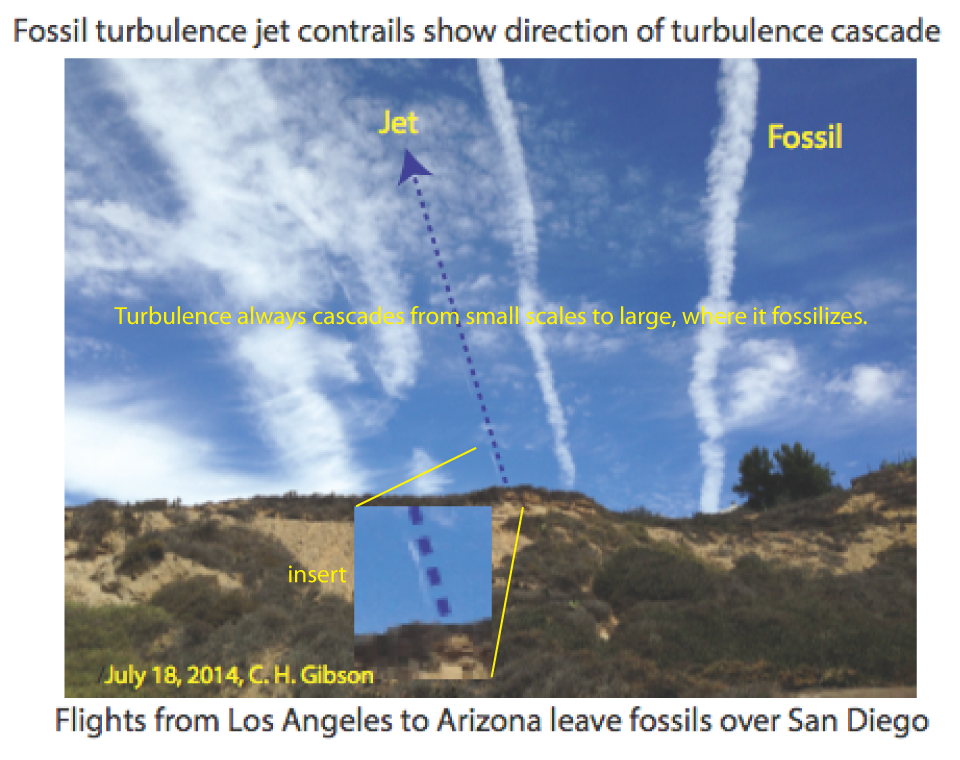
JC2014.24.4.10 (CHG): Aircraft jet contrails show fossils of previous turbulence. Note that the fossil turbulence jet contrails are much larger than the actively turbulent contrails of an observed jet (insert) because turbulence always cascades from small scales to large, contrary to the standard model.
It is necessary for cosmology and astrophysics to abandon the collisionless Boltzmann equation (aka Vlasov equation, Fokker-Planck-Kolmogorov equation) in favor of HGD cosmology inclusion of basic concepts of collisional fluid mechanics and modern turbulence. Note that the leading sentence in this 1997 PRL paper (Friedrich and Peinke, 78,5,863-866) is "Fully developed turbulence is still regarded to be one of the main unsolved problems of classical physics". It is now solved in the sense that a simple definition has been proposed and verified (eg: by the harbor seal shown that uses its whiskers to track fossil vorticity turbulence of toy submarines without sight or sound), the direction of the turbulent kinetic energy cascade has been corrected, and various universal (Kolmogorov, Batchelor, Obukhov, Corrsin, Gibson) similarity hypotheses have been given a physical basis (CHG).

JC2014.24.4.11 (CHG): Observations show it is time to revise the standard models of oceanography and cosmology (Reprints of two heretical papers rejected by JGR and ApJ were published in Volume 1 of the Iranian Journal of Applied Fluid Mechanics in 2008 even though they question Old Fluid Mechanics and Old Cosmology standard models). The 300 Mpc (10^25 m) SuperSuperVoid (SSV) described in Fig. 5 of Gibson and Schild (2010 b) from Rudnick et al. (2007) is corroborated by Joydeep Bagchi and his colleagues (2014) in JC2014.24.4.5 above. These SSVs falsify LCDMHC, and support the HGD prediction of viscous-gravitational fragmentation of the universe during the plasma epoch at 30,000 years (Gibson and Schild 2010 a, b).
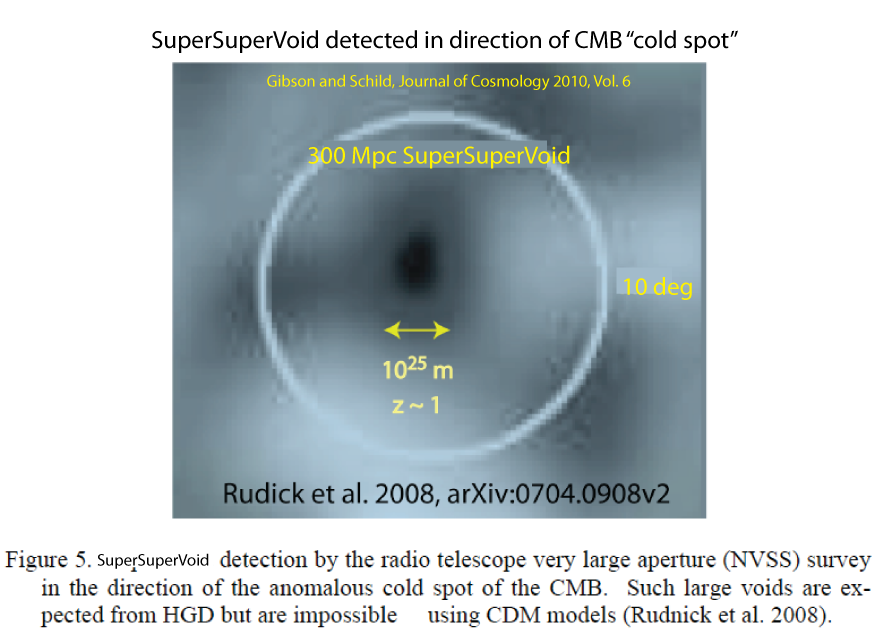
JC2014.24.4.11 (CHG): Revised Figure 5 from Gibson and Schild (J of C 2010, Vol. 6, 1514-1532). This enormous, empty, SuperSuperVoid detection by Rudick et al. completely falsifies LCDMHC cosmology, where superclusters and superclustervoids form slowly by hierarchical clustering (HC) of CDM halos, at much smaller scales (< 10^24 m).
White paper on polarization (174 authors). pp 12754-12762. CHG comments. pp 12763-12764. Primordial polarization of the CMB by gravity waves is the key to detection of big bang turbulence and any residual spin of the universe, as shown in JC2014.24.4.2 BICEP III (CHG).
II. COSMOLOGY & FLUID MECHANICS
A critical difference between HGD and LCDMHCcosmologies is the mechanism of star formation. When stars are formed from dark matter planet mergers the mass of the star grows until it becomes unstable and explodes as a supernova. Such HGD stars are small (1.44 to 1.3 M_sun) and form rapidly (~ 30 kyr corresponding to the free fall time of the first fragmentation). LCDMHC stars form slowly (300 Myr) from gas and dust rather than planet mergers, and may be very massive. See claims by Wu et al. 2014 of a bright hot star with mass 150-300 M_sun formed in star forming region W49 of the Milky Way disk. This claim and the LCDMHC HR diagram in Fig. JC2014.24.5.3 are contradicted by the small Oort cavity size observed.
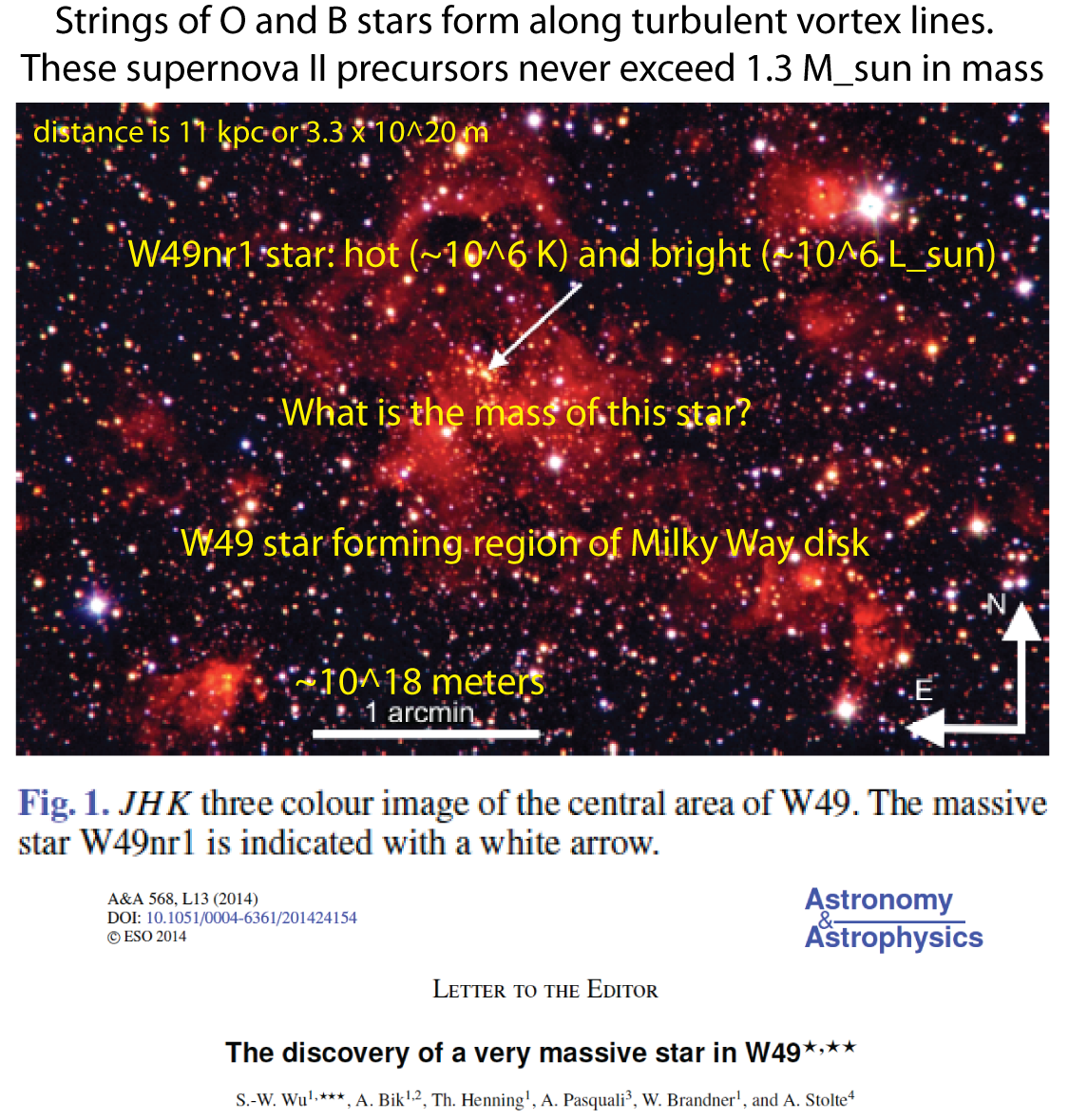
JC2014.24.5.1 (CHG): Claims of massive stars are questionable, either in star forming regions such as W49, or as the source of energy for reionization of the universe after the plasma to gas transition. Reionization is a myth of LCDMHC cosmology, questioned by HGD cosmology. O stars are supernova II precursors, and should not exceed the mass of the resulting pulsars, or ~ 1.3 M_sun.
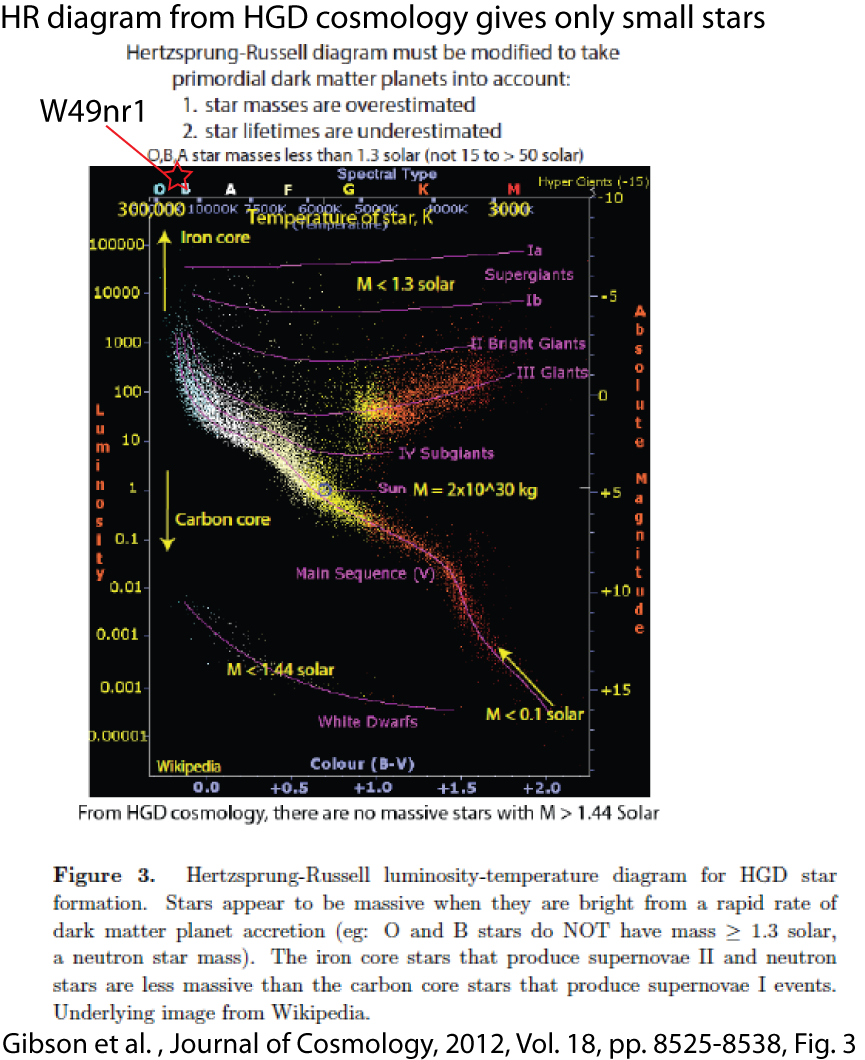
JC2014.24.5.2 (CHG): Hertzsprung-Russell diagram based on HGD cosmology shows the high temperature and high luminosity of the HD49nr1 star (W49nr1 values are plotted as a red star) does not imply a supermassive star (Gibson et al. 2012, J of C, Vol. 18, 8525-8538, Fig. 3).
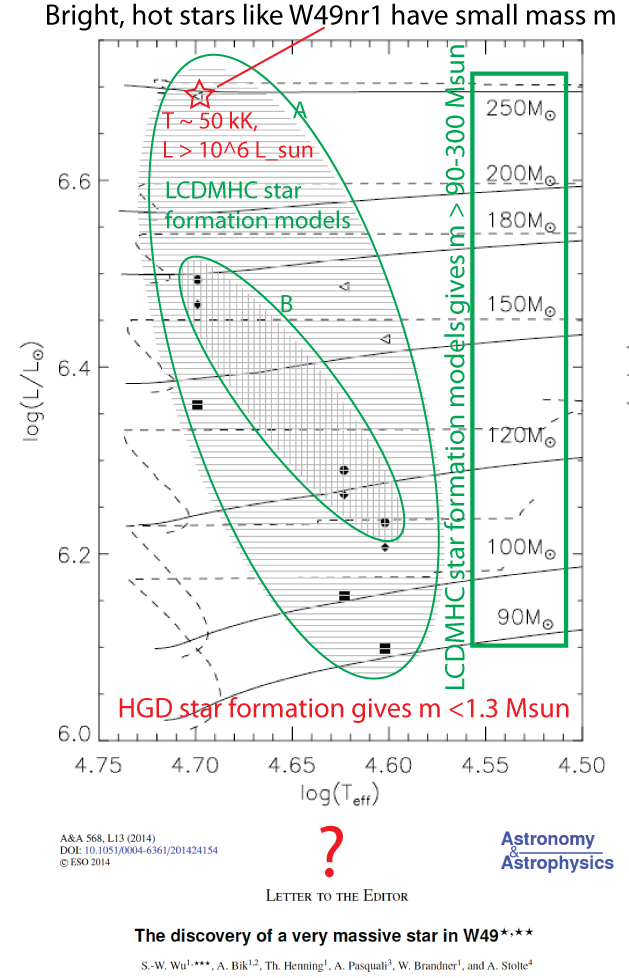
JC2014.24.5.3 (CHG): Hertzsprung-Russell diagram based on LCDMHC cosmology star formation models A and B from Wu et al. 2014. The Wu et al. 2014 conclusion that a massive star has been detected is questionable from HGD cosmology, where the extremely high temperature and high luminosity of the star are suggested in Vol. 23 to be the result of rapid dark matter planet accretion along turbulent vortex lines.
Thousands of O, B and A class stars are found in huge Oort cavities in clumps of PGC clumps of dark matter planets in "star formation" regions such as W49, typically along filaments identified with turbulent vortex lines of dark matter planet fluid. Gaum et al. 2013 study a "star formation" region in the Rosette planetary nebula. The most massive clumps of PGC clumps in the Milky Way are the Magellanic clouds, each with ~ 10^5 PGCs. This is ~ 10% of the MW Galaxy mass.
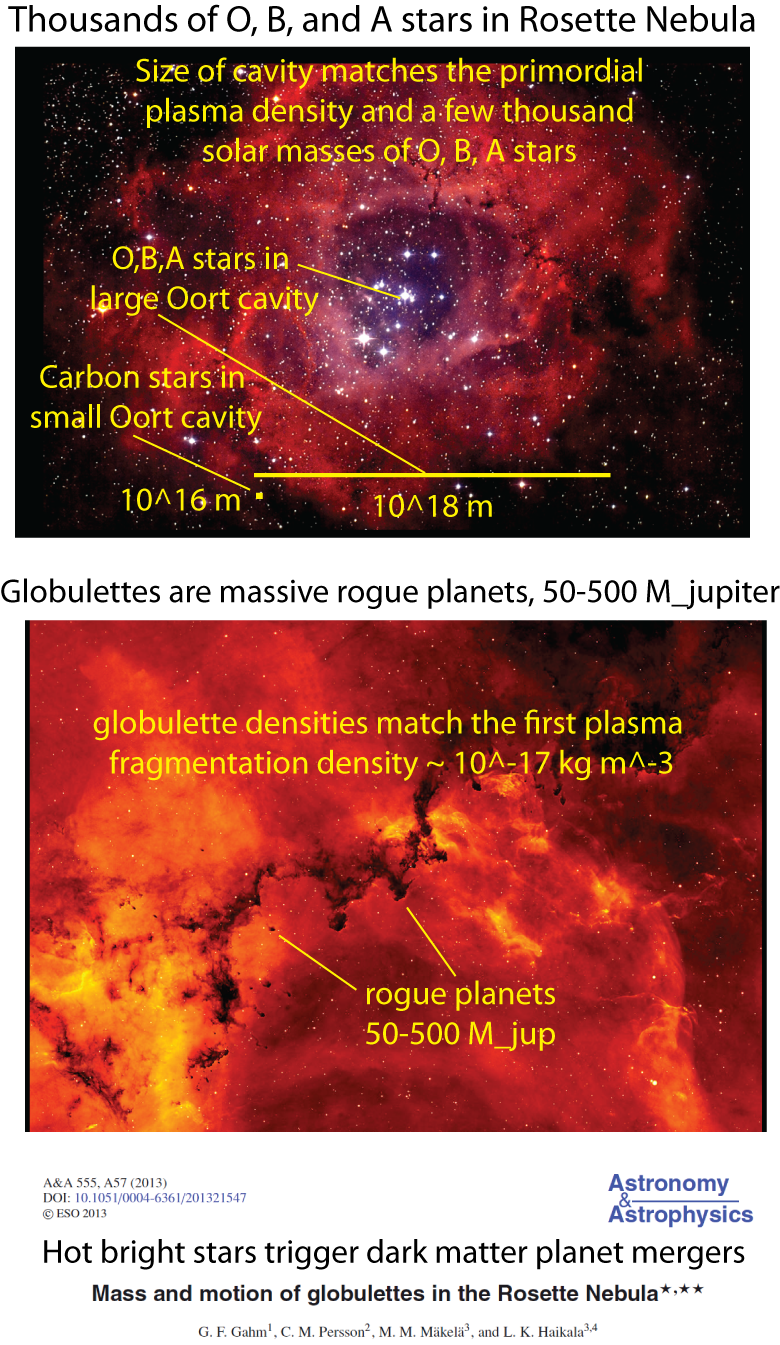
Figure JC2014.24.5.4 (CHG): Thousands of O,B,A stars with mass < 1.3 M_solar require 10^2 times larger Oort cavities than the 10^16 m sizes observed for white dwarf stars forming in planetary nebulae, top.The primordial fragmentation density is a fossil of the plasma epoch baryonic density at 30,000 years after the big bang, bottom, when photon-viscous stresses of the plasma matched gravitational forces at Schwarz viscous and turbulence length scales smaller than the horizon scale (aka Hubble scale) of causal connection ct. Note that the HR diagram of LCDMHC in JC2014.24.5.3 cannot be correct. Massive O,B,A stars >> 1.3 M_sun in clumps of thousands require larger Oort cavities (> 10^18 m) than oberved, assuming the HGD dark matter planet density is ~ 10^-17 kg m^-3, as shown. This is the baryonic density rho_0 of the plasma at 10^12 seconds, and is the observed density of globular star clusters in all galaxies.
5. Signatures of Big Bang turbulence and Plasma Epoch Turbulence are observed in the Cosmic Microwave Background by the Planck Collaboration, Editorial Commentary, Carl H. Gibson, pp 12075-12078.
Figure JC2014.24.5.5 (CHG): Density of brightest Milky Way globular cluster 47 Tuc matches rho_0.
Approximately 50% of the dark matter planets of GC 47 Tuc have merged to form stars, leaving the remaining half trillion in the state of metastable equilibrium that has persisted since the protoglobularcluster PGC fragmented at the plasma gas transition time 10^13 seconds within the Milky Way protogalaxy PG. The PGC, the PG, and the hot gas earth-mass dark matter planets (3000K) were all at the same baryonic density rho_0 ~ 10^-17 kg m^-3, preserved as a fossil of the time of first fragmentation 10^12 seconds in the plasma epoch, according to HGD cosmology. The preservation of rho_0 in PGCs, and in clumps of PGCs, strongly falsifies LCDMHC cosmology, which suggests extreme variability of GC mass, and extreme variability of rho within GCs. Our neighboring galaxy M31 (distance 2.2 x 10^22 m) has about 500 GCs. They are identical to those of the Milky Way, and have small variability (contradicting LCDMHC). See the brightest 75 of the M31 GCs. The brightest of the M31 globulars (magnitude 13.8) is an old and very dense clump of ~twenty PGCs called Mayall II. Its average density matches the central density of Omega Centauri, at ~ 10^-15 kg m^-3.
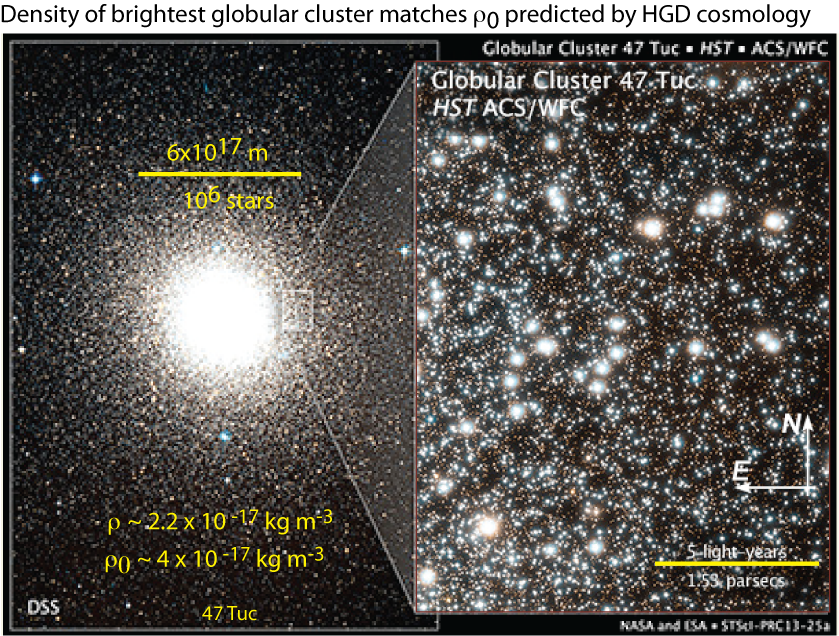

Figure JC2014.24.5.6 (CHG): The density of globular cluster clump Omega Centauri does not match the PGC density rho_0.
When PGCs in protogalaxies clump to form objects like Omega Centauri, the average mass density should be less than the (PGC) primordial dark matter planet clump density value rho_0 ~ 10^-17 kg m^-3. This presumably young clump of ten million stars is the brightest GC-like object in the Milky Way galaxy, with large angular size matching that of the full moon (1/2 degree). The average mass density is only rho_0 ~ 10^-18 kg m^-3. Southern hemisphere telescopes resolve the central stars of this clump, and show a separation of ~10^15 meters. Thus the O-C central density is ~10^-15 kg m^-3. The merging process for PGCs is best described by collisional fluid mechanics, where the dark matter planets in PGC clumps are treated as collisional fluid particles in metastable equilibrium. Near the center of the MW galaxy, GC densities reach ~10^-11 kg m^-3.
Figure JC2014.24.5.7 (CHG): A large globular cluster system is observed in the Sombrero Galaxy halo, caused by the bright, massive, central MECO (magnetosphere eternally collapsing object, Schild & Leiter 2010). The wide range of PGC half light radii is easy to explain by HGD cosmology, but is a mystery to LCDMHC cosmology.
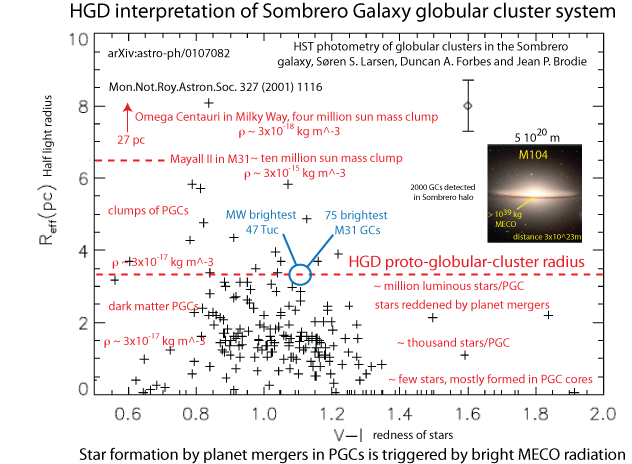
The dashed red line is the HGD cosmology estimate of the half light radius of a PGC clump of dark matter planets, fragmented at the Jeans mass in a clump of a trillion earth mass gas planets at 10^13 seconds. From HGD cosmology, this should also be the large limit radius of luminous GCs in all galaxies, as dark matter planets merge in the PGCs to form stars. The 75 brightest M31 GCs and Milky Way 47 Tuc are shown by the blue circle. The eight billion solar mass Sombrero MECO is extremely bright, and triggers star formation in frozen PGC cores far out in the Sombrero galaxy halo. Half light radii of some of the observed GCs match Oort cavity sizes ~ 3x10^15 m, demonstrating that the first stars form near PGC cores.
Figure JC2014.24.5.8 (CHG): M87 galaxy has 12,000 globular star clusters. They appear to be identical in size, presumably because most are quite luminous from dark matter planet mergers triggered by their collisions as fluid particles in a turbulent flow induced by a big bang turbulence vortex line pointing toward M84. Note the red color of the PGC on the left center of the detail, showing that dark matter planet mergers dominate its color. Inertial vortex force stresses (dashed double arrow) account for the one sided plasma jet. Herschel space observatory infrared images show cold filaments (13.8 K) within PGCs, suggesting the collision mechanism is with the neighboring PGC center of gravity that triggers evaporation and mergers of frozen dark matter planets at this hydrogen triple point.
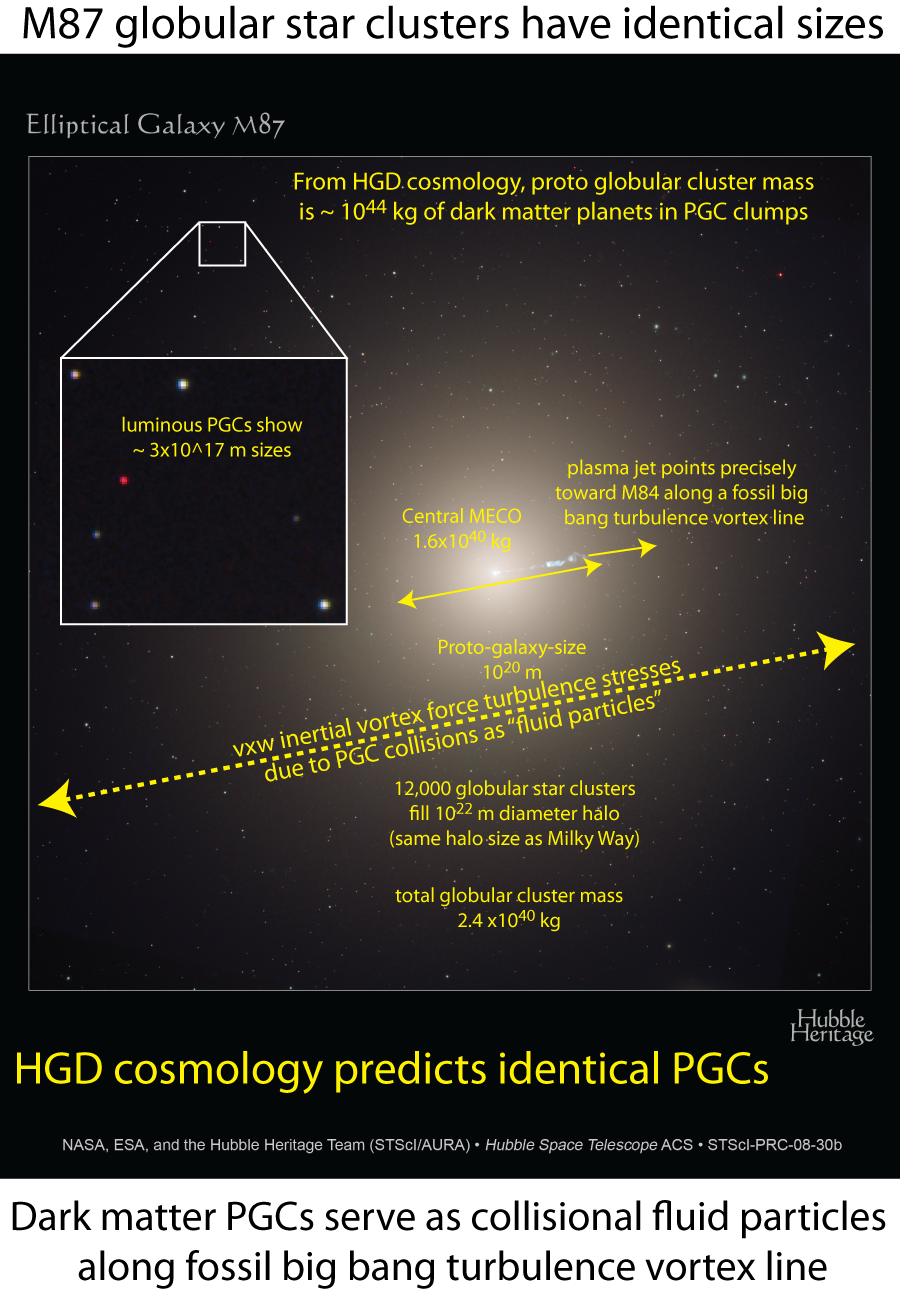
6. The Discovery of Isopropyl Cyanide in Interstellar Space, N. Chandra Wickramasinghe, p 12079.
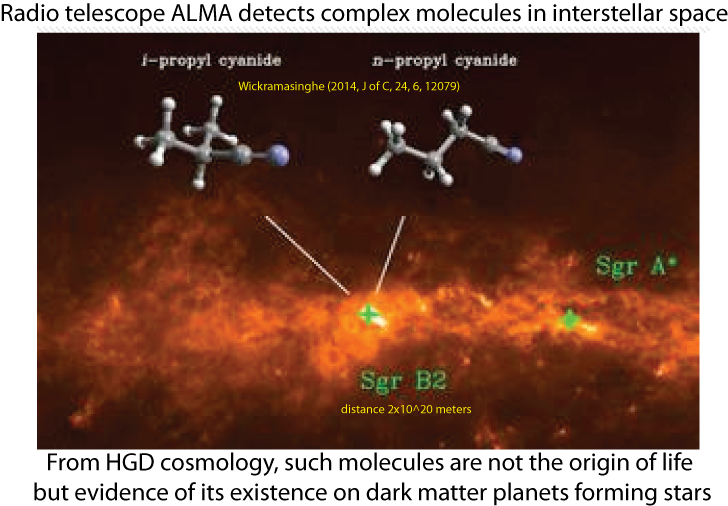
Figure JC2014.24.6.1 CHG: Such molecules reveal burn products of life on dark matter planets merging to form stars, NOT the origin of life as widely claimed.
7. The Transition from Earth-Centred Biology to Cosmic Life, N. Chandra Wickramasinghe, Gensuke Tokoro, and Milton Wainwright, pp 12080-12096.
8. Cosmic Biology or Pre-Biotic Evolution, N. Chandra Wickramasinghe, Gensuke Tokoro, and Milton Wainwright, pp 12097-12101.
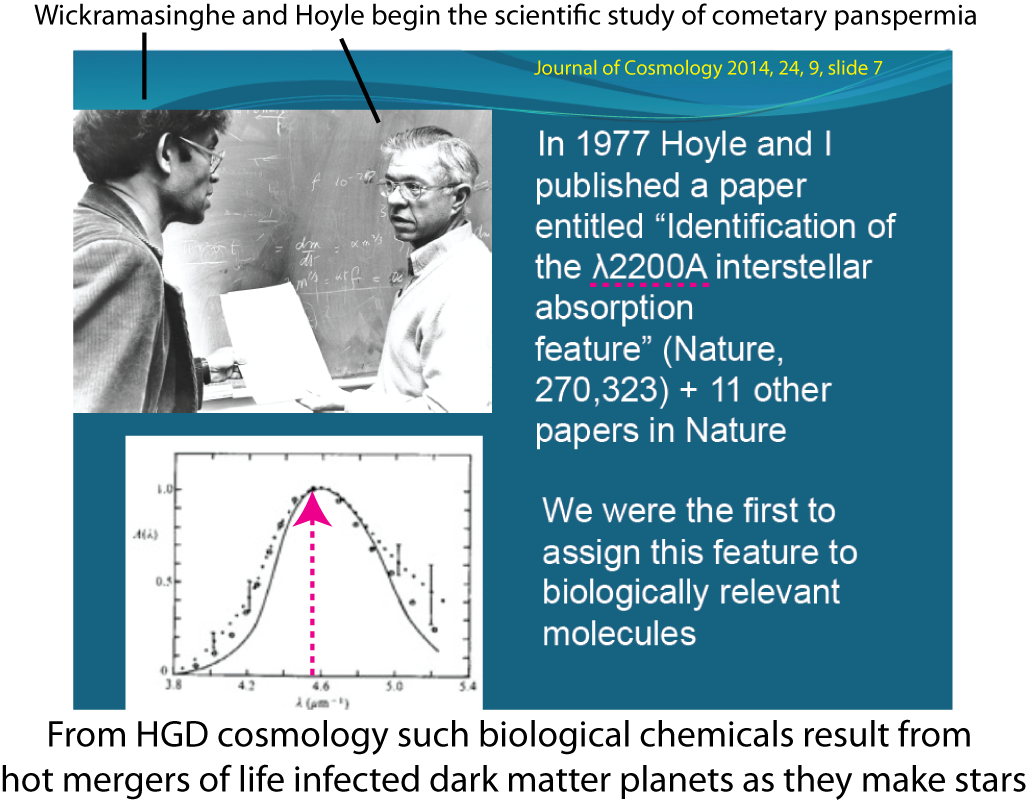
Figure JC2014.24.8.1 CHG:Wickramasinghe and Hoyle started their scientific study of cometary panspermia over 37 years ago. Hydro-gravitational-dynamics (HGD) cosmology (Gibson, Schild 1996) explains the 2200 Angstrom absorption feature as biological smoke from hot mergers of life infested dark matter planets as they make larger planets and stars. LCDMHC cosmology cannot explain these observations.
9. Discovery of Extraterrestrial Life---Impact on Humanity, N. Chandra Wickramasinghe, Gensuke Tokoro, and Milton Wainwright, pp 12102-12159. List of participants of the UN meeting includes the newly appointed acting NASA chief scientist Dr. Gale Allen. Hopefully Dr. Allan will now start working to change the highly negative attitude of NASA toward discoveries of extraterrestrial life and the implications for mankind and space sciences. The existence of extraterretrial life falsifies LCDMHC cosmology, where life anywhere is hopelessly improbable and certainly not homogenized on cosmic scales as indicated by the evidence.
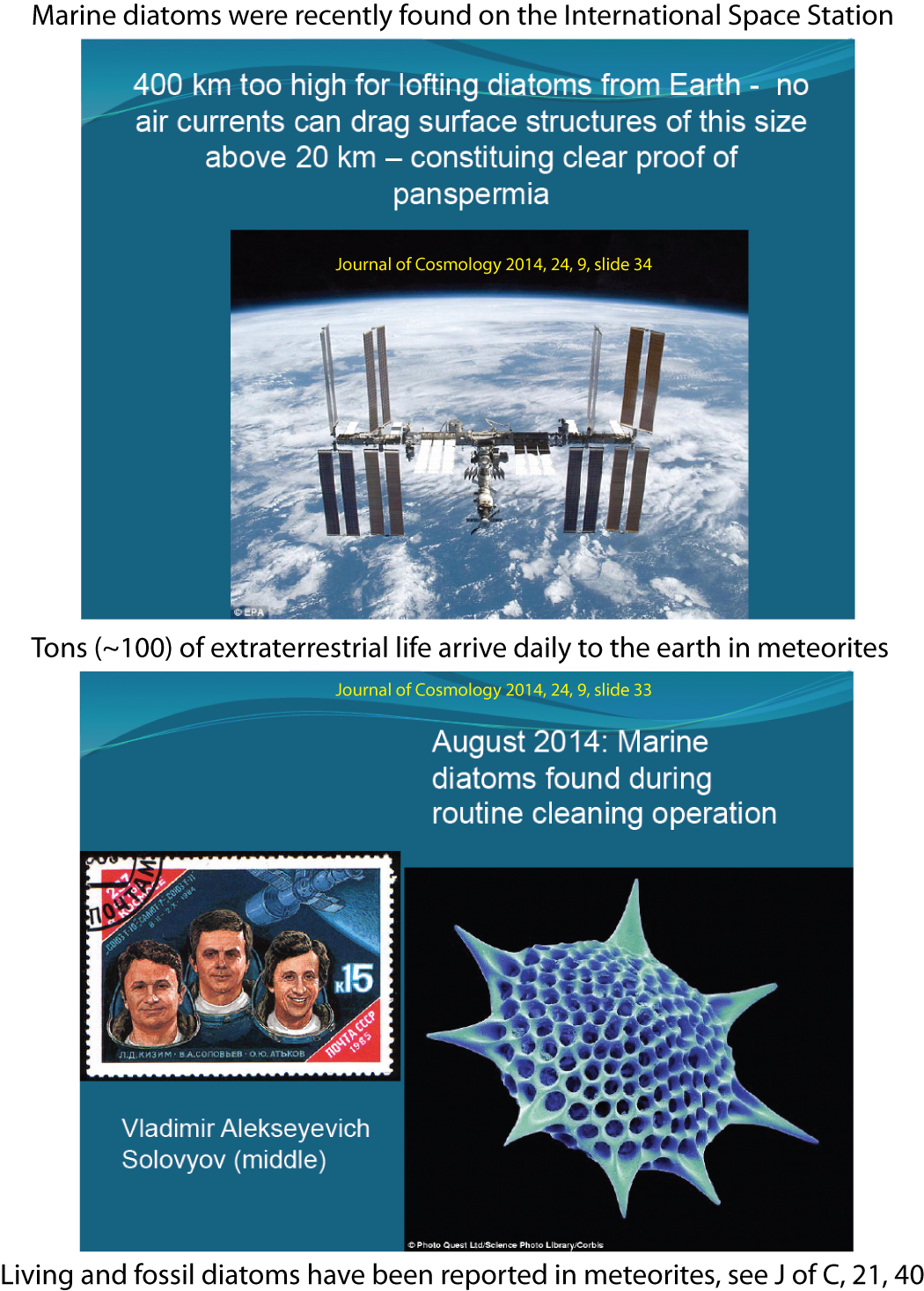
Figure JC2014.24.9.1 CHG: Russian astronauts report (August 2014) finding marine diatoms on the surface of of the International Space Station during a routine cleaning operation. Routine cleaning of the ISS further reduces the possibility that space shuttles might bring contamination to its surface. The discovery of marine diatoms on the Space Station adds to the growing body of evidence that diatoms and an impressive catalog of other organisms evolve and flourish in extraterrestrial water oceans of exoplanets, and are indeed transported to Earth by Wickramasinghe-Hoyle cometary panspermia at rates of hundreds of tons per day.
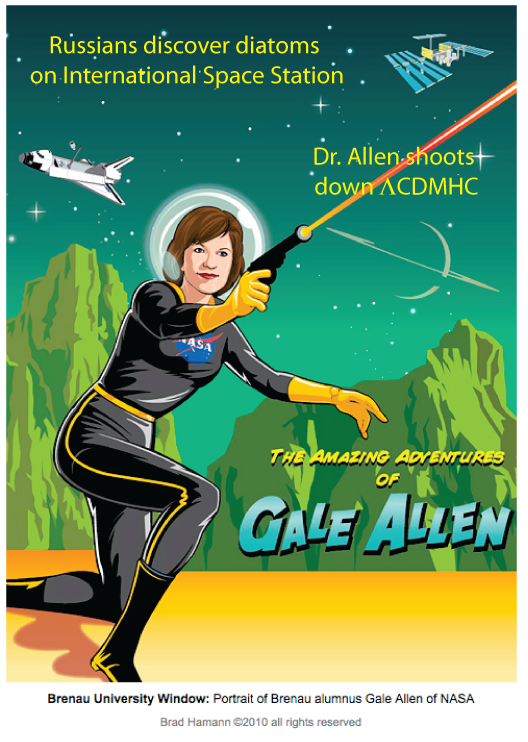

Figure JC2014.24.9.2 CHG: T. M. Brown et al. suggest the baryonic matter (gas) of Ultra Faint Dwarf (UFD) galaxies has been "evaporated" from galaxy cold dark matter halos by reionization due to exploding massive stars, contrary to the predictions of HGD cosmology that massive stars are mythical along with the mythical CDM and the mythical CDM halos of CDMHC. From HGD cosmology, UFD galaxies have a trillion times the mass of their stars (< 10^4 solar), sequestered as dark matter planets. Normally the ratio is ~ 30/1, or 97% (red stars in figure).
Figure JC2014.24.9.3 CHG: Lectures (Ferrera and Pandolphi, 2014) on the Lyman Alpha forest are titled, "Reionization of the Intergalactic Medium". Reionization is triggered locally by star formation in PGCs by dark matter planet mergers of a small mass fraction. No "Epoch of Reionization" evaporated and ionized all the dark matter planets. From the collisional fluid mechanics of HGD, reionization is one of the several myths of LCDMHC. It never happened. Hot regions are detected in ~ Mpc size regions along quasar lines of sight matching the size of galaxy wakes (~ 10^22 m), as observed by star formation borders for the Tadpole galaxy and in the Stephan Quintet.
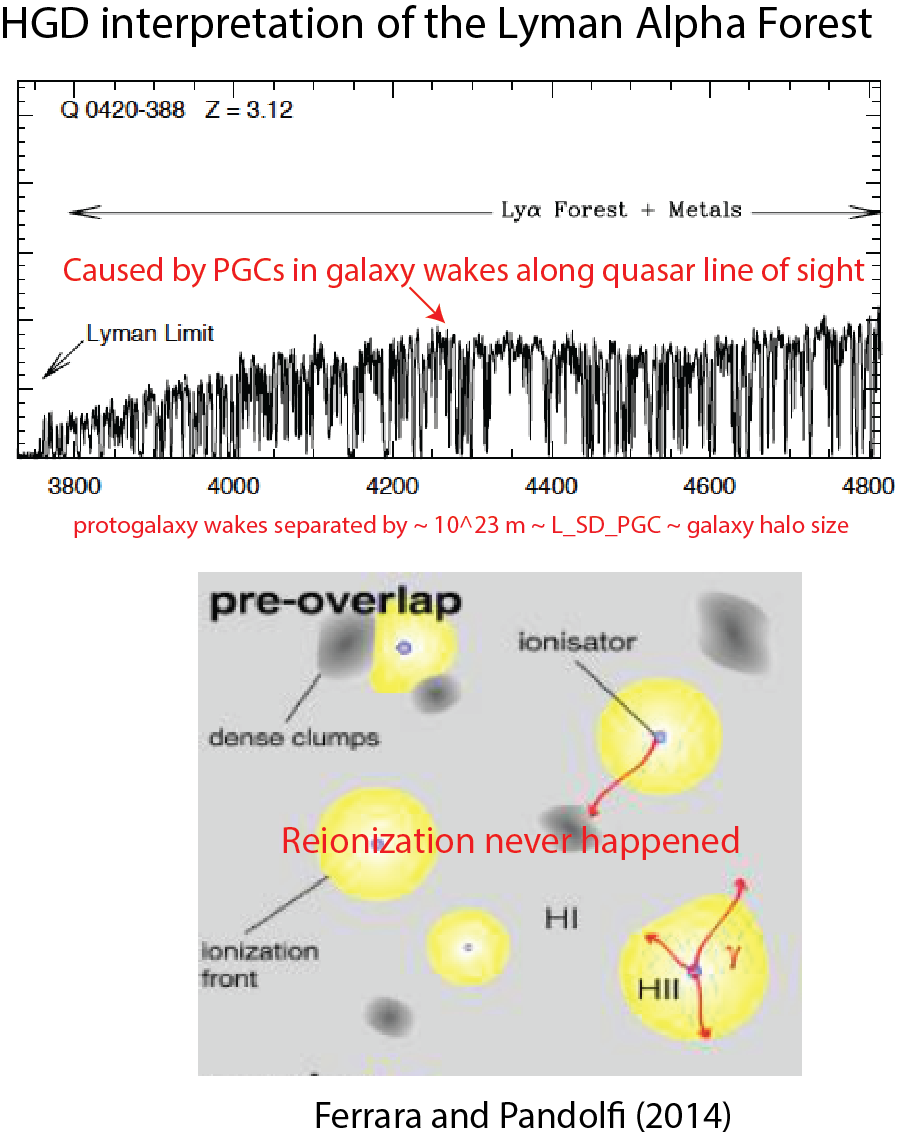
This Figure extracted from the excellent tutorial of Ferrara and Pandolfi (2014) (184 references), pp 12106-12159, shows redshifted Lyman alpha (1215.7 Angstrom) neutral hydrogen absorption lines along the line of sight to quasar Q 0420-388 at redshift 3.12. According to LCDMHC, a population-III class of massive stars existed briefly that reionized the gas (yellow spheres) after its condensation to dark matter planets in clumps of a trillion as PGCs. The "trees" in the forest of lines are separated by ~ 10^22 meters, interpreted by HGD cosmology as the size of galaxy halos formed as nearly collisionless PGCs diffuse to form dark matter galaxy halos after the dark matter planets of the central protogalaxy freeze. According to HGD cosmology, general reionization never happened. The Lyman alpha forest is due to intersections of quasar light with wakes of dark matter PGCs left by galaxies. Occasionally the central core of a galaxy is intercepted (size 10^20 m) and the Lyman alpha light is completely damped.
Figure JC2014.24.9.4 CHG: Numerous myths have resulted from the cold dark matter hypothesis (shown in red). HGD cosmology (shown in yellow) forms its most massive gravitational structures (turbulent clusters of protogalaxies) in the plasma epoch, beginning with big bang turbulence, and ending with big crunch turbulence to Planck conditions, where the turbulent fluid particles are the same galaxies. A 50% chance exists for an antimatter universe in the next big bang. Sample calculations follow the figure for the estimated mass of protogalaxies formed at 10^12 s during the plasma epoch, and the mass of planets at the beginning of the gas epoch at 10^13 s.
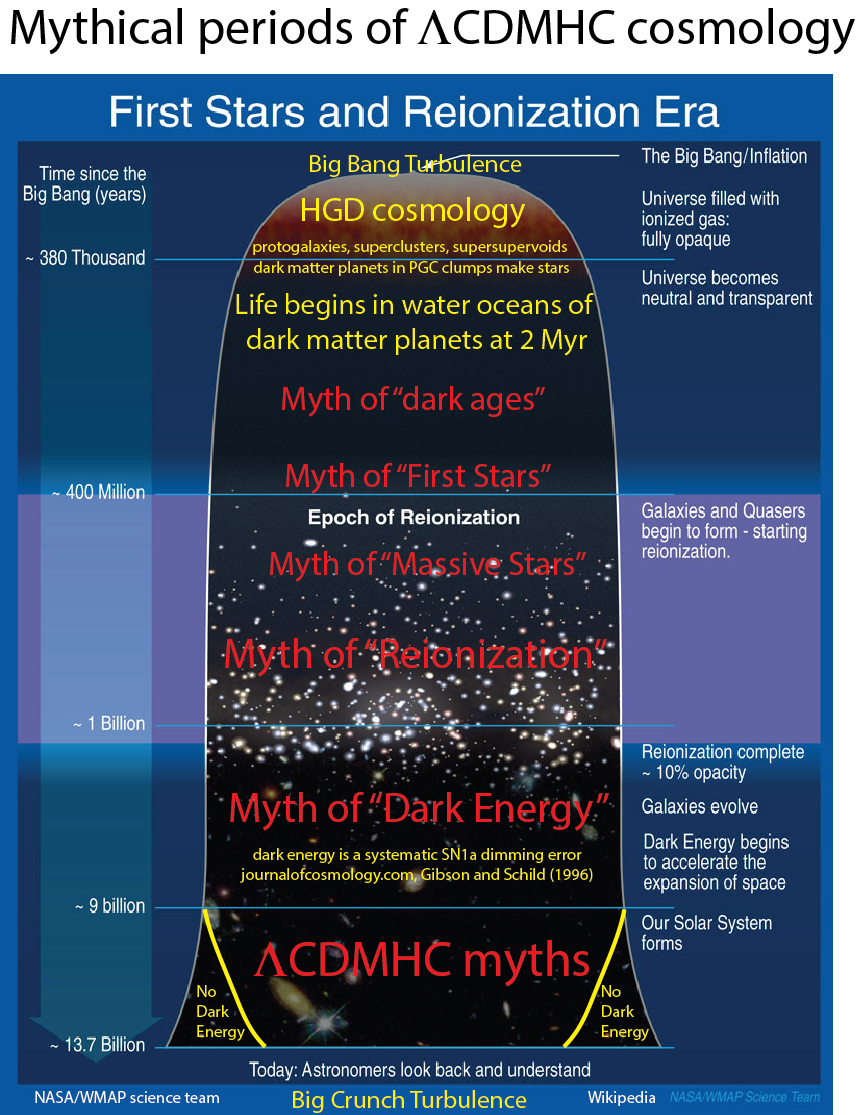
Figure CHG: Collection of erroneous speculationsJC2014.24.9.4 (myths) of LCDMHC dispelled by HGD cosmology and modern turbulence theory.
HGD sample calculations CHG. It is assumed that the plasma epoch begins at 10^11 seconds when mass begins to exceed energy (3000 years). The mean free path for elastic collisions of photons with electrons is 1/sigma n, where sigma is the Thomson cross section (6.65x10^-29 m^2) and n is the number density of electrons (~10^10 m^-3 from Peebles), giving ~ 10^18 m, less than ct for the plasma which ranges between ~10^19 and 10^21 m, so the plasma is a fluid subject to photon viscosity stresses. The photon kinematic viscosity nu is ~ particle speed (c) x mean free path (10^18) ~ 10^26 m^2 s^-1. The Schwarz viscous scale at the time (10^12 s) of protogalaxy fragmentation is ~ [(gamma nu)/(rho G)]^1/2 ~ [(10^-12 x 10^26)/(10^-17 x 10^-10)]^1/2 ~ 10^20.5 m. This gives the mass 10^44 kg for galaxies measured by Tyson and Fischer (1995), about 300 times the galaxy baryonic mass of 10^42 kg, or a million PGCs. At the time of transition to gas, the kinematic viscosity has decreased to nu ~ 10^13 m^2 s^-1, so L_SV is reduced to ~ [(10^-12 x 10^13)/(10^-17 x 10^-10)]^1/2 ~ 10^14 m, with mass ~ 10^25 kg, approximately the mass of Earth. Note that the rate of strain gamma (~ 1/t) and the density rho (~ 10^-17 kg m^-3) are assumed to be fossilized to values existing at the time of first fragmentation ~ 10^12 seconds (30,000 years). Most of the ~ 10^44 kg mass is assumed to be nonbaryonic, now diffused into halos of clusters and superclusters of galaxies that are 97% baryonic dark matter PGC clumps of Earth mass frozen gas planets, Gibson and Schild (1996).
6. MAVEN turns to COMET Siding Spring, N. Chandra Wickramasinghe and W.E. Smith, pp12086-12089.
Figure JC2014.24.5.5 CHG: Star formation observed by ALMA shows turbulent vortex tubes of dark matter planets draining toward an O star.
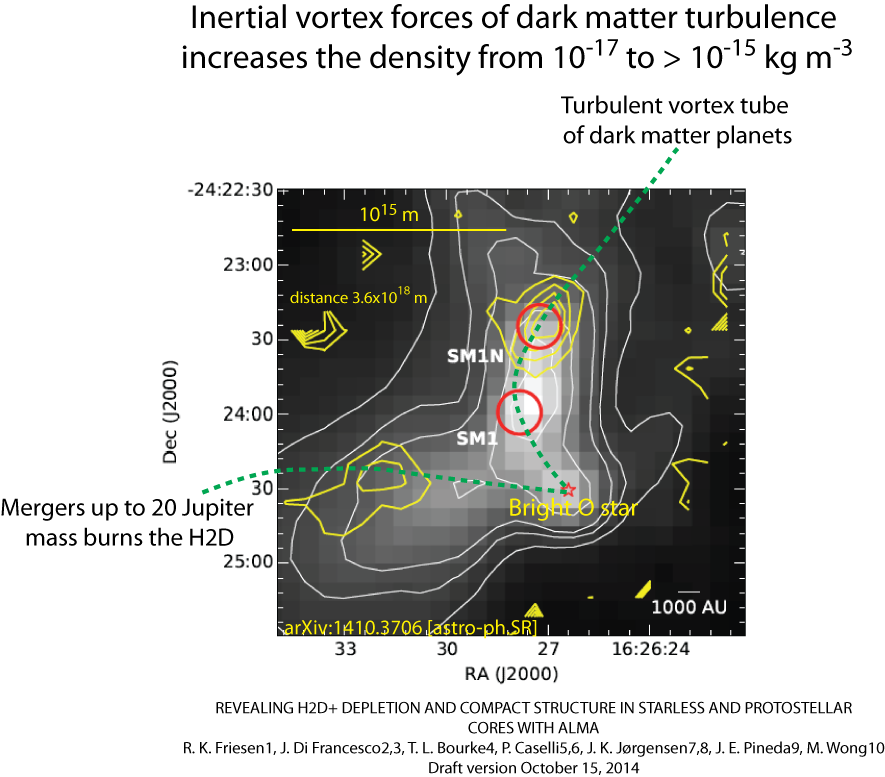
7. Locally Rotationally Symmetric Bianchi Type II Massive String Cosmological Model For Barotropic Fluid Distribution and Vacuum Energy Density (Lambda), Raj Bali and Swati, Department of Mathematics, University of Rajasthan, Jaipur-302004, India, pp 12090-12100.
8. Convergence to panspermia, Chandra Wickramasinghe, William E. Smith, Page Proof of article submitted to hypothesis.com, pp 12101-12105.

https://www.worldscientific.com/worldscibooks/10.1142/9245
9. The Rise and Fall of the ΛCDMHC Theory of COSMIC STRUCTURE FORMATION, Rudolph E. Schild and Carl H. Gibson, pp 12106-12119. Based on Harvard SIDM 2013 workshop.
Related Journal of Applied Fluid Mechanics references are:
Gibson (2008), Cold Dark Matter Cosmology Conflicts with Fluid Mechanics and Observations, pp 12120-12128.
Gibson and Schild (2009), Hydro-Gravitational Dynamics of Planets and Dark Energy, pp 12129-12136.
Gibson, Bondur, Keeler and Leung (2008), Energetics of the Beamed Zombie Turbulence Maser Action Mechanism for Remote Detection of Submerged Ocean Turbulence, pp 12137-12169.
10. ALMA Observations of Warm Dense Gas in NGC 1614 --- Breaking of Star Formation Law in the Central kpc, C. K. Xu et al., pp 12170-12183. The authors do not consider the role of dark matter planet mergers as the source of most of the powerful LIRG radiation. An alternative interpretation based on HGD cosmology and Hoyle/Wickramasinghe cometary panspermia is shown in Figure JC2014.24.10.1 CHG below. The excellent resolution of ALMA and its sensitivity to carbon monoxide concentrations support this interpretation based on dark matter planets and cometary panspermia, and do not support standard cosmology and standard star formation "laws".
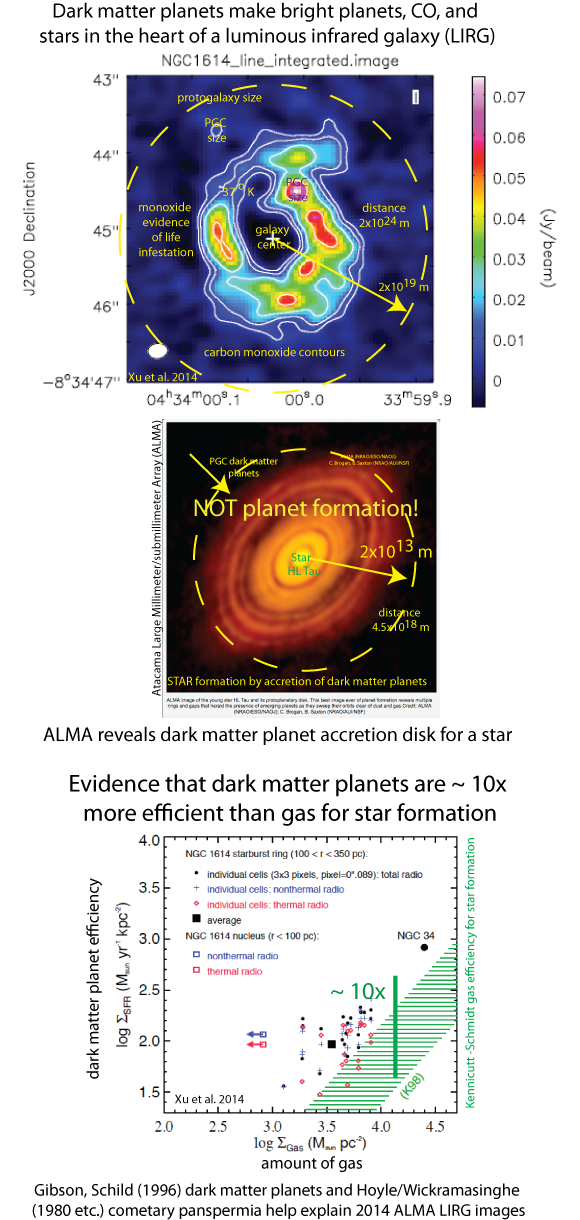
Figure JC2014.24.10.1 CHG: HGD interpretation of ALMA LIRGs (top, bottom) and an ALMA star (center).
ALMA radio telescope (top) achieves high resolution images of CO concentrations, bright dark matter planets, and star formation in the cores of Luminous Infrared Galaxies (LIRGs) that confirm predictions of Gibson, Schild 1996 HGD cosmology and Hoyle/Wickramasinghe cometary panspermia, NOT LambdaCDMHC. Infrared radiation nearly a trillion times (>10^11.5) that of the sun emerge from the LIRGs as their dark matter planets merge to form larger planets and stars. The interstellar "dust" temperature is estimated to be 37 K, close to the critical temperature of hydrogen (33.2 K), consistent with the dust interpreted as dark matter frozen hydrogen planets as collisional turbulent fluid particles rapidly merging to form stars. A protoplanetary disk (middle) of star HL Tau shows STAR formation (NOT planet formation!) as dark matter planets merge and radiate powerfully. Life infestation of the dark matter planets is indicated by the carbon monoxide waste product. Dark matter planets (bottom) are about ten times more efficient at star formation than gas and dust, using the Kennicutt-Schmidt correlation, shown in green. Note that the galaxy accretion disk (top, bottom) for PGCs is at about a million times the distance of the star accretion disk (middle) for dark matter planets. Figure JC2014.24.5.5 CHG: Shows the role of turbulent dark matter planet vortex tubes in rapidly producing bright O, B, A stars in large numbers with high density, as in the 1614 LIRG described by Xu et al (2014), by accelerated dark matter planet mergers.
Figure JC2014.24.10.2 CHG: Wikipedia fails to understand turbulence.
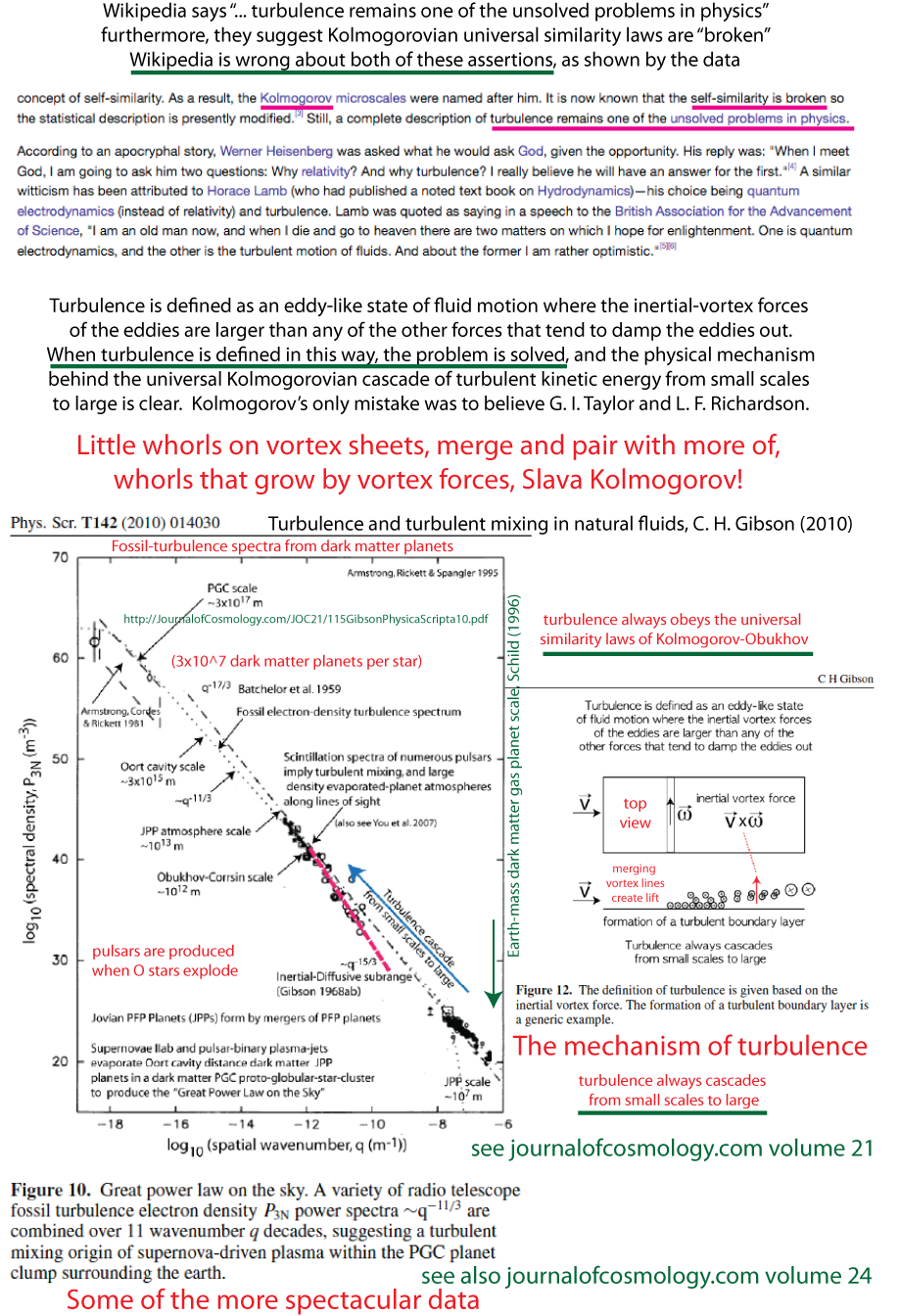
Figure JC2014.24.10.3 CHG: An instrumented lander is placed on a comet by ESA. This short period comet has the same (black) appearance as the long period (Oort cavity scale) Halley comet surface predicted by Hoyle/Wickramasinghe before the ESA Giotto mission to Comet Halley in 1986.

ROSETTA may reveal our Cosmic Ancestry, N. Chandra Wickramasinghe.
11. SPECIFIC SMALL-SCALE VORTICES (“VORTEX COLUMNS”) IN THE SEA SHELF AREAS DUE TO THE NEAR-BOTTOM CONVECTION, V.G.Bondur, Yu.V.Grebenyuk, R.N. Keeler, K.D.Sabinin, S.I.Muyakshin, C.H. Gibson, pp 12200-12220
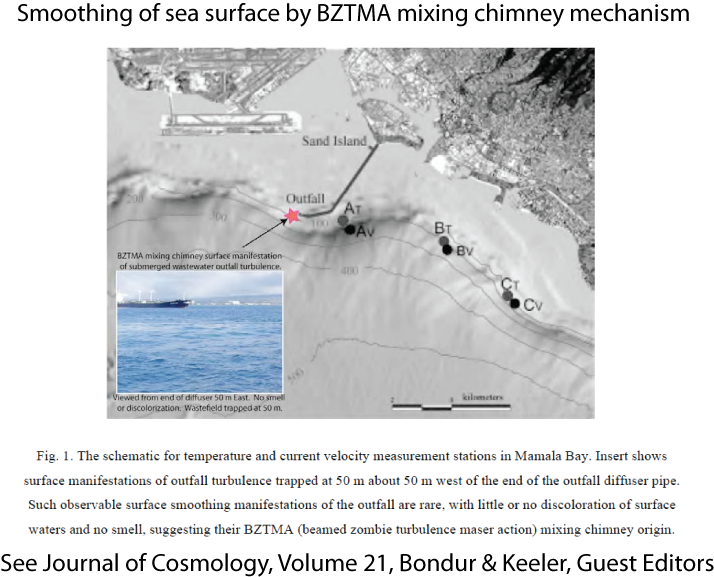
Figure JC2014.24.11.1 CHG: Direct visual evidence of the generic stratified turbulence mixing mechanism, BZTMA mixing chimneys. Fossil turbulence waves radiated from the Oahu bottom boundary layer tilt the sharp density layers of the Honolulu municipal outfall turbulent fossils, reactivating their turbulence (zombie turbulence). Fossil turbulence waves from these zombie turbulence patches cause the sea surface smoothing the eye can see. See details of how Professor Bondur and his group detects submerged turbulence by remote sensing, and how the RASP program (2002-2004) extracted the physical mechanism.
News of the election of Vladimir Fortov as President of the Russian Academy of Sciences is here. (Link supplied by Academician Bondur).
Figure JC2014.24.11.2 CHG: Schematic diagram for the transfer of turbulent kinetic energy from small scales to large based on turbulence defined by the inertial vortex force vxw. Turbulence begins at Kolmogorov scales when vxw forces exceed viscous forces at a universal critical Reynolds number (at wall unit scales about five times L_K).
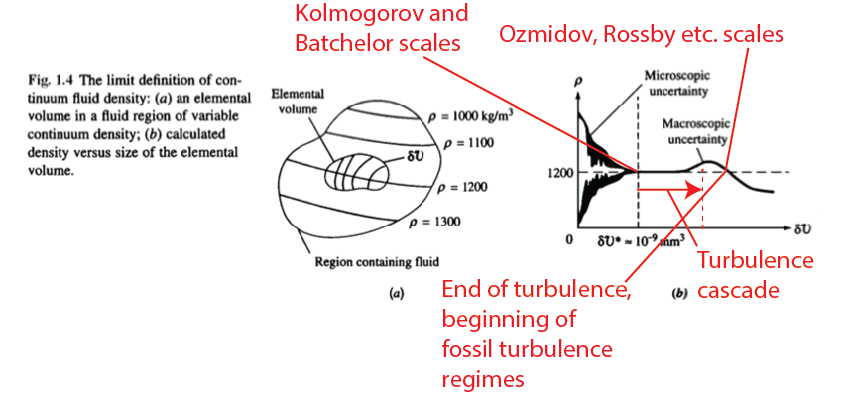
Fig. 1.4 about the continuum hypothesis of collisional fluid mechanics, is from Frank White's book Fluid Mechanics, which is crucial reading for cosmologists that employ obsolete (Jeans 1902) concepts such as collisionless fluid mechanics that underlie LCDMHC cosmology. Turbulent kinetic energy always cascades from the Kolmogorov scale (where the vxw / viscous acceleration, or Reynolds Number, ratio of a flow first exceeds a universal critical value) to some larger scale where the energy is transferred to fossil turbulence internal waves. Note that the clever remote sensing methods exploited in Academician Bondur's paper (number 11) reveal evidence of fossil turbulence at Ozmidov scales ten times larger than those produced at the Sand Island Municipal Outfall, suggesting such internal waves originate at the bottom boundary layer. See Geophysical Research Letters paper (Keeler, Bondur, Gibson 2005), Optical satellite imagery detection of internal wave effects from a submerged turbulent outfall in the stratified ocean, describing the measurements and the proposed BZTMA mixing chimney mechanisms, pp 12291-12296.
12. Herschel imaging of the dust in the Helix Nebula (NGC 7293), G. C. Van de Steene, P. A. M. van Hoof, K. M. Exter, M. J. Barlow, J. Cernicharo, M. Etxaluze, W. K. Gear, J. R. Goicoechea, H. L. Gomez, M. A. T. Groenewegen, P.C .Hargrave, R. J. Ivison, S. J. Leeks, T. L. Lim, M. Matsuura, G. Olofsson, E. T. Polehampton, B. M. Swinyard, T. Ueta, H. Van Wincke,C. Waelkens, and R. Wesson, A&A preprint, pp12221-12229.
Figure JC2014.24.1.1 CHG: The far infrared sensitivity of the Herschel space observatory permits measurements of the "dust" temperature and mass in the nearby Helix planetary nebula. A white dwarf star is formed by mergers of dark matter planets. The star appears to be binary because of the central plasma jets that bring the surrounding planets out of the dark. The top image is a composite of many frequencies and telescopes. The bottom image shows the temperatures within the boundary of the Herschel data (solid white, top) range between the triple point temperature of hydrogen 30.8 K, and 40 K, with average near the critical point temperature of hydrogen 33.2 K, as expected from HGD cosmology and frozen hydrogen gas planet mergers. The star dust mass is estimated as very small (~ ten Jupiters) compared to ~ 100 solar mass within the Herschel boundary, as dark matter planets. Far infrared images clearly show protocometary objects and their wakes as the larger planets fall into the Oort cavity to feed the central carbon stars. A full report is given in Volume 16 of the Journal of Cosmology.
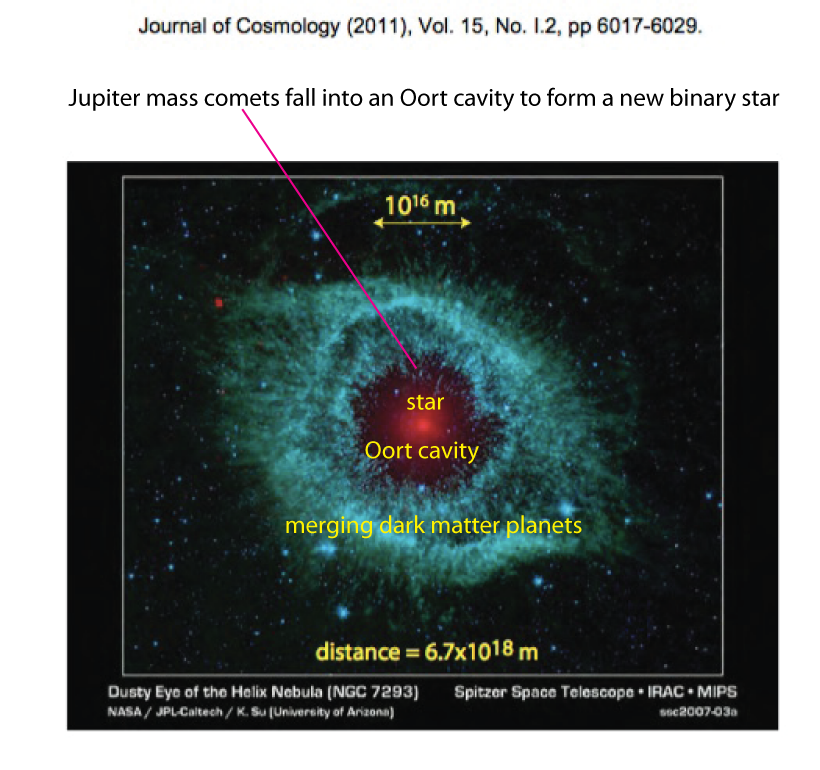
The authors estimate the star dust mass to be that of a few Jupiters; that is, much less than about a hundred solar masses of dark matter planets, assuming the density of the dark matter planets, and the PGC clump, is the primordial plasma value rho_o at the time of first fragmentation ~ 10^-17 kg m^-3. The net mass flow to the stars is either inwards as life-infested comets, according the HGD cosmology, or outwards, according to (Mass Loss of an Evolved Star) MESS (suggested here to be a remnant of the obsolete LCDMHC cosmology, where dying evolved stars mysteriously dump all their mass in superwinds to form planetary nebulae). The central (binary) star is not "evolved", but growing toward a supernova I as it eats and burns the dark matter planets to form more carbon. The dimming of supernovae I events is highly variable due to the thick dark matter planet atmospheres irradiated by the central stars, causing a systematic dimming error mistaken as evidence of the mysterious antigravitational substance dark energy. This HGD interpretation of planetary nebulae falsifies the 2011 Nobel Prize in Physics.
13. Evidence of a Massive Thermonuclear Explosion on Mars in the Past, The Cydonian Hypothesis, and Fermi’s Paradox, John E. Brandenburg, Ph.D., pp 12229-12280. ABSTRACT.
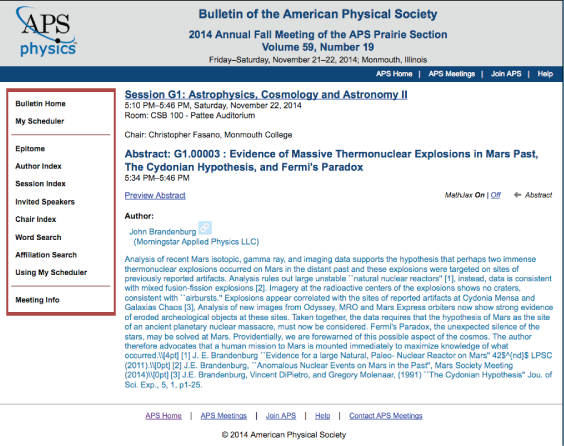
See ibtimes article in response to Dr. Brandenburg's paper. Athena Yenko article.

Figure JC2014.24.13.1 CHG: The red appearance of Mars is NOT strong evidence of nuclear explosions, natural or otherwise. Dr. Brandenburg suggests (personal communication) possible evidence of "trinitite" (atomic glass as from the 1945 Trinity test) has been found at the sites of nuclear exposions discussed in his article. Redness suggests ferric oxide (hematite) Fe_2O_3 produced by an oxygen rich atmosphere, which is reasonably good evidence of plant life on a planet (past or present) since oxygen is produced by plants. Note the red appearance of Earth in desert areas viewed from space.
14. Russian spacecraft result confirms validity of panspermia, Chandra Wickramasinghe, pp 12281-12282.
15. Alignment of quasar polarizations with large-scale structures, D. Hutsemékers, L. Braibant, V. Pelgrims, D. Sluse, pp 12283-12290. Clear demonstration of galaxy spin alignments with each other and the host flow on scales of a gigaparsec Gpc (3 x 10^25 meters), supporting the HGD claims of a turbulent big bang dominated by powerful spin effects that appear at all scales as fossils of the turbulence. The present horizon scale ct is ~ 10^26 m.
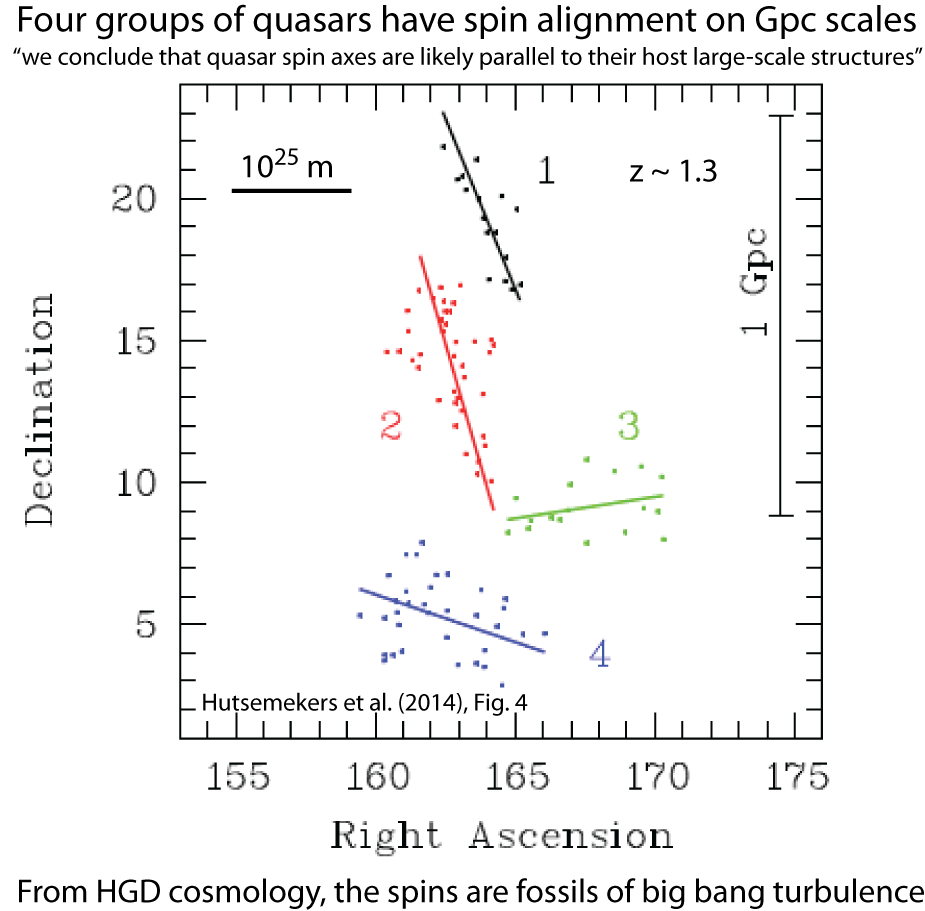
Figure JC2014.24.15.1 CHG: The big bang turbulent combustion mechanism (Gibson 2004, 2005) at Planck scales and conditions requires a 10^43 radian/second spin. This spin and morphology is preserved in many ways, especially at large scales as shown in the figure. Fossil turbulent vortex lines trigger the formation of SuperSuperVoids and boundary layer turbulence of protogalaxies, as viscous and collisional fluid particles, that mix up to supercluster scales in the plasma epoch, with galaxy collisional viscous stresses in the expanding universe and approximate conservation of angular momentum reflected by the alignments of quasar spin axes with large scale host flow motions, as shown in Hutsemekers et al. (2014), Fig. 4.
Commentary by Editor-In-Chief Rudy E. Schild RES: "From the standard Lambda-Cold-Dark-Matter (LCDM) model of the origin of structure in the Universe, this is a disaster. That prevailing theory predicts only smaller scale structures in the universe, and they should have their origin in collisional random processes. This new observation is impossible in the standard LCDM and everybody knows it.
On the other hand, such structure is PREDICTED by the Gravitational Hydro Dynamics (GHD) model, where we start with a rotating expanding universe and structure gradually originates by a slow gravitational separation of condensations and voids, seen in the cosmic observations of distant galaxies. The Universe rotation has to break up from turbulent forces, and the GHD theory predicts that the breakup cells would be on size scales of a Giga-Parsec, which is exactly what is seen in the image accompanying the article. And galaxies would occur on the edges of the voids, with aligned spins, as observed. The Universe rotation is seen in the Cosmic Microwave Background alignment of the locally observed Dipole, quadrupole, and octapole moments of the observed CMB radiation as detected by WMAP and PLANCK spacecraft.
So the voids and their clumps and strings are part of the rotation of the Universe, and are described as the off-diagonal elements of the Einstein GR theory. Thus in any Relativistic Quantum Electrodynamical theory, they would have relativistic presence in the stress-energy tensor.
Too bad for the standard LCDM model of cosmic structure formation. --Rudy--"
16. On the dynamics of volatile meteorites, S G Coulson, M K Wallis & N C Wickramasinghe, to appear in MNRAS, Sept. 2014.
17. Catastrophic Equatorial Icing Caused the Air France 447 and Malaysian 370 Crashes. This paper has been moved to the Catastrophic Equatorial Icing-dedicated Volume 28
18. Bianchi Type V Inflationary Universe with Massless Scalar Field And Vacuum Energy Density, Raj Bali, Swati Singh, pp 12291-12305.
19. A uniform history of galaxy evolution, Steinhardt and Speagle (2014), arXiv:1409.2883v1. Dr. Steinhardt described some of these results in a recent lecture at Harvard-Smithsonian, attended and praised by Editor in Chief Rudy Schild. The SPLASH observations agree with HGD cosmology predictions that galaxies should be much more numerous at large redshifts than predicted by LCDMHC cosmology.
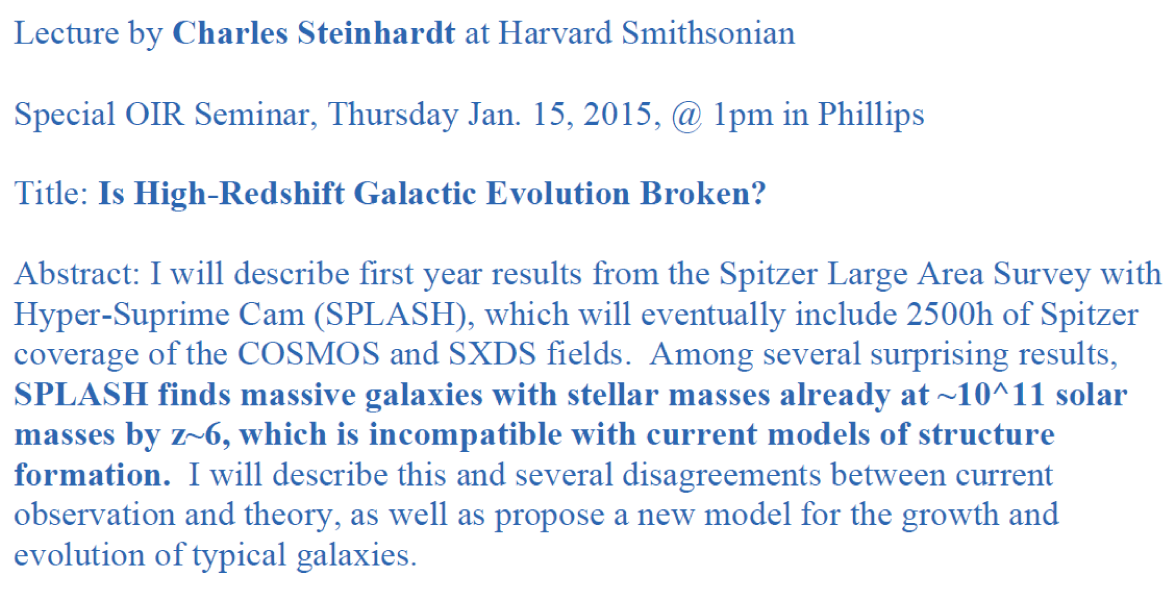
Figure JC2014.24.19.0 CHG: Dr. Steinhardt of Caltech presented evidence in his seminar supporting a major prediction of HGD cosmology, which is that proto-galaxies form early in the plasma epoch by fragmentation at ~10^12 s (eg.: frontispiece Figure JC2014.24.4). This completely contradicts and falsifies LCDMHC, where galaxies are supposed to be formed as the last step of CDM cosmology (HC) rather than the first. This answers the Seminar Title question: Yes, "High Redshift Galactic Evolution" is broken. pp 12315-12317.
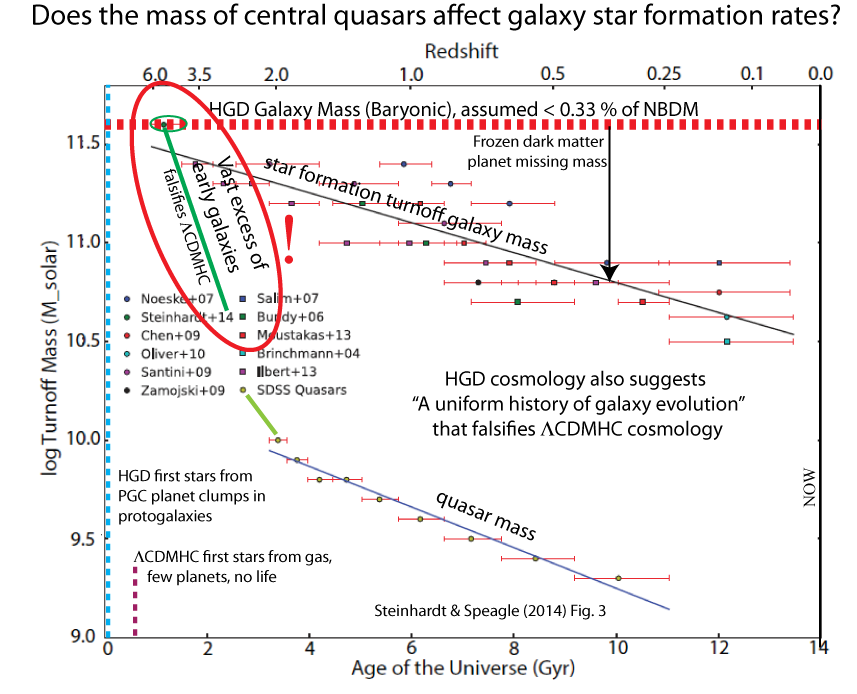
Figure JC2014.24.19.1 CHG: Estimates of galaxy mass (green) and quasar mass (yellow-green) as a function of the age of the universe. Galaxy masses are estimated at the time of star formation turnoff. From HGD cosmology the decrease reflects freezing of the dark matter planets and diffusion into halos of their PGC clumps after ~30 Myr. The red dashed line is an HGD estimate of ~6x10^41 kg BDM in galaxies as PGCs. The NBDM galaxy mass > 10^44 kg diffuses to larger scales determined by the Schwarz diffusive scale (D^2 / rho G)^1/4 (see Fig. JC2014.24.4.6 above), pp 12312-12314.
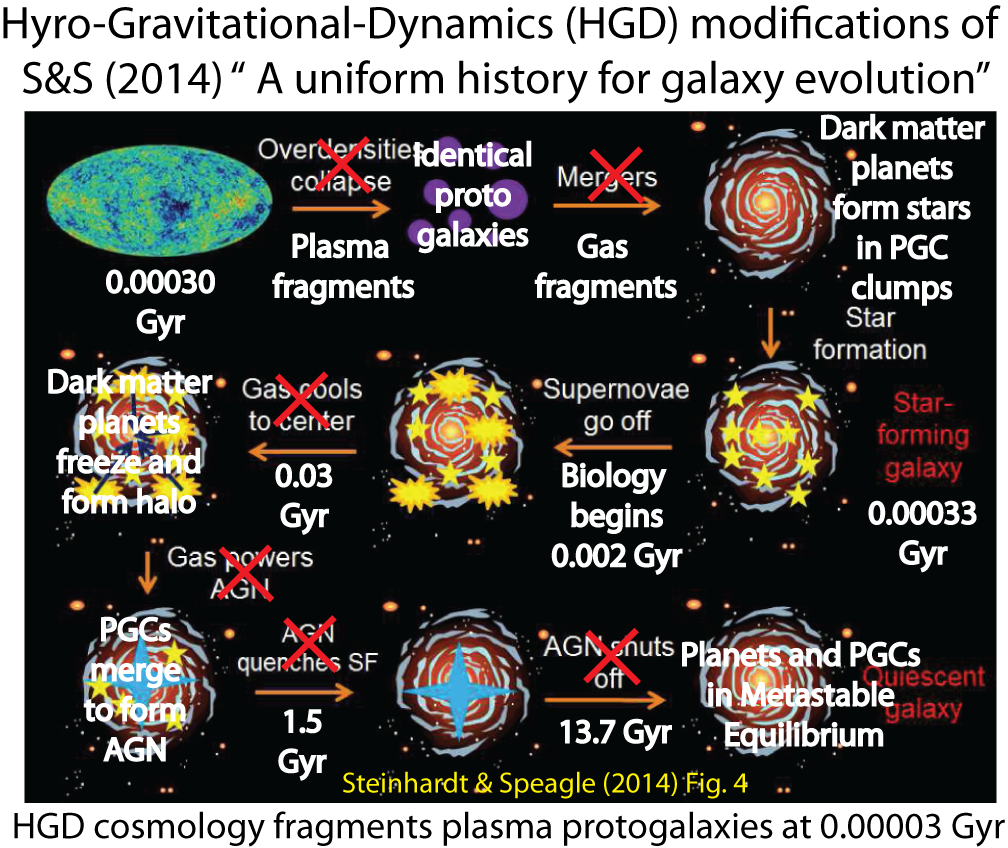
Figure JC2014.24.19.2 CHG: Comparison of HGD model of galaxy evolution with S&S (2014) model. When collisional fluid mechanics of HGD is assumed, galaxies form by fragmentation of viscous plasma in turbulent boundary layers of expanding voids formed 30,000 years after the big bang at density minima of fossil big bang turbulence vortex lines, or 0.00003 Gyr (10^12 seconds). The density and rate of strain of the plasma (hydrogen and helium-4) are preserved as a fossil of this time by proto-globular-star-cluster PGC dark matter planet clumps where all stars form by merging dark matter planets (Schild 1996, Gibson 1996), pp 12308-12310.
20. Penrose-Hameroff "Consciousness in the Universe" supports Hoyle-Wickramasinghe cometary panspermia, CHG. Professors Penrose and Hameroff have demonstrated clear evidence of quantum mechanically orchestrated objective reduction in microtubules within brain neurons. Their conclusion that "consciousness plays an intrinsic role in the universe" supports the HGD cosmology conclusion that the time when consciousness began playing its role was soon after the time of the biological big bang (2 million years). Note: The Journal of Cosmology makes no claim to the copyright of Penrose-Hameroff ideas that would interfere with their publications elsewhere.
Figure JC2015.24.20.1 CHG: Can the Diosi-Penrose Hameroff Orchestrated Objective Reduction scenario produce sentient beings in neutron stars ("cheelas")?
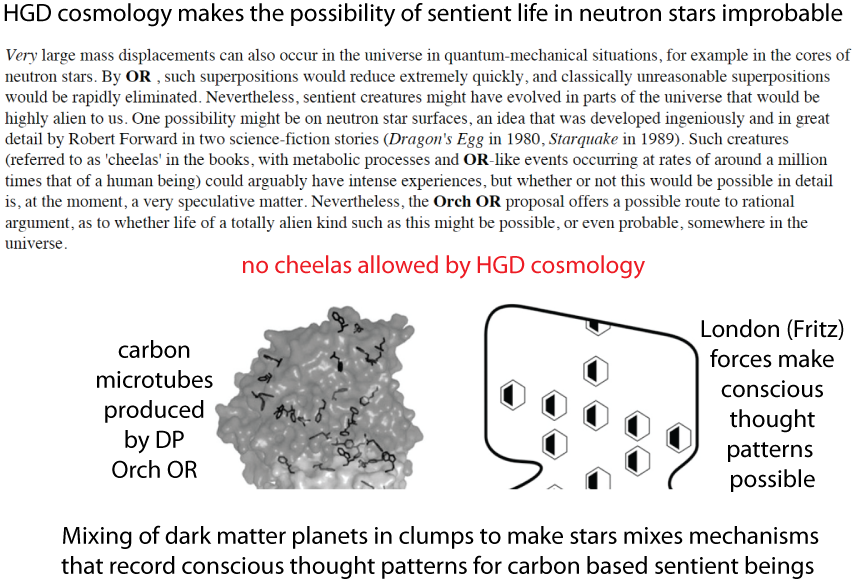
The key to the formation of life in HGD cosmology is the intrinsic repeated mixing of information from liquid oceans full of organic chemistry and life. Dark matter planets in clumps merge to make larger planets and all stars from the ~10^80 dark matter planets produced by the big bang, not to mention the moons and comets. The stars make the carbon and other organic chemicals needed for biology. Consciousness in HGD emerges soon after the beginning of the biological big bang at 2 million years after the cosmological big bang when water first could become liquid. Nothing like this is known to happen or is physically possible in neutron stars, despite their larger mass and higher intrinsic frequency. Cheelas are NOT allowed by HGD cosmology, even if somehow they were suggested as a possibility by physics.
21. Catastrophic Equatorial Icing events crash aircraft with increasing frequency
This paper has been moved to the Catastrophic Equatorial Icing-dedicated Volume 28
22. A dusty, normal galaxy in the epoch of reionization, Darach Martin et al., arXiv preprint.
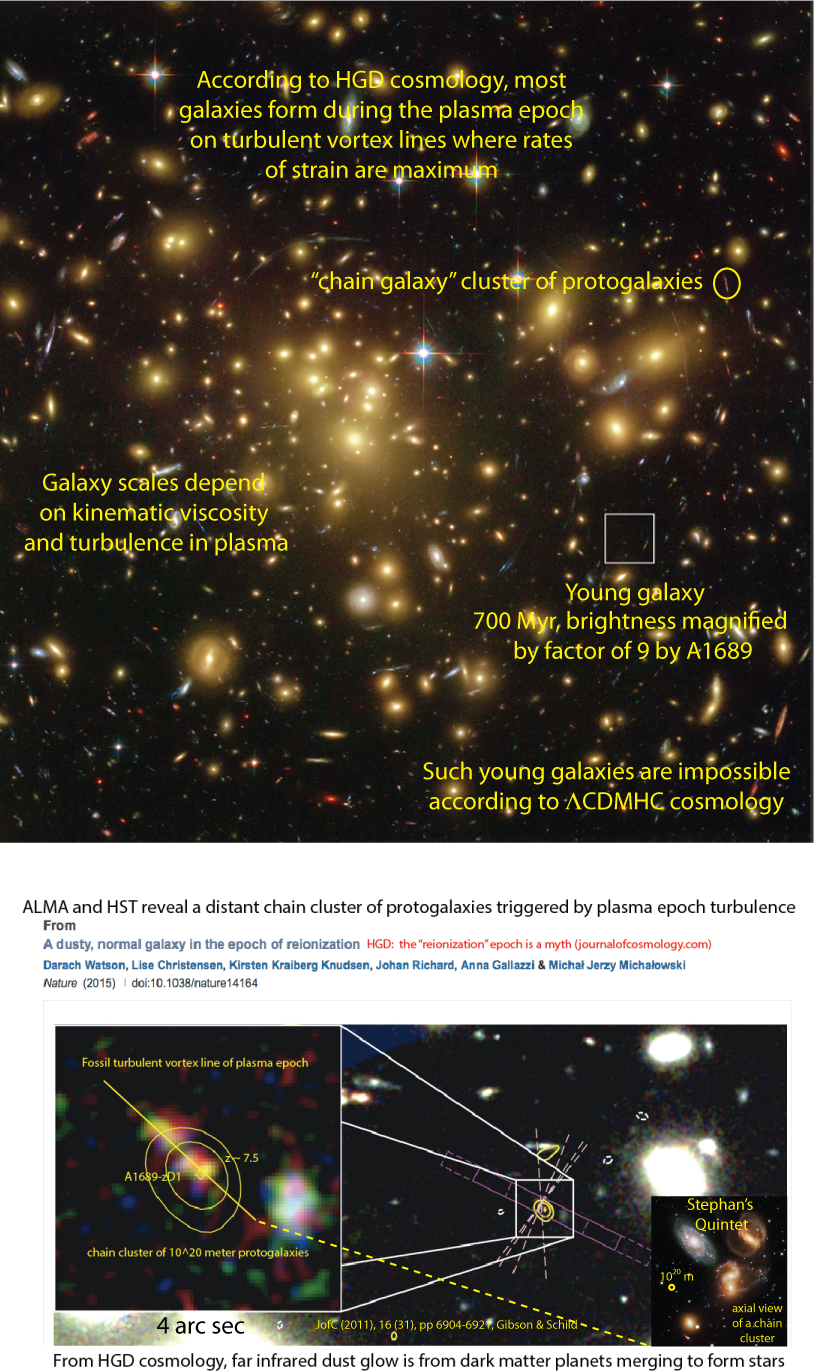
Figure JC2015.24.22.1 CHG: The massive A1689 supercluster (~1000 galaxies at the top) magnifies by a factor of nine the light of a distant chain cluster with redshift 7.5+/-0.2, fully exploiting ALMA and HST. According to the Darach Martin et al. (2015 Nature) paper, A1689-ZD1 would otherwise be invisible. Rather than a single glalaxy (A1689-ZD1) the object appears to be a chain cluster of four plasma epoch protogalaxies before their separation by the expansion of the Universe. From HGD cosmology, galaxies fragment (at the viscous Nomura, Kolmogorov, 10^20 meter scale) along turbulent vortex lines (where strain rates are maximal) early in the plasma epoch (~30 000 years). The large rates of strain on vortex lines accelerate the mergers of gas dark matter planets to form the first stars. Plasma protogalaxies serve as sticky fluid particles to form superclusters like Abel 1689 in turbulent boundary layers of expanding supervoids, just before transition to gas (~300 000 years). The young galaxy chain cluster is only about 5x10^20 meters long, and glows in the infrared from mergers of PFP (primordial fog particle) dark matter planets in their PGC (proto-globular-star cluster) clumps to form stars (Fig. 1ab of the Gibson and Schild 2011 reference). Such linear chains can be seen end on (axially) in Hickson compact groups such as HCG 92 Stephan's Quintet (lower right). The nearest galaxy of the five is blue because it is at redshift only z = 0.003, ten times smaller that some of the others with z > 0.03. The length of the galaxy cluster chain is > 10^24 meters due to the expansion of the universe, Gibson and Schild (2007). The remnant 10^20 m diameter Nomura scale of the plasma protogalaxies (yellow circle) is preserved by a region this size of old stars. The galaxies expand to Schwarz diffusion scales ~ 10^22 m as the hydrogen of the PFP dark matter planets freeze, and their PGC clumps become weakly collisional. LCDMHC cosmology cannot possibly explain these observations of galaxies, chain clusters and superclusters of plasma protogalaxies at redshift z = 7.5. Dark ages and Reionization concepts mentioned by Martin et al. (2015) are rendered obsolete by the ALMA-HST-Martin et al. (2015) observations, p 12333.
22. 1 Signal Magazine will publish a Catastrophic Equatorial Icing event article in its May 2015 Issue.
This paper has been moved to the Catastrophic Equatorial Icing-dedicated Volume 28
23. A new look at microlensing limits on dark matter in the Galactic halo, M.R.S. Hawkins (2015) arXiv preprint.
Figure JC2015.24.23.1 CHG. What dominates the mass of the Milky Way Halo? Answer: Clumps of Earth-mass and larger gas planets.
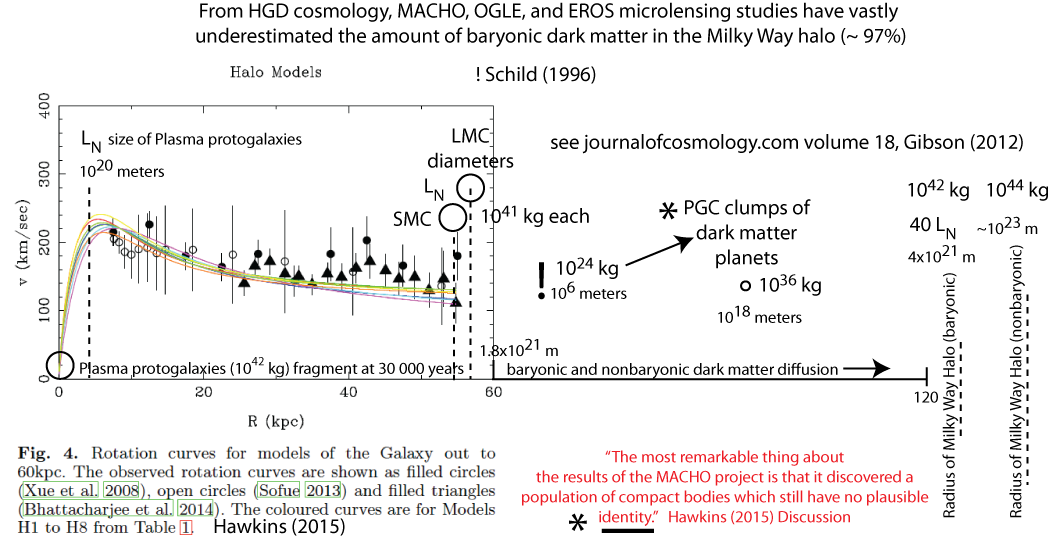
Hawkins (2015) documents many factors causing the MACHO etc. studies to underestimate the contribution (~ 97%) of Earth-mass dark matter planets (PFPs) to the mass of the Milky Way Galaxy, by a factor of ~ 10^7, as shown by Schild (1996), Gibson (1996), and HGD cosmology. An important HGD prediction affecting the MACHO study is the concentration of PFP planets in PGC (proto-globular-star-cluster) clumps, rather than the erroneous MACHO study assumptions that Massive Compact Halo Objects are distributed uniformly (PFPs are clumped in PGCs), and that MACHOs may be non-baryonic (they are entirely baryonic). It is not a coincidence that the LMC size matches that of the 10^20 m Nomura scale core of old stars. The LMC and SMC galaxies both have this size. LMC and SMC are massive clumps of PGC clumps of PFPs that reflect the time (at temperature 13.8 K) when PGCs became relatively collisionless by hydrogen gas freezing, shrinking PFP planets from 10^14 m to only 10^7 m. Then the LMC and SMC diffused away from the 10^20 m central core, with ~ 10% of the baryonic Galaxy mass each. See journalofcosmology.com vol. 18, Frontispiece. Other clumps-of-PGCs (dwarf spherical galaxies) and individual PGCs have since diffused, on freezing, to form the Halo radius of ~4x10^21 m shown in the Figure at the right. The HGD scenario is confirmed by Herschel, Spitzer, and Planck infrared space telescopes, Gibson (2012). From HGD cosmology, MACHOs are PFPs and binary merged larger planets, eg. Jupiters, that form the stars by binary merging within PGC clumps of a trillion PFP planets.
Both the baryonic and nonbaryonic dark matter have diffused from the 10^20 m plasma protogalaxies to form larger, and separate, Milky Way halos. The Tadpole galaxy shows star formation triggered in the central galaxy halo as fragments of another galaxy merge (Gibson 2008). HST images also reveal a sharp boundary (no stars) outside the 40 L_N radius. Clearly, MACHOs are baryonic, not HC clumps of CDM. Carr-Hawking-Hawkins (2011) primordial black holes are baryonic dark matter candidates, but are weakly collisional like CDMHC clumps, and belong in the obsolete "Old Cosmology" category from their strong diffusivity.
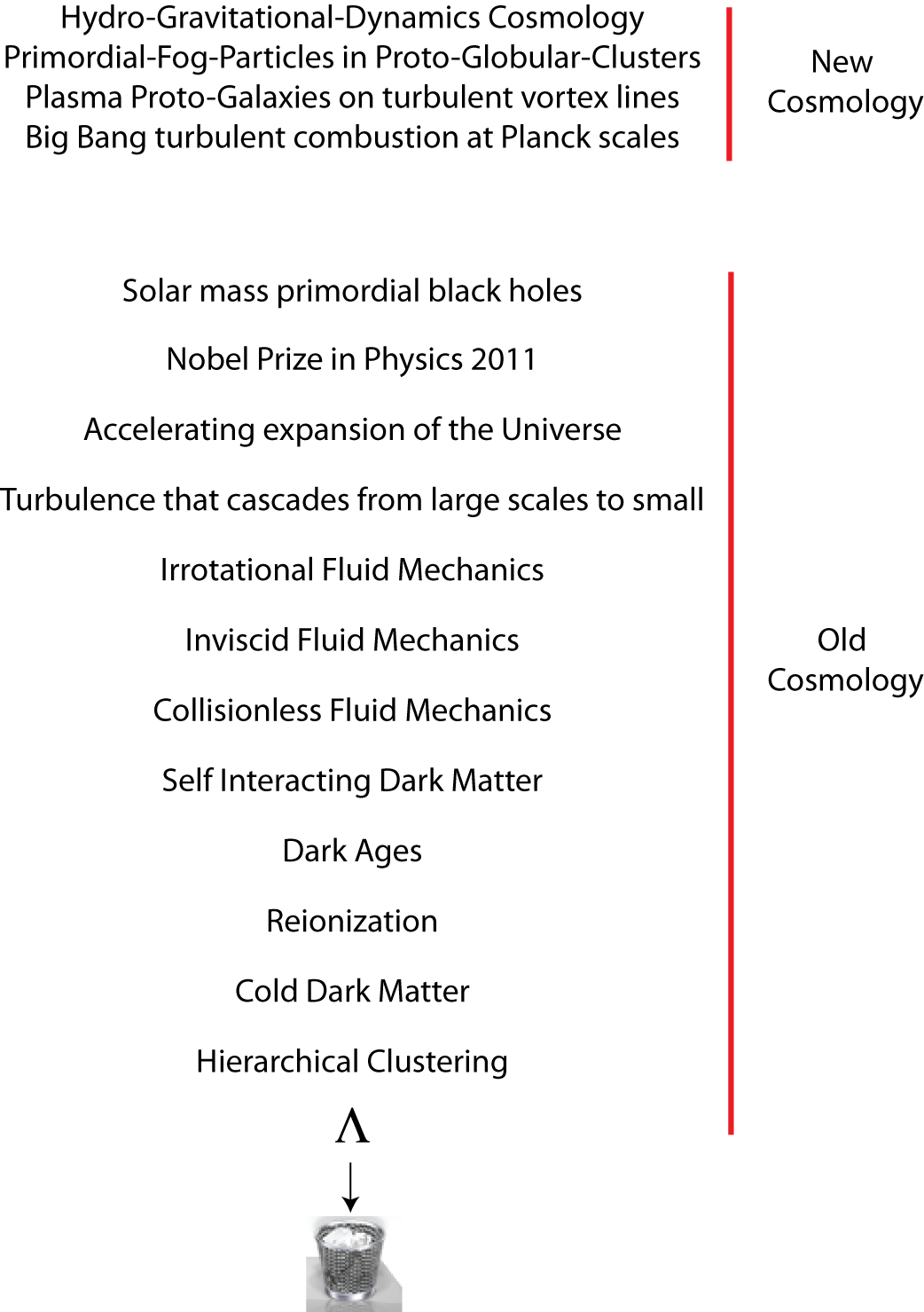
Figure JC2015.24.23.2 CHG. HGD cosmology predicts a baryonic dark matter halo for the Milky Way, as observed (eg.: Schild 1996 etc.).
25. The Planck Vacuum, William Dayton, www.planckvacuum.com. This amazing series of papers convincingly describes the vacuum as a dense sea of spinning Planck-antiPlanck particle pairs kept in equilibrium by van der Waals forces. HGD cosmology big bang turbulent combustion begins with one such particle pair. Commentaries are invited (CHG).
26. Cratering, Momentum Coupling and Enhancement in Thick Targets, John L. Remo, Harvard University, Preprint version, pp 12336-12362.
Discover Magazine article on Dr. Remo's concerns about dangerous asteroids, and how mankind might deal with the otherwise inevitable catastrophies.
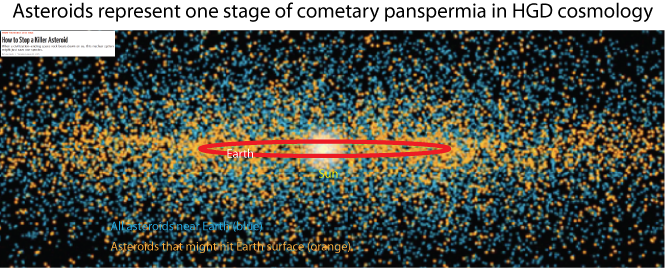
JC2015.26.1 CHG: Can Extraterrestrial Civilizations Survive Cometary Panspermia? Comets bring life to Earth-like planets but ultimately will bring death. How long can the most advanced civilizations prolong their lives by the technology they invent, or is it more likely they will first destroy themselves or each other? The blue asteroids in the figure are too small to be dangerous and may bring useful life forms protected by water in small meteors (eg: red rain, diatoms). The orange asteroids may wipe out all life forms that cannot protect themselves from catastrophic extinction events.
27. God is a Vacuum Fluctuation, Michael D. Forrest, Ph. D., UK. pp 12363-12370.
28. How is water produced in the early universe to foster life formation?, Carl H. Gibson, commentary on Bialy et al. (2015), pp 12371-12382.
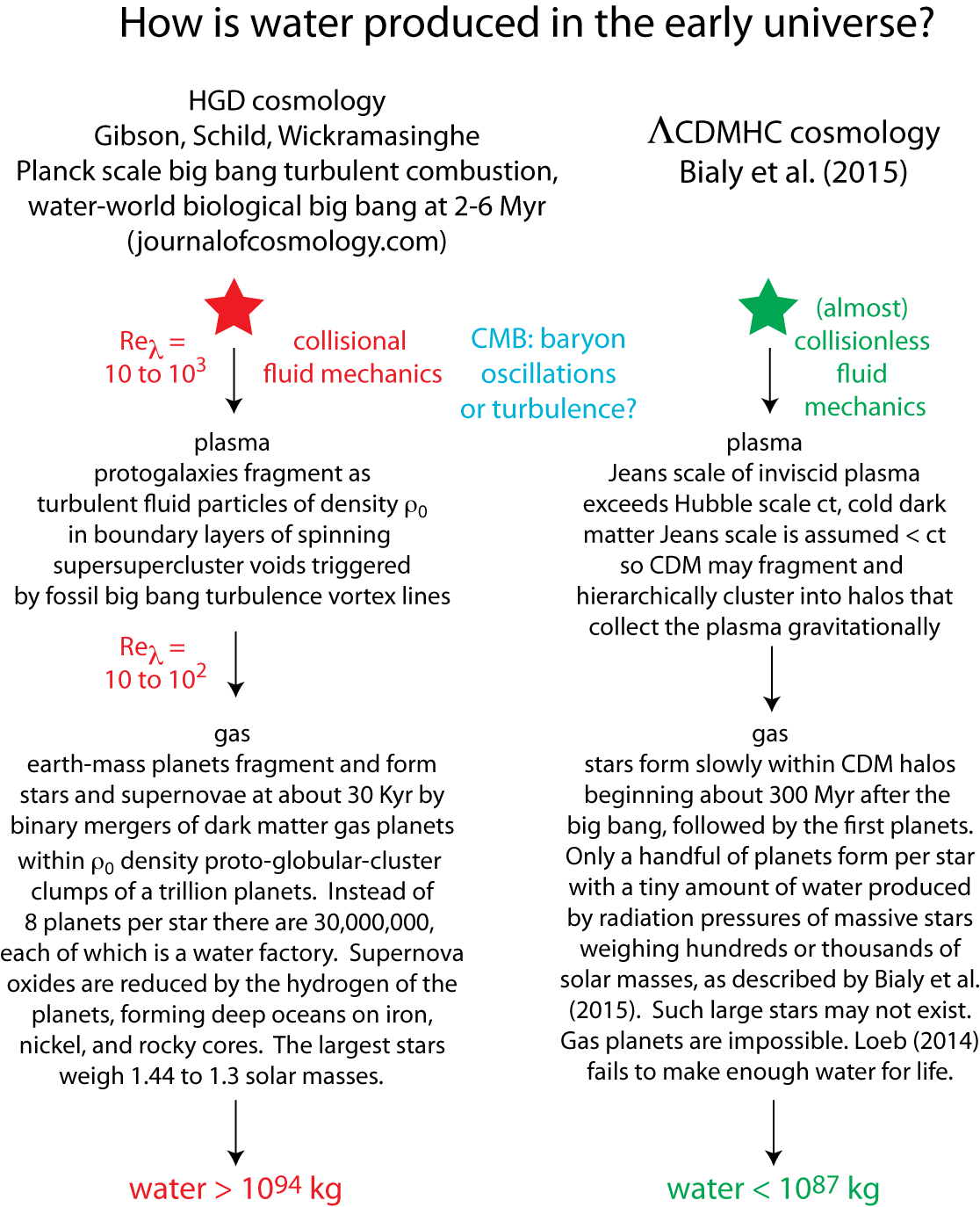
Figure JC2015.24.28.1 CHG. Bialy et al. (2015) attempt to produce enough water to foster life in the early universe by invoking radiation pressures from massive Population III stars. These 10^2 to 10^3 solar mass stars were hypothesized by LCDMHC cosmology to re-ionize the universe after the plasma to gas transition, and explain the missing hydrogen; since found in clumps of dark matter planets of a galaxy by Schild (1996), as expected from fluid mechanics, Gibson (1996). Re-ionization never happened, and neither did massive stars. White dwarf carbon stars form gradually and explode as supernova I events when they exceed 1.44 solar mass. O and B star Supernova II precursors form rapidly and are enormously bright, but never exceed 1.3 solar mass (see JC2014.24.5.2). O and B stars are observed in bright dense strings along turbulent vortex lines of merging dark matter planets as they plunge toward dense star forming regions (see JC2014.24.5.5). Massive stars needed by Bialy et al. (2015) and Loeb (2014) to make water and life are mythical according to HGD cosmology (see JC2014.24.9.4).
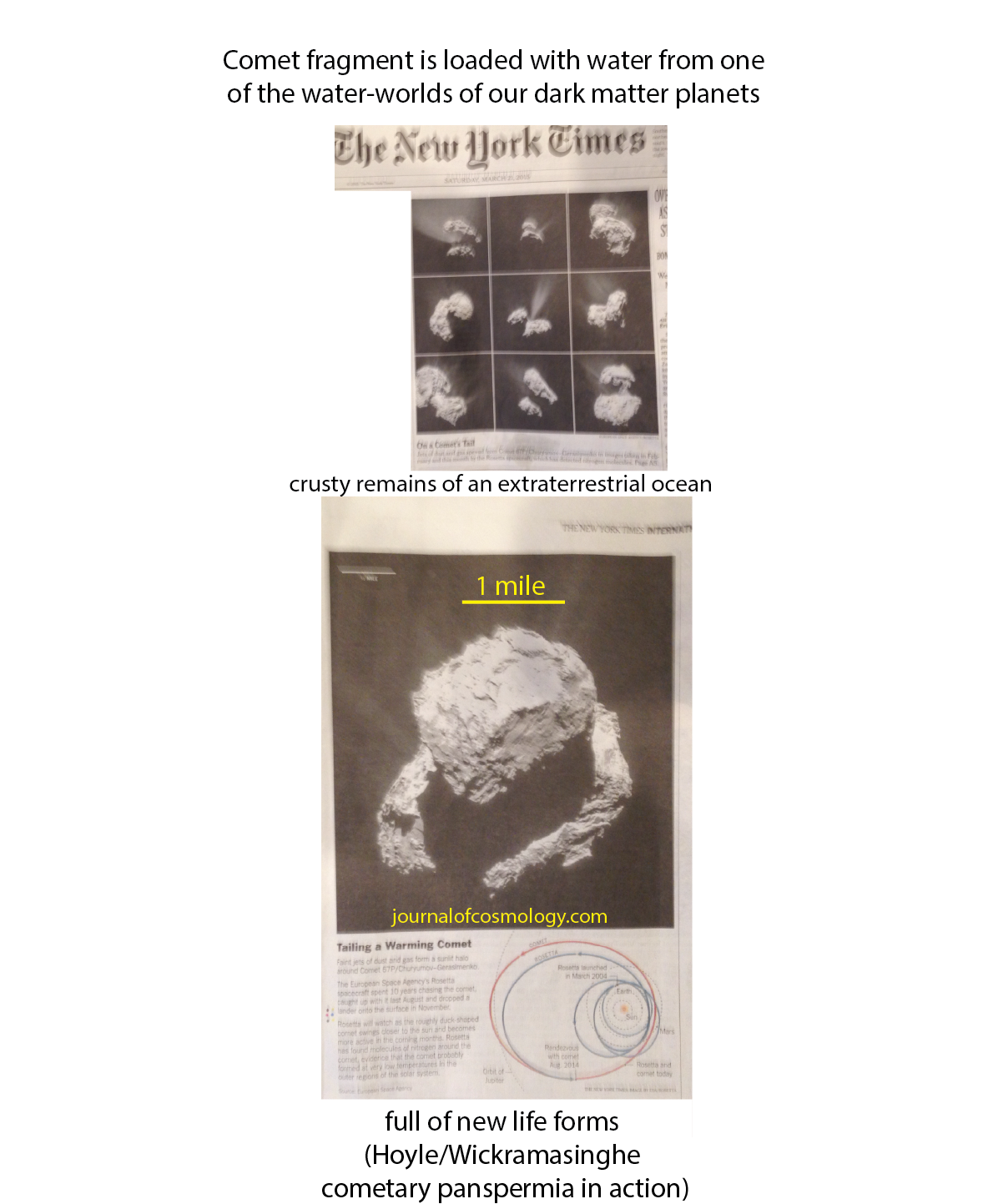
29. Orbital Debris Remediation: Technical, Economic and Policy Issues, Prof. John L. Remo, Harvard University and Harvard-Smithsonian, Cambridge, MA, USA. pp 12383-12401.
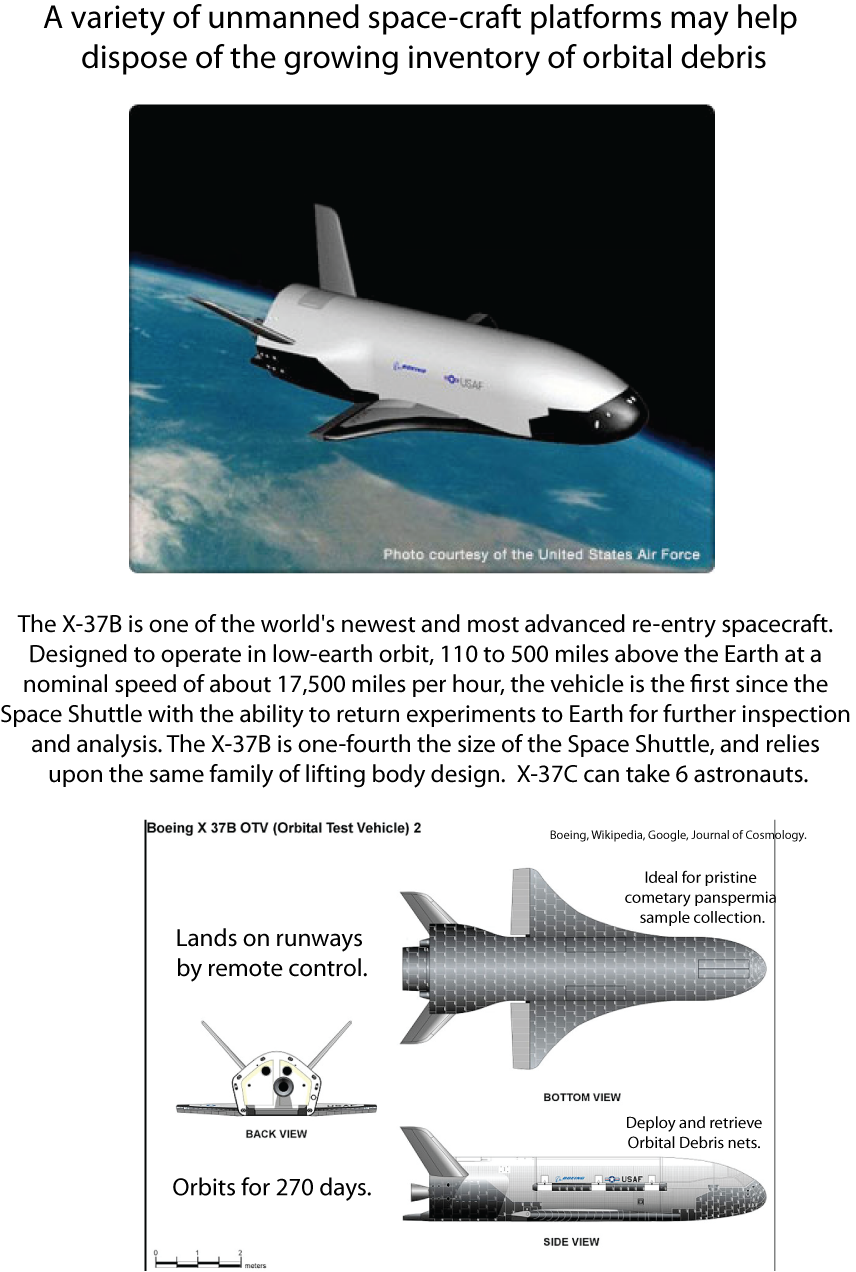
Figure JC2015.24.29.1 CHG. The Boeing robotic space-plane series has been successfully tested in at least three missions. Horizontal and vertical launch modes were possible. Astronaut passengers are anticipated in future pressurized pods in cargo bays. Obital Debris collection schemes include reversably expandable nets and solid "bulldozer" frames that protect the space-plane and supply solar energy. Long-term, pristine, sample collection of the extra-terrestrial biological materials of Hoyle/Wickramasinghe cometary panspermia, astro-biology, and astro-medicine, would be among the highest priority scientific experiments. pp 12408-12409.
30. Apparent magnitudes of high redshift Type 1a supernovae and intergalactic graphite whiskers, N.C.Wickramasinghe · J.T. Wickramasinghe. Reprint discussing graphite whiskers as a possible alternative to the physically surprising accelerated expansion of the universe powered by dark energy anti-gravitational forces, based on LCDMHC cosmology. pp 12410-12420.
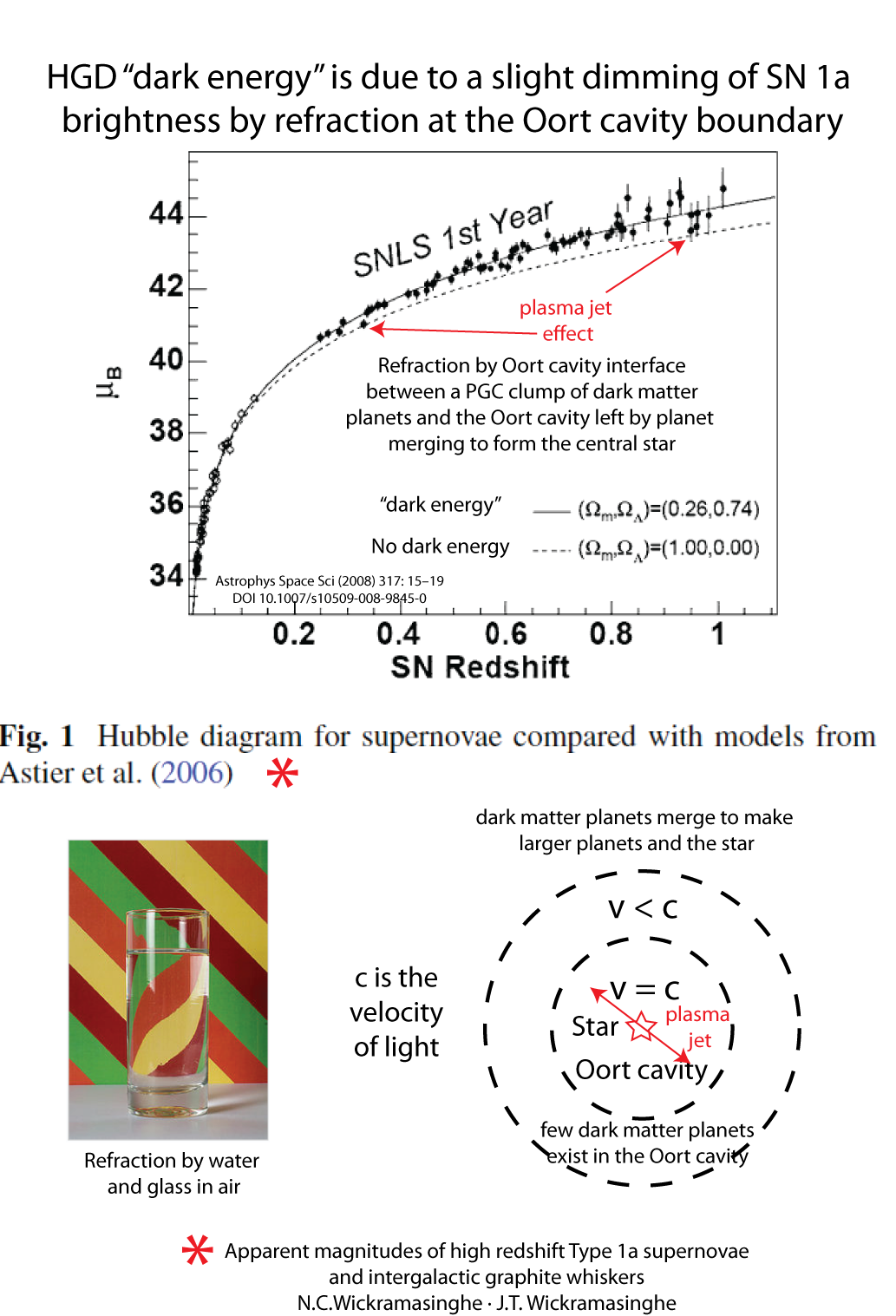
Figure JC2015.24.30.1 CHG. Powerful plasma jets from the spinning central carbon star (or binary star) push back the Oort cavity interface. This reduces the refraction effect of the dark matter planet density interface, giving an effective "no dark energy" unobstructed path for the brightness of Supernova Ia events. From HGD cosmology, "dark energy" is an unfortunate systematic dimming error resulting from LCDMHC ignorance of the existence of dark matter planets in PGC clumps as the source of all stars. Most Oort cavities are the same size (3x10^15 m radius) because all PGCs have the same density and most stars have the same mass (~ solar). pp 12421-12422.

Figure JC2015.24.30.2 CHG. Turbulent mixing refractive iindex wake of a jet aircraft in front of the April 4, 2015, "blood moon". This illustrates similar optical dimming, by star plasma jets, of SN 1a events. The dimming was unfortunately mistaken for accelerated expansion of the universe driven by the antigravity force of dark energy Lambda. The 2011 Nobel Prize in Physics is falsified by this systematic dimming error due to refraction of light by the Oort cavity interface. The expansion of the universe is not accelerating. There is no antigravitational force of dark energy driving the accelerating expansion rate. There is no dark energy. Lambda = 0, as shown in the Figure.
31. "Very Massive Stars Do Not Exist", Editorial Commentary by Carl H. Gibson, Commented arXiv Preprint, "Identifying Stars of Mass > 150 M_solar from Their Eclipse by a Binary Companion", Tony Pan, Abraham Loeb, Harvard-Smithsonian. Is the limit to stellar mass only 30 % to 40 % larger than solar mass?, as indicated by HGD cosmology and available observations. No evidence is presented by Pan and Loeb that very massive stars exist, or even massive stars. Numerical simulations and theories are presented that explain how an eclipsing binary very massive star might appear if one existed. HGD cosmology suggests none exist, and none have ever existed.
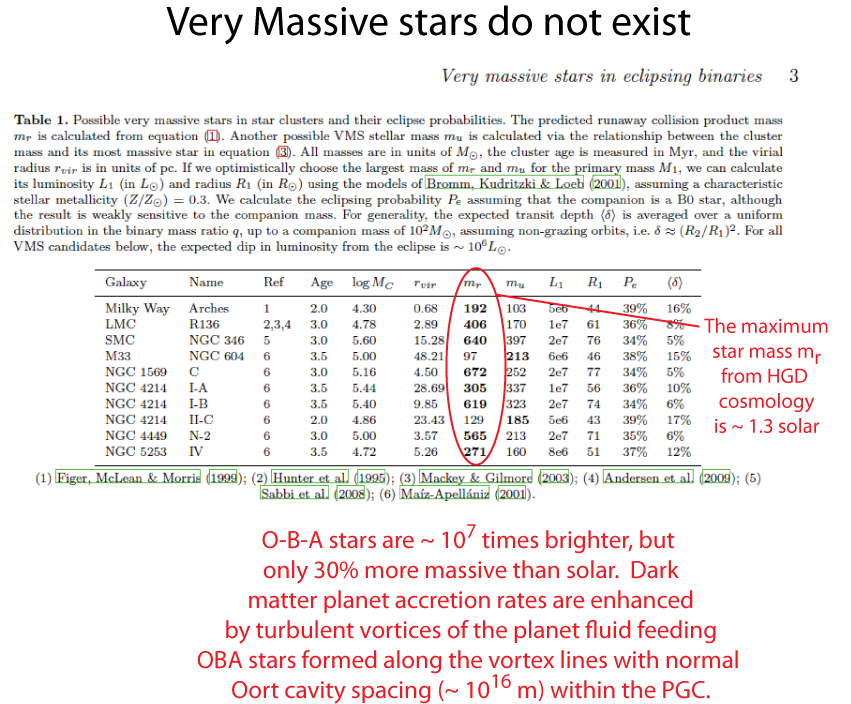
Figure JC2015.24.31.1 CHG. The estimates of thousand solar mass stars are entirely speculative, based on LCDMHC cosmology, and never exist, or have existed, according to HGD cosmology. Observations with infrared telescopes show turbulent filaments with strings of bright O-B-A stars within PGCs separated by Oort cavity sizes ~ 10^16 m: much smaller than expected if the stars were massive. See Figure JC2014.24.5.5 CHG. The "standard" Hertzsprung Russell diagram from LCDMHC cosmology is incorrect and misleading. See JC2014.24.5.1 CHG for the HR diagram appropriate to HGD cosmology.
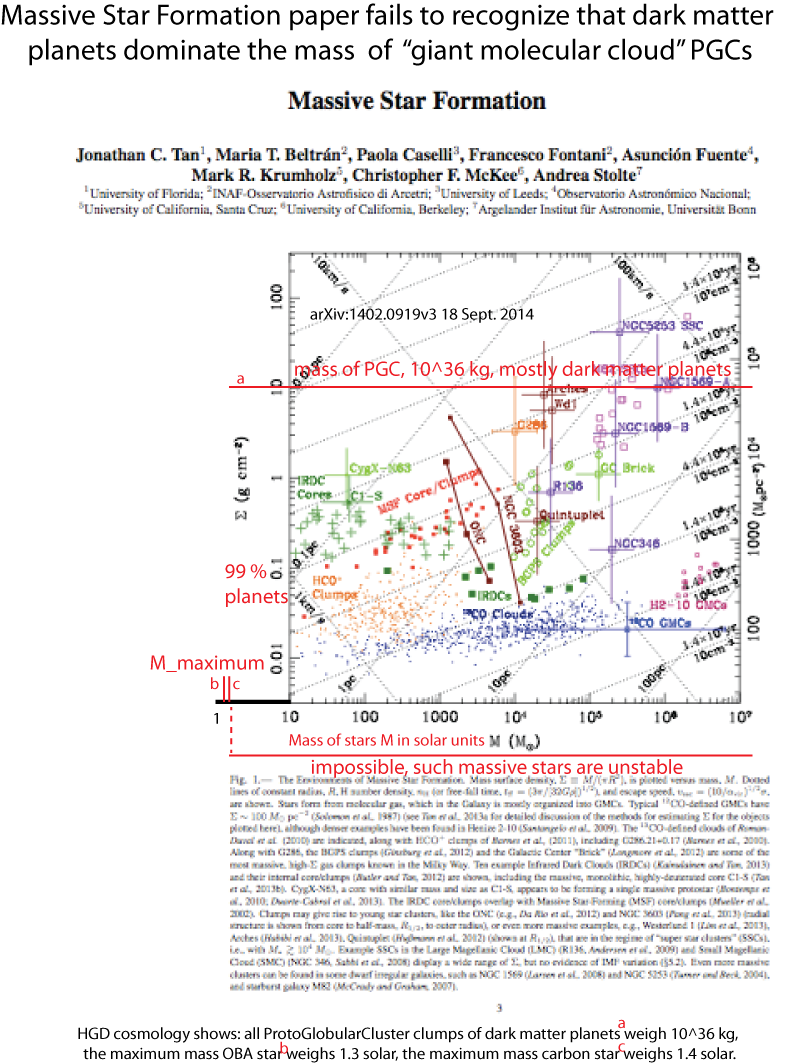
Figure JC2015.24.31.2 CHG. This figure derived from Fig. 1 of Tan et al. (2014) is intended to support massive stars, but does not. From HGD cosmology, only a small fraction of the dark matter planets in a PGC clump exists as gas. All PGCs have the same density rho_0, dominated by dark matter planets that reflect the time of first baryonic fragmentation 10^12 seconds (30,000 years) after the big bang and the other parameters of the turbulence then. The value rho_0 ~ 10^-17 kg m^-3 is that of all globular star clusters, and protoglobularstar clusters PGCs (a top, footnote). Peebles is credited with this estimate by Weinberg in his books. The interstellar medium consists almost entirely of dark matter planets, Schild (1996), which merge to make larger planets and stars, but not massive stars. Infrared telescopes show star formation along cold filaments with temperature 13.8 K, the triple point of hydrogen, thus reflecting the binary mergers of frozen Earth-mass gas planets by these "cold core" stars. The massive stars proposed by Tan et al. (2014) cannot possibly be condensed from interstellar gas and dust. Only dark matter planet mergers make stars, and these small stars weigh at most 40 % more than solar mass for carbon stars, and 30 % more than solar mass for OBA stars, as shown in the figure (left b,c). Star formation time constants reflect the density of PGCs (30,000 years) not interstellar gas (hundreds of Millions of years). Massive stars are a myth of Old Cosmology, and never happened. See Figure JC2015.24.23.2 CHG. pp 12423-12449.
32. ALMA LONG BASELINE OBSERVATIONS OF THE STRONGLY LENSED SUBMILLIMETER GALAXY HATLAS J090311.6+003906 AT Z=3.042, ALMA PARTNERSHIP, C. VLAHAKIS et al. (2015), Commented by Carl H. Gibson. pp 12754-12764.
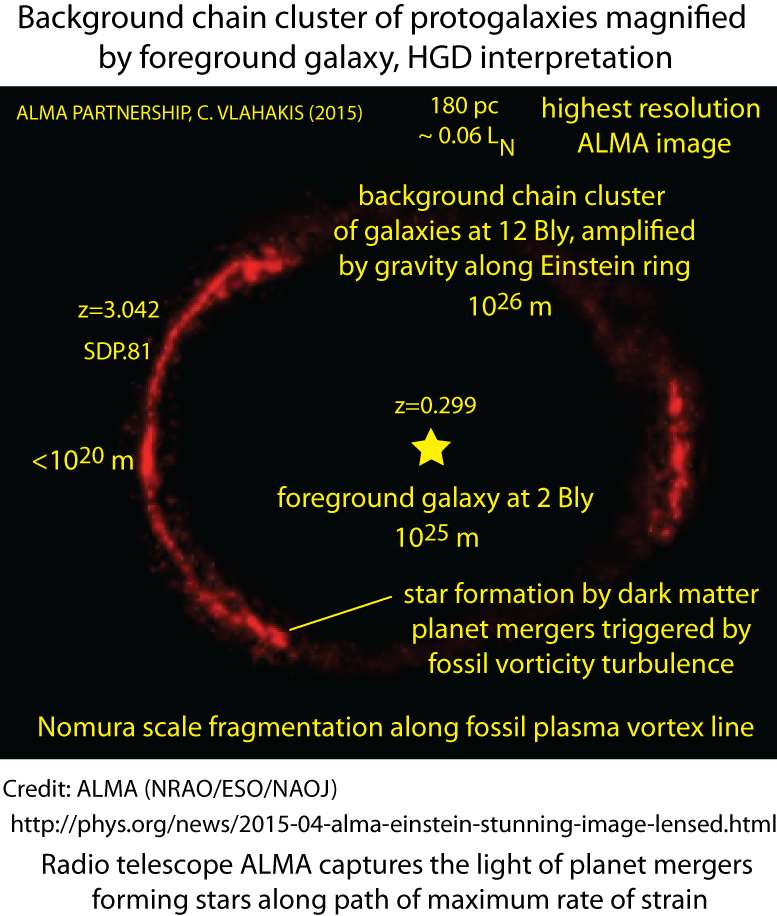
Figure JC2015.24.32.1. CHG. HGD interpretation of the ALMA highest resolution image of a distant "galaxy". The ALMA baseline scale ( ~ 15 kilometers) permits excellent resolution. The "galaxy" is not just one galaxy but a chain cluster of galaxies, formed during the plasma epoch by fragmentation of protogalaxies at the Nomura-Kolmogorov scale (L_N = 10^20 m) along a turbulent vortex line, where the rate of strain will be a local maximum. During the gas epoch the first stars appear along such fossil vorticity turbulence lines. Dark matter planets merge to form larger planets and finally stars, both in the plasma epoch protogalaxies and in the ~ 10^18 m PGC clumps of < 10^14 m hydrogen PFP planets left between the protogalaxies as they are separated by the expansion of the universe. Approximately six protogalaxies are in the chain cluster detected here by ALMA.
The hydrogen dark matter planets form water oceans and DNA-RNA life in the oceans by reducing the oxides of metals and carbon from supernovae. ALMA scientists have detected such chemicals in abundance, but mistake the synthesis as abiotic (Karin I. Oberg et al. Nature 520, 198-210, (09 April 2015), doi:10.1038/nature14276). See another early chain-galaxy-cluster in Figure JC2015.24.22.1 CHG. Commented version of the Oberg et al. Nature Paper "The comet-like composition of a protoplanetary disk as revealed by complex cyanides", CHG.
33. "The Unraveling of Dark Energy", Editorial Commentary by Carl H. Gibson, Commented version of Milne et al. 2014 Preprint, The Changing Fractions of Type Ia Supernova NUV-Optical Subclasses with Redshift, Peter A. Milne, Ryan J. Foley, Peter J. Brown, Gautham Narayan: CHG. pp 12508-12531.
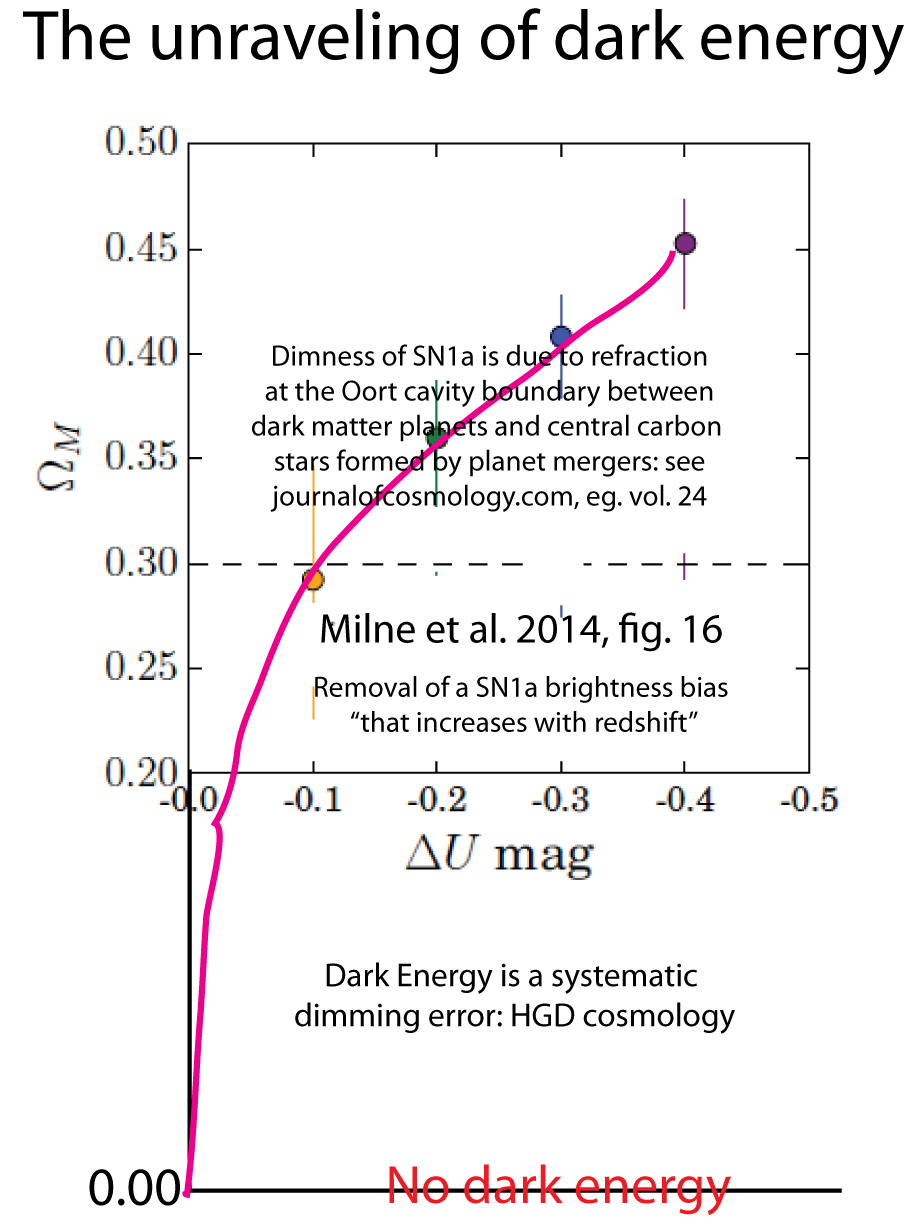
Figure JC2015.24.33.1. CHG. The Milne et al. preprint (2014) shows that dark energy is very sensitive to small biases in SNe 1a dimness. See Figure JC2015.24.30.1 CHG. HGD cosmology suggests the extrapolation should be to zero dark energy from the refraction effect of the Schild (1996) dark matter planets at the Oort cavity interface. The dark energy concept extrapolates the failed LCDMHC cosmology to redeem the Einstein constant L (Lambda). Einstein introduced L to provide an anti-gravitational force to constrain the expansion of the universe. Once Einstein realized that the universe was indeed expanding, he dropped L from his general relativity idea as his biggest blunder. L has no physical basis. As shown by Gibson (2004, 2005), inertial vortex forces of turbulent combustion explain the anti-gravitational accelerations of the big bang, and leave their characteristic signature at the largest scales of the CMB. The dimming of supernova 1a events is easily explained by the hot (3000 K) hydrogen planets in clumps of a trillion that emerge from the plasma epoch. These form all the stars by mergers, and surround the cavities left by the mergers, causing dimming by refraction from the cavity density gradient. All the clumps of planets have the same density rho_0, which is the baryon density in the plasma epoch at the time of the first fragmentation at 10^12 seconds (30,000 years) after the big bang: ~ 3x10^-17 kg m^-1. From this and the mass of a binary star the cavity size is ~ 6x10^15 meters in diameter. This Oort cavity size has been observed in the Milky Way and in all nearby galaxies. Schild (1996) is right. The dark matter of all galaxies is earth mass hydrogen planets, as predicted from fluid mechanics by Gibson (1996). Cold dark matter does not exist and cannot clump or hierarchically cluster, and dark energy does not exist either. Because LCDMHC cosmology is untrue, the unraveling of dark energy as shown by the extrapolation of Milne et al. 2014, fig. 16, in JC2015.24.33.1, is inevitable.
Figure JC2015.24.33.2. CHG. The infrared telescopes Planck and Herschel show the formation of stars within PGCs occurs at cold cores. The temperature 13.8 K suggests the planets are frozen hydrogen, confirming the HGD cosmology prediction. The size ~ 6x10^15 m reveals the constant density of all PGCs to be rho_0, the HGD cosmology fragmentation density of the plasma epoch at 10^12 seconds after the big bang.
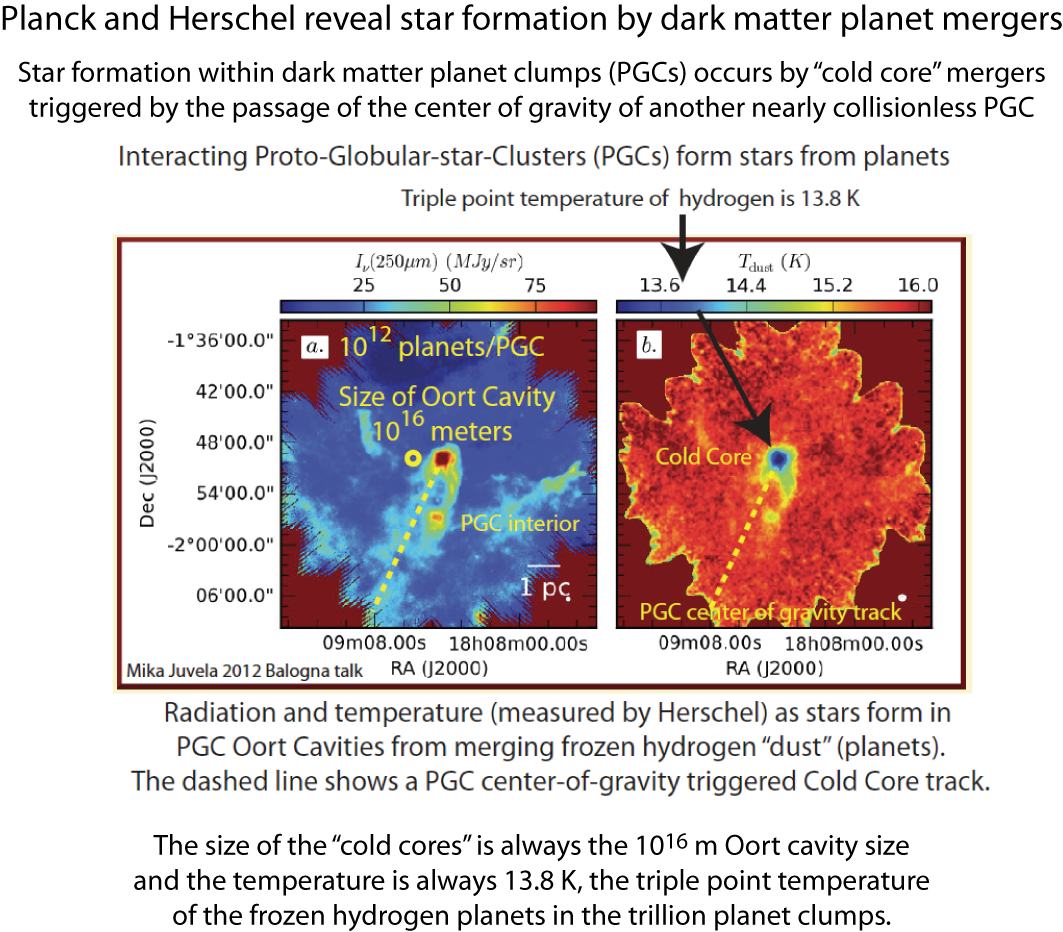
The Oort cavity size is compared to the cold core size in the left image (from Planck), yellow circle. Tidal forces of the PGC center of gravity agitate the dark matter planets along its course, increasing their atmosphere sizes and binary capture cross sections from ~ 10^14 m^2 to as much as ~ 10^28 m^2. The image is from a presentation at a 2012 meeting in Balogna by Dr. Mika Juvela about cold cores and other key features of the Planck and Herschel data sets. (Annu. Rev. Astron. Astrophys. 2009. 47:427–80, commented by CHG). The authors appear to be unaware of HGD cosmology, Hoyle/Wickramasinghe cometary panspermia, and the biological big bang at 2 million years that explains the "Complex Organic Interstellar Molecules" discussed). Mysterious linear trajectories (dashed lines in the JC2015.24.33.2 figure) are identified by HGD cosmology as tracks of PGC centers of gravity.
34. Commented version of the 2009 Annual Review article "Complex Organic Interstellar Molecules", by Eric Herbst and Ewine F. van Dishoeck, CHG. The Review makes frequent reference to "cold cores", but does not explain the physical implications of the cold core temperature 13.8 K (the triple point of hydrogen, suggesting stars are forming from evaporating hydrogen dark matter planets) at a cold core size 6x10^15 meters that shouts out the density of the trillion planet PGC clump in which the star is formed as a binary star from binary planets. See Figure JC2015.24.33.2. CHG. pp 12450-12507. Masers (CH3OH) show evidence of life infested planets near OBA stars.
Figure JC2015.24.34.1. CHG. HGD cosmology interpretation of Fig. 1 of Herbst and Dishoeck, showing OBA star formation along dark matter planet vortex lines, with life infested planets shown by Masers.
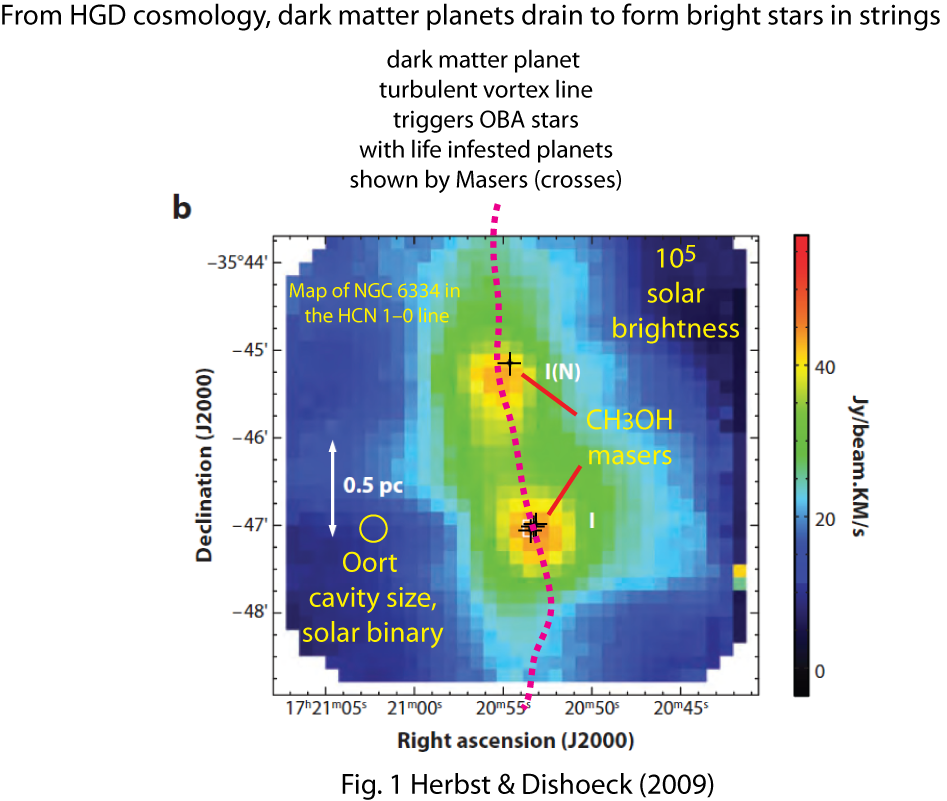
35. New books by N. Chandra Wickramasinghe. The history of cometary panspermia and astrobiology as they evolved, by Journal of Cosmology Senior Editor N. C. Wickramasinghe, who created these fields with Fred Hoyle starting as a graduate student at Cambridge.

36. Commented version of Abraham Loeb and Steven R. Furlanetto "The First Galaxies in the Universe" (2012), Princeton University Press, NJ. by Carl H. Gibson. The first galaxies fragmented during the plasma epoch at 10^12 seconds, fossilizing the baryonic density, size, and rate of strain in identical central proto-galaxies, according to HGD cosmology and all observations. See Figure JC2015.24.22.1 CHG for an image of a string of protogalaxies at redshift 7.5. All the protogalaxies are the same size and were not formed by mergers of smaller protogalaxies as asserted in this book. This book is dead on arrival due to its reliance on LCDMHC cosmology. pp 12508-12606.
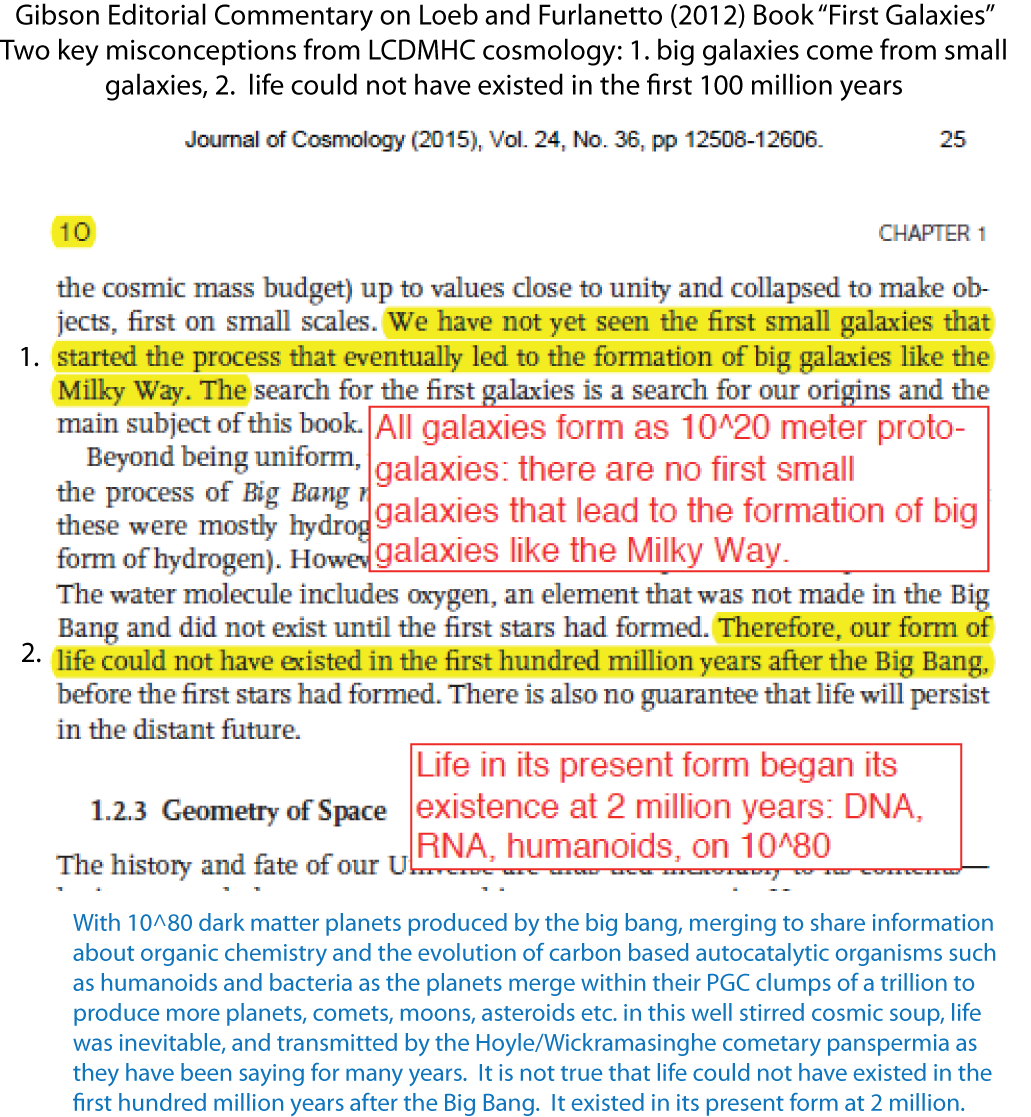
Figure JC2015.24.36.1 CHG. Two blatently incorrect consequences of LCDMHC cosmology are illustrated in this figure. Big galaxies do not form by mergers of small galaxies, point 1, and life in its present form began as soon as it was possible; that is, at 2 Myr (not 100 Myr) when the universe cooled to 373 K so water could condense on ~10^80 earth-mass dark matter planets in Jeans mass PGC clumps of a trillion produced by the big bang by viscous-gravitational fragmentation of the gas at 10^13 s (0.3 Myr): point 2. Gibson comments are in red boxes. Discussion of point 2 based on the obsolete "dark ages" concept from LCDMHC cosmology is in blue. No life anywhere in the universe could exist without the immediate fragmentation of gas into planets in clumps to form stars and supernova stardust. No mention is made of cometary panspermia, now firmly established by N. Chandra Wickramasingne (>300 papers, >40 books) and clinched as an inevitable consequence of HGD cosmology. pp 12607-12608.
37. Commented version of "How did The first Stars and first Galaxies Form?" (2010), Abraham Loeb, Princeton University Press, NJ., by Carl H. Gibson. pp 12609-12618.
38. Commented version of "The Habitable Epoch of the Early Universe" (2014) by Abraham Loeb, published in the International Journal of Astrobiology. Comments by Carl H. Gibson. pp 12619-12623. See "The origin of life from primordial planets", Gibson, Schild, Wickramasinghe, Int. J. of Astrobiology 10(2):83-98 (2011).
39. Commented version of "The Physical Conditions in a Pre-Super-Star-Cluster Molecular Cloud in the Antennae Galaxies", Johnson et al., arXiv:1503.06477v1 [astro-ph.GA] 22 Mar 2015. Comments by Carl H. Gibson, pp 12624-12633.
40. Commented version of "Origin of the Globular Star Clusters" (1968), Peebles and Dicke (ApJ), Effects of Plasma Viscosity: Comments by Carl H. Gibson, pp 12634-12653.
Figure JC2015.24.40.1. CHG. Plasma viscosity and gas viscosity cause fragmentation of the first bound systems (plasma protogalaxies PGs) and second bound systems (protoglobularclusters PGCs) after the big bang: both on fossil turbulence vortex lines, and both with the same baryonic density, as observed.
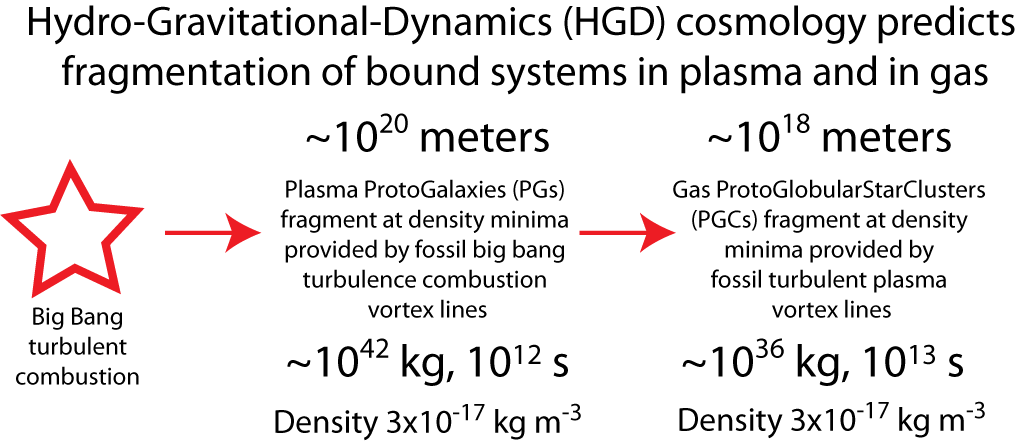
41. Commented version of "Planck intermediate results. XXXVIII. E- and B-modes of dust polarization from the magnetized filamentary structure of the interstellar medium", Polarization reveals dark matter planet turbulence and fossil turbulence filaments, by Carl H. Gibson, pp 12654-12671.
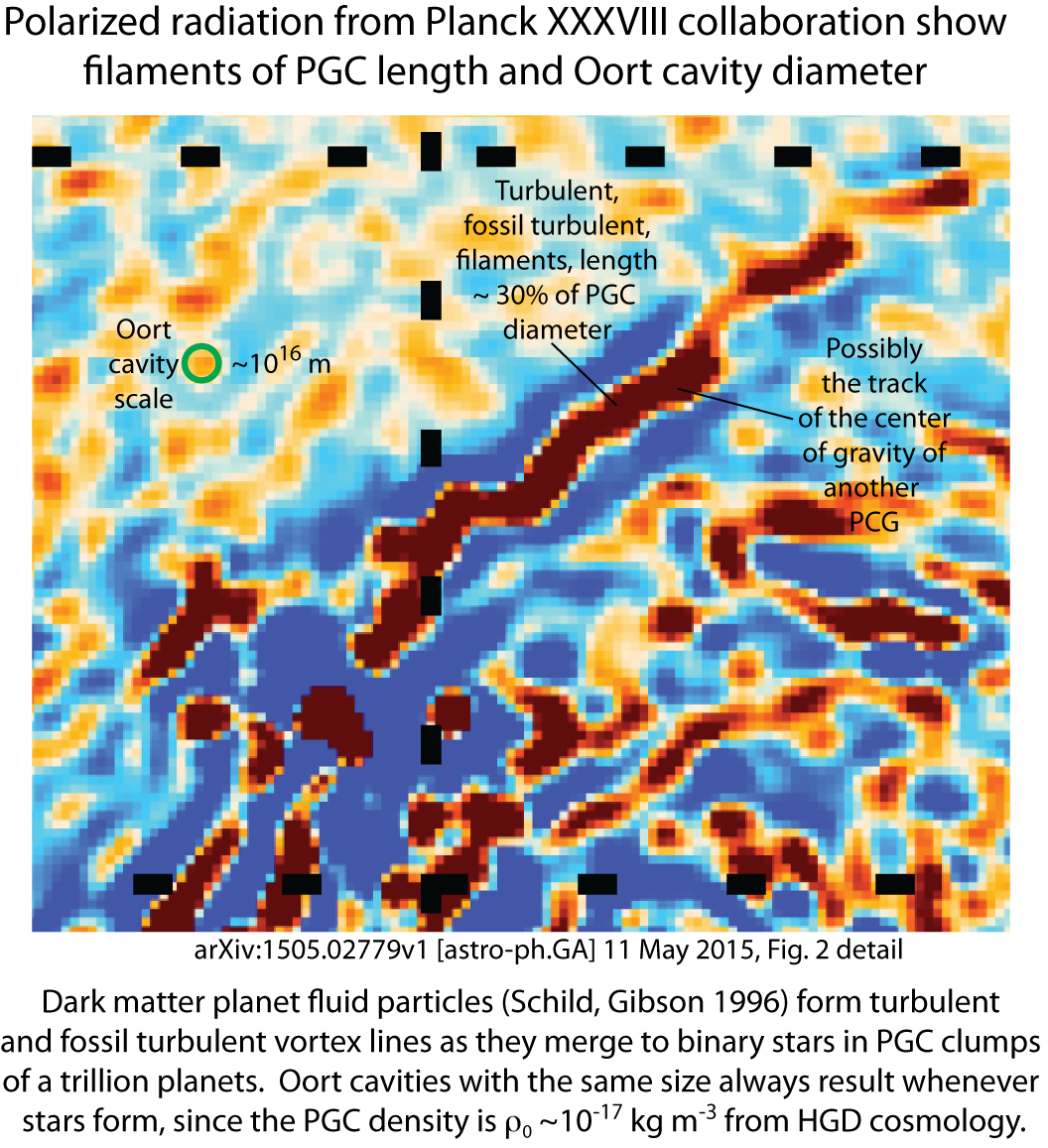
Figure JC2015.24.41.1. CHG. "Dust" polarization results emphasize dark matter planet turbulent and fossil turbulence vortex lines, where star formation occurs by mergers of the planets within PGC clumps. An alternative explanation of the filaments is the passage of a weakly collisional PGC center of gravity, which can also trigger star formation.
42. Commented version of Zhu et al. (2015) A New Dust Budget In The Large Magellanic Clouds, titled "Dark Matter Planets of LMC are Very Dusty", by Carl H. Gibson, pp 12673-12686.
43. Commented version of "Quasar Quartet Embedded in Giant Nebula Reveals Rare Massive Structure in Distant Universe," Hennawi et al., Science, 2015 May 15, Vol. 348, No. 6236, pp. 779-783, titled "Quasar-chain-cluster evidence that plasma protogalaxies were triggered by turbulence", by Carl H. Gibson, pp 12687-12701. Hickson compact groups of galaxies such as Stephan's Quintet can only be observed along fossil plasma turbulence vortex lines such as the dashed line shown in Fig. JC2015.24.43.1.
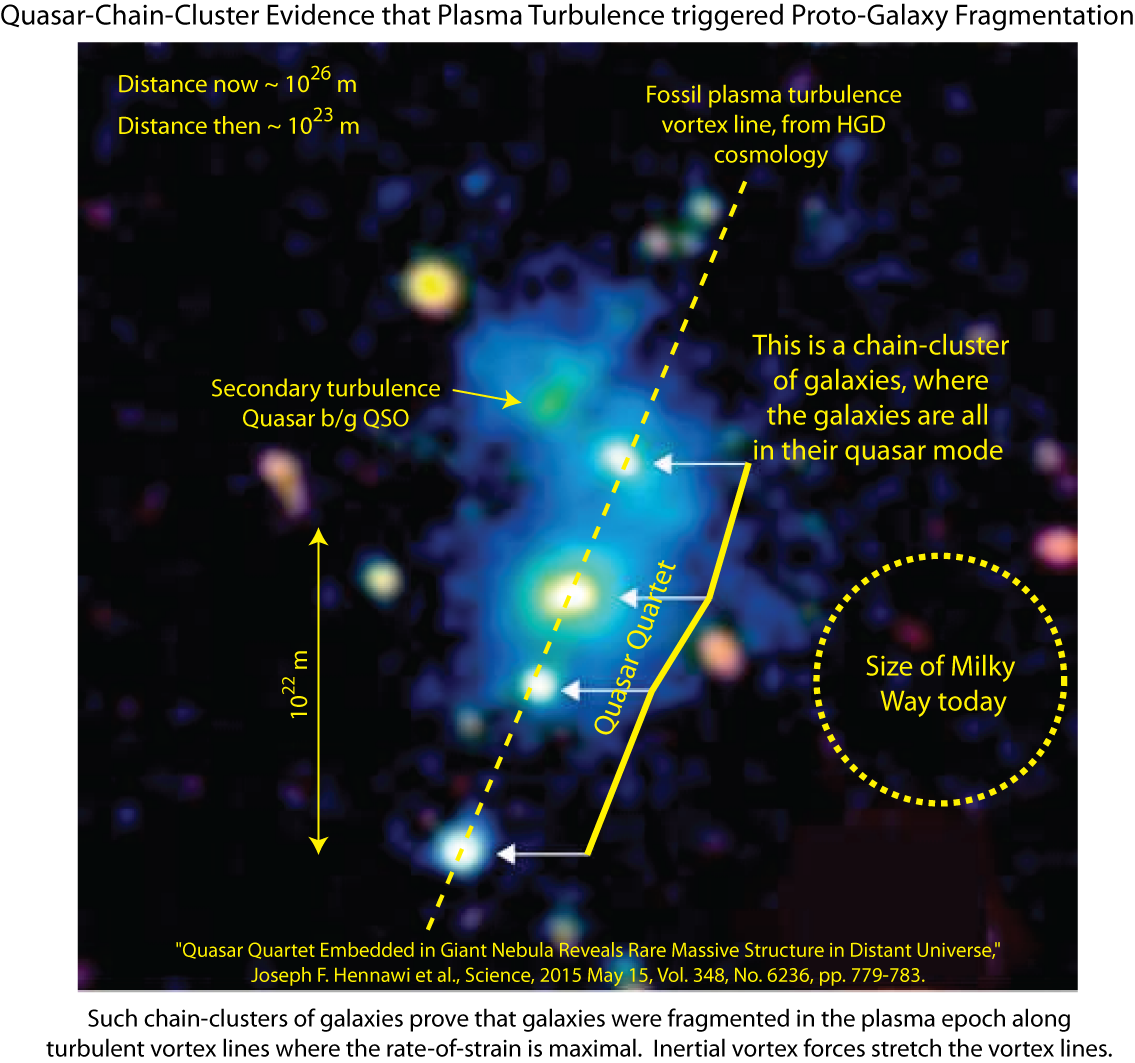
Figure JC2015.24.43.1 CHG. HGD cosmology predicts galaxies begin to fragment early in the plasma epoch (10^12 s) in the turbulent boundary layers of expanding supersupervoids formed on fossil big bang turbulence vortex lines. Protogalaxies fragment along weak turbulence vortex lines to produce chain-clusters of galaxies aligned with fossil plasma turbulence vortex lines, such as Stephan's Quintet. Such alignments support predictions of HGD cosmology, and falsify Lambda-CDMHC cosmology. pp 12702-12703.
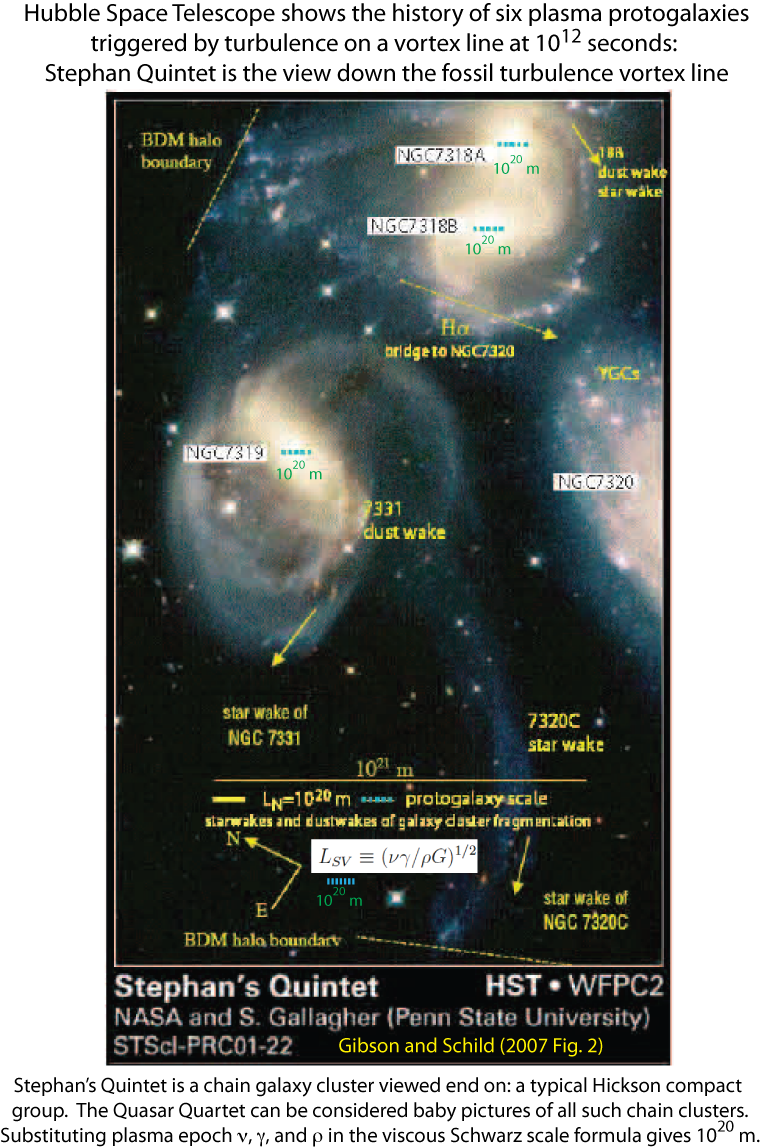
Figure JC2015.24.43.2 CHG. Stephan's Quintet is a chain galaxy cluster where the galaxies are more widely separated than in the Quasar Quartet. Such chain clusters show that all galaxies are fragmented along plasma turbulence vortex lines at the same size and density, because the plasma was quite homogenious. It is easy to estimate the protogalaxy size as 10^20 m because the turbulence was weak, so the viscous and turbulence scales were nearly the same (formula given in white box). Note that secondary turbulence vortices may eject galaxies to the sides of the primary vortex, accounting for the fifth Quasar b/g QSO not in the Quartet, and for the galaxy NGC7320C not in the Quintet. pp 12731-12732.
44. Commented version of "Pilots Face Brick Wall-Like Icing along the Equator", by R. Norris Keeler, Signal Magazine, May 1, 2015.
This paper has been moved to the Catastrophic Equatorial Icing-dedicated Volume 28
45. Interpretation of the Stephan Quintet Galaxy Cluster using Hydro-Gravitational-Dynamics: Viscosity and Fragmentation, Carl H. Gibson and Rudolph E. Schild, arXiv:0710.5449v3 [astro-ph] 31 Oct 2007, pp 12711-12728. Compare to Quasar Quartet (No. 43), Hannawi et al. (2015). Compare also to the chain cluster of galaxies observed using ALMA and HST by Darack Martin et al. (2015), No. 22, Vol. 24, J of C, shown in Figure JC2015.24.43.1 CHG.
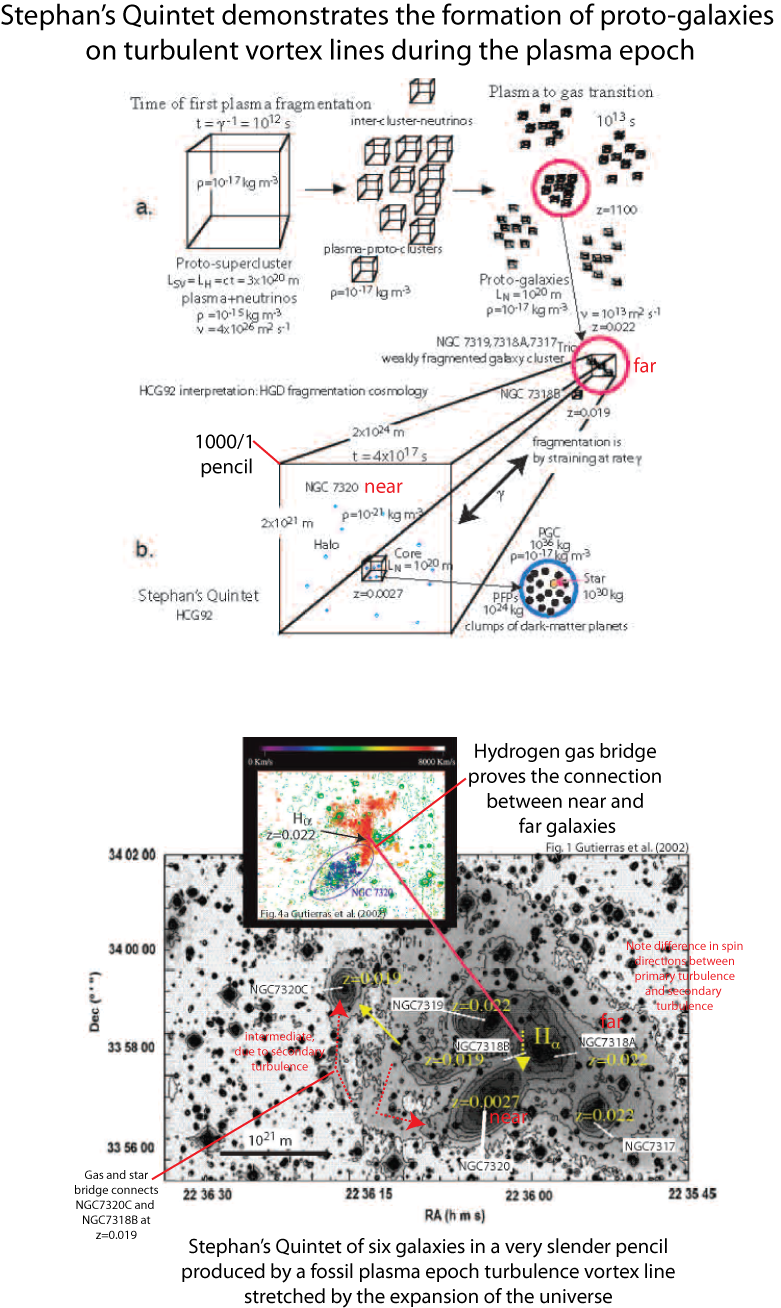
Figure JC2015.24.45.1 CHG. Stephan's Quintet and the Hannawi et al. (2015) Quasar Quartet images leave little doubt that protogalaxies were formed in chain clusters by turbulence early in the plasma epoch, as predicted by HGD cosmology; once again falsifying the standard paradigm LCDMHC cosmology, where no turbulence or viscous effects are possible. pp 12729-12730. Secondary turbulence vortices formed on the primary turbulence plasma vortex, with opposite rotational sense, explains the peripheral galaxy NGC7302C in the Quintet, and the peripheral fifth Quasar in the Quasar Quartet b/g QSO (see Figure JC2015.24.43.1 CHG.) Gas and star bridges show the difference in rotation directions of the primary (counterclockwise) and secondary (clockwise) vortex rotation directions (red dotted lines and arrows) at the time (10^12 s, 3000 yr) when the protogalaxies were fragmenting.
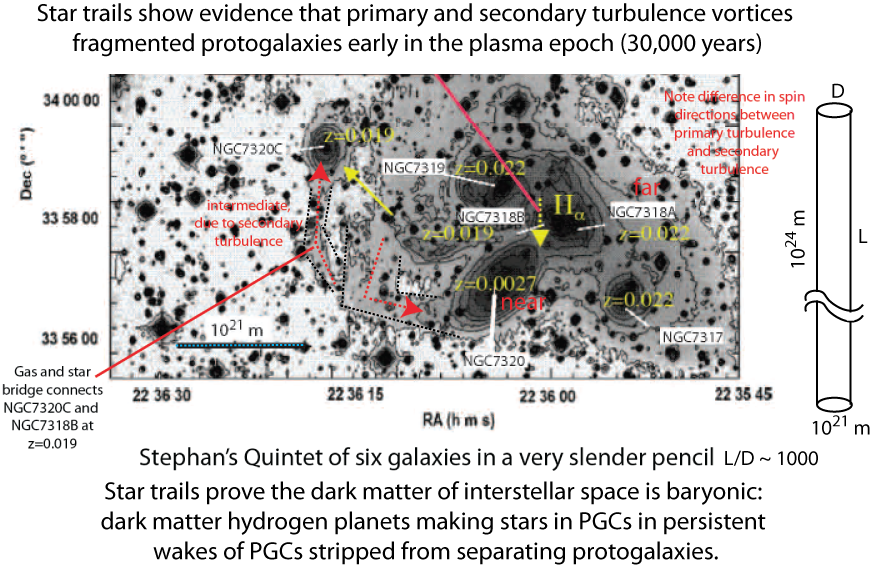
Figure JC2015.24.45.2 CHG. Star trails to NGC7320C from NGC318B, both at redshift z = 0.019, show a clockwise turbulent eddy separated the two when they were plasma protogalaxies, just as the counter-clockwise primary turbulent eddy separated NGC7320 (near) from the other protogalaxies (far) after plasma to gas transition to form the Stephan Quintet Hickson compact group. Dotted black lines outline the fossil turbulence star trail wakes of the separating galaxies. The galaxies are NOT "crashing together", as often stated in descriptions of the Stephan Quintet (NASA etc). Realize that, from HGD cosmology (Gibson 1996, Schild 1996), as many as ten Nomura Scale L_N (10^20 m) plasma protogalaxies will fragment along a plasma turbulence vortex line at 30,000 years when these embryonic galaxies became possible. Physically, the Schwarz viscous, turbulent and Hubble (ct) length scales all approximately converge to the protogalaxy scale L_N when time t increases to ~10^12 s, assuming constant light speed c. Note that ct at 10^12 s is ~ 10^20 m.
46. Formation of Plasma Proto-Galaxies by Turbulent Fragmentation: Quasar Quartet Images of Young Chain-Cluster-Galaxies, by Carl H. Gibson. pp 12731-12739.
47. Comments on "The impossibly early galaxy problem", Steinhardt et al. (2015), by Carl H. Gibson. pp 12740-12748.
48. A Crisis at the Edge of Physics, Comments by Carl H. Gibson, pp 12749-12753.
49. A Mathematical Way to Derive Values for the Universal Constants relating them to the fine
structure constant alpha, (a), as a Continuous Equation Involving pi,(π), and the Square Root of 10. Franklin N. Williams:
Theory Research Institute. pp 12754-12781